










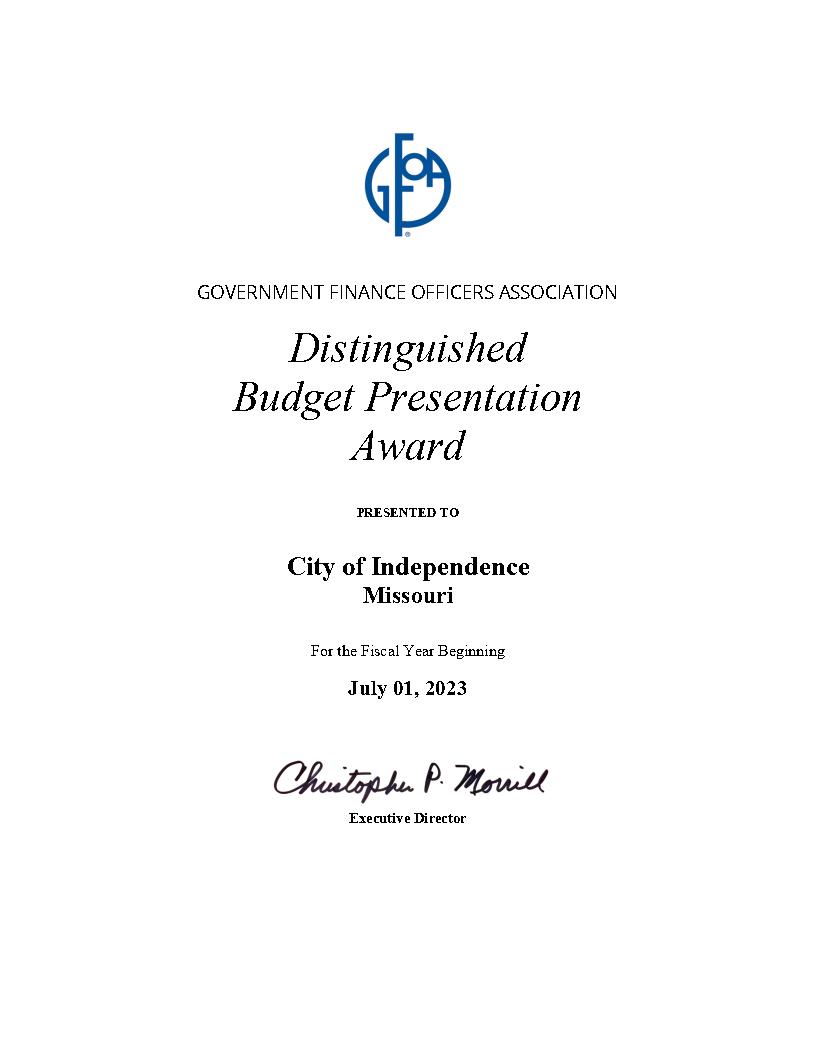
TheGovernmentFinanceOfficersAssociationoftheUnitedStatesandCanada(GFOA)presenteda DistinguishedBudgetPresentationAwardtotheCityofIndependencefortheannualbudgetbeginning July2023.Inordertoreceivethisaward,agovernmentalunitmustpublishabudgetdocumentthat meets program criteria as a policy document, an operations guide, a financial plan, and a communicationdevice.
Thisawardisvalidforaperiodofoneyearonly.Webelieveourcurrentbudgetcontinuestoconform toprogramrequirements,andwearesubmittingittoGFOAtodetermineitseligibilityforanother award.



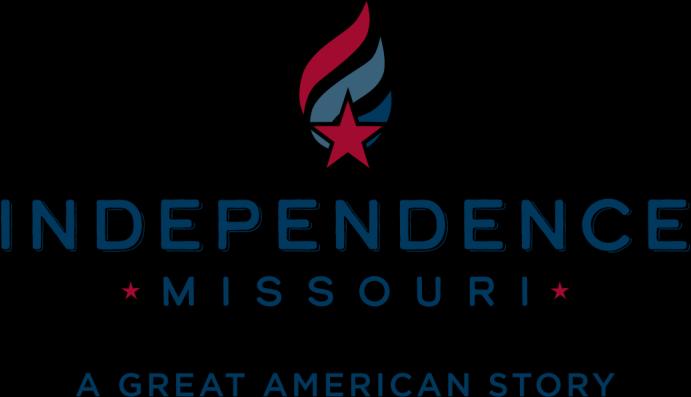
May 13, 2024
Honorable Mayor and Members of the City Council:
In February 2023, the City Council adopted the Independence Action Plan, setting forth a bold vision for Independence as a safe community with a thriving economy and a high quality of life through six strategic imperatives:
Purpose Statements
• An Engaged Community. We foster a culture of engagement and civic leadership based on innovation and best practices involving community members of all backgrounds and perspectives.
• An Innovative Economy. We grow a diversified and innovative economy leveraging our community amenities, skilled and creative people, and educational resources to generate economic opportunities.
• A Safe, Welcoming Community. We embrace a safe, healthy, welcoming, and inclusive community.
• A Well-Planned City. We consistently improve our community’s appearance and quality of life as it grows and changes, honoring our unique history and sense of place as we plan for a livable, affordable, more connected city.
• A Financially Sustainable Organization. We create long-term financial stability by using equitable and sustainable sources of funding for City services, and we deliver them in a lean and efficient manner.
• A High-Performance Organization. We operate as an ethical, high-performance organization anticipating future needs, utilizing best practices, and striving for continuous improvement.
One year later, I am pleased to share that the strategies behind the Independence Action Plan are effective. The completion of the City’s first Tourism Master Plan, the development of the Fire Department’s Community Risk Assessment to guide the remodeling or reconstructing our fire stations, and a $12 million investment in police technologies-including the long-desired implementation of body worn cameras-demonstrate the kind of progress that can be made when our governing body establishes a clear vision, our highly-skilled staff is empowered to implement this vision, and our community rallies to support these initiatives. Case in point:


• The City supported Community Services League and Good Shepard Community of Christ in creating a drop-in center. A drop-in center welcomes persons living without a permanent home. Services include laundry, meals, and showering capabilities along with mental and physical health services, dental and vision programs, and a variety of other opportunities.
• The City continues to partner with Comprehensive Mental Health Services to embed mental health clinicians within the police department to respond with law enforcement on calls for service. The Mid-America Regional Council administers federal grants to sustain this program. In the most recent quarter, 127 people were assessed by a mental health co-responder. A third of those encounters were resolved on scene, and all assessments resulted in referrals for behavioral health services. Only 8 encounters (6%) supported by a co-responder resulted in arrest. Our CIT Coordinator also responded on 97 follow up visits with the Community Behavior Health Liaison, ensuring ongoing care is provided.
• The City’s Alternative Response for Community Health (ARCH) places staff alongside 911 services to provide focused and immediate resources to those dealing with challenges such as houselessness, chronic medical/financial/and substance use issues, and other quality of life concerns. Most recently, the City executed a Memorandum of Understanding with the Heartland Center for Behavioral Care, adding Community Health Specialists to the ARCH team for emergency mental health services regarding all manner of quality-of-life concerns. On average, ARCH is responding or involved with a community member at least once every 90 minutes while on-duty.
• The City continues to demonstrate sound financial management. The total number of TIF projects has been reduced by 44%, dropping from 18 to 10, including 8 in the last 5 years alone. TIF Debt has been reduced by over $82 million, a 33% decrease. All General Fund subsidies for TIF projects have also been eliminated Citywide, debt service as a percentage of spending has been reduced by over 50%.
• General Fund reserves continue to grow. Ten years ago, the City had $3.7 million in General Fund reserves, or about 5%. For Fiscal Year 2023-24, we’re on track to finish with $11.7 million in General Fund Unreserved Fund Balance, or about 14.3%.
• The City has seen an annual growth rate of 3.1% in the economy through December 2023. The use tax continues to experience significant growth, with a year-to-date increase of 48.4% over this time last year. It is estimated that in the first full 12 months of collections, the City will receive approximately $1 million annually in the Marijuana Sales Tax Fund.
• We are growing our revenues through meaningful economic development. Applications for new business licenses as well as renewals of existing business licenses increased in 2023.
• The City realized a 66% increase in permits for new single family home construction in 2023. Two new multi-family housing projects gained City Council approval in 2023. There are now 1,243 Class A, market-rate apartments either newly finished or set for construction in Independence. This growth isn’t just limited to market-rate housing, though. In June 2022, the City implemented a temporary building permit fee waiver program with the goal of encouraging infill single family residential construction and substantial rehabilitation of single family homes. Since the launch of this program, 13 new infill single family homes have been constructed. Additionally, private reinvestment has included $30 million in improvements to the Hawthorne Place apartments, and $4.4 million for improvements to the Cimmaron
apartments. Both apartment complexes offer affordable housing to residents, demonstrating that all housing types and income levels are welcome in Independence.
• The first two facilities have opened in Eastgate Commerce Center, providing nearly 600,000 in industrial space. Cargo Largo opened its 500,000 sq. ft. facility and now employs 500 people. This is a $65 million capital investment in our community.
• The Hub Shopping Center located at the southwest corner of 23rd Street and Hub Drive near 291 Hwy was approved for a $36 million redevelopment project aimed at modernizing the grocery-anchored shopping center for continued use for retail and other commercial purposes.
• Nearly two-thirds of the City’s dangerous building cases are in the process of being resolved. I commend our staff for the improvements they have implemented to expedite the amount of time a case remains open.
• In 2023, the total number of property maintenance complaints initiated by citizens declined by nearly 25%, demonstrating a higher degree of proactive code enforcement by the City Moreover, the City ordered more abatements in 2023 (779) than 2022 (625), allowing us to enhance the quality of life our community members desire.
• The Rock Creek Wastewater Treatment Plant was selected as the MWEA Wastewater Treatment Plant of the Year.
• 50.83 miles of roadway were addressed through the preventive street maintenance program.
• The Police Department completed acquisition of critical technology and equipment assets, including the purchase of the Mobile Command Post and body-worn cameras.
• The Fire Department completed development of a new strategic plan that includes both short and long-term goals for the department based off of analyzed data.
As a result of steadfast and disciplined leadership by the City Council and the dedicated service of City staff, we find ourselves in an improved position from years past. We stand at the crossroads of a monumental moment in our city’s history as the City Council and community members contemplate generational issues such as proposed amendments to the City Charter, a General Obligation bond issue to begin addressing the City’s $1 billion deferred maintenance backlog, and the future ownership and governance of Independence Power & Light. Each of these issues fall flat, however, if the City is financially unstable and unable to provide superior basic service delivery. The Submitted Budget for Fiscal Year 2024-2025 builds on the corrective actions taken in previous fiscal years and continues to stabilize services and operations following years of budgetary delay and deferral
Through thoughtful and deliberate decision-making, the critical input of my Leadership Team, and with the City Council’s priorities as the guiding light, I am pleased to present the submitted budget for Fiscal Year 2024-2025 in accordance with Section 8.2 of the City Charter. The proposed budget totals $413,201,019, or an increase of $18,068,291, or approximately 4.6%.
In March 2024, City Council was presented with the General Fund Five-Year Forecast, followed by a presentation outlining the fiscal pressures the City is facing both near- and long-term. Both presentations provided the same outlook – revenue growth is outpaced by various areas of


expenditure growth, including salaries and benefits and inflationary costs to materials and operating supplies. Additionally, federal subsidies that have aided in funding of the City’s transit program since the beginning of the pandemic have now expired. As a result, the FY2024-25 budget included a gap of approximately $1.2 million for this program.
One of the most adverse impacts this shortfall will have is on the City’s General Fund reserve balance. City Council Resolution 17-729 established a policy that the City will endeavor to maintain a minimum Unrestricted and Unassigned Fund Balance in the General Fund equal to 16% of annual operating expenditures, or approximately $12.9 million. The 2023-24 fiscal year is projected to end at a 14.3% reserve and although this is a significant improvement to the City’s overall financial position, the increase is not structural in nature as it reflects savings primarily from personnel vacancies and other one-time revenues.
As the charts below indicate, expenditure growth is outpacing revenue growth. This structural imbalance leaves a projected ending fund balance of ($20M) by FY 28-29. This is not a sustainable trend as it does not provide the City with sufficient resources to navigate any further economic disruptions or the flexibility to capitalize on opportunities, invest strategically, or provide service enhancements within the financial plan period.
Fund Balance versus Policy (16% of expenditures)
$6,591,442 $5,700,364 $10,185,654 $11,656,543 $6,456,707 $845,453 $9,768,622 $20,316,424
(25,000,000) (20,000,000) (15,000,000) (10,000,000) (5,000,000) 0 5,000,000 10,000,000 15,000,000 0 20,000,000 40,000,000 60,000,000 80,000,000
For the past seven years, my focus has been prioritizing services, managing expenditures, driving efficiency, and executing objectives that address the ongoing structural imbalance that has negatively impacted the City’s financial position and service delivery for many years. This required the collaboration and support of the City Council, City leaders, bargaining units, and other stakeholders. This year, the City began utilizing Priority Based Budgeting to address the structural issues through the reallocation of existing resources in the absence of new revenue streams. Through this process, departments identified the programs and services they are providing to the citizens of Independence, developed a cost for each program and then rated it against the Action Plan identified by City Council.
Continued stabilization of the City’s fiscal condition will require additional efforts to critically examine and prioritize services, evaluate revenue options, as well as focus on attracting capital investment and other initiatives that contribute to the economic expansion of Independence.
The Assessed Value chart below shows a history of slow growth in the assessed valuation of real estate and railroads/utilities within the city. However, there was significant growth projected in the 2022 valuations of about 7%. The marked increase in assessed value is largely driven by a strong housing market plus delayed increases due to the pandemic.
Total revenues for the General Fund in the Fiscal Year 2024-25 Budget are $83,318,302 which is a yearover-year increase of $5.2M from 2023-24 Budgeted Revenues and a5.7% increase from FY 2022-23 Actuals. The increase over FY 2023-24 is primarily due to growth in property tax, use tax receipts, retail sales tax receipts (including voter authorized sale tax increases). Revenue sources and performance over the previous two years is outlined in the table below:
Total expenditures for the General Fund are $83,318,302, including a contingency of $603,626. This represents an increase of 1.6% from 2023-24


• Address a structural imbalance in the General Fund of approximately $4.3 million. This reflects the shortfall between forecasted revenues for Fiscal Year 2024-25 and projected expenditures for the same period to simply sustain current service delivery levels. Given our meager staffing levels and operating budgets for these basic services, it was imperative that I address this structural imbalance in a manner that did not further reduce current operations.
• Allocate funding to provide a 2% across-the-board wage increase for all non-represented employees in the General Fund and adequately budget for all contractually obligated wage increases for represented employees. Of particular importance was identifying funding capacity to negotiate fair, sustainable wages with the Fraternal Order of Police Lodge 1 and the International Brotherhood of Electrical Workers (Maintenance & Clerical) Local 53, both of which have collective bargaining agreements that expire in 2024.
• Accurately budget for Fire Department overtime and other pays (including Fire Standby pay). Last year's budget allocated $826,800 toward this expenditure, of which $400,000 was budgeted for overtime. Instead, the Fire Department is projected to exceed budgeted overtime expenses by over double ($883,000) and other pays by $2 million for Fiscal Year 2023-24. In recent years, additional personnel were added with the intention of minimizing overtime expenses. That has not proven to be an effective strategy. As such, I am recommending a budget that accurately reflects the true cost of this service by allocating $2.4 million for these expenses.
• Account for the loss of federal funds subsidizing public transportation. Fiscal Year 2023-24 represented the final year of American Rescue Plan Act (ARPA) revenue supporting the operating budget, which totaled approximately $1.3 million. The Fiscal Year 2023-24 budget allocated $1,328,690 in the General Fund for transit while the Fiscal Year 2024-25 budget contains a proposed allocation of $1,334,460. Given the loss of the federal funds and the inability to increase General Fund appropriations for this service, City staff are working closely with the Kansas City Area Transportation Authority to evaluate options for revising fixed route services to match available resources.
The graph below is a visual representation of how each dollar is spent between city departments in the General Fund:

While the Proposed Budget is balanced as required by State Law, I must reiterate that there is no builtin capacity for expansion. As such, any enhancements by the City Council during your budgetary deliberations will require corresponding reductions in expenditures as an offset. Better than forecasted revenue growth in some areas has relieved some of the financial issues at the initial planning stages of the budget, however long-term fiscal sustainability is still an area of primary concern.
As I cautioned in the previous two years’ budget messages, without further structural reductions in operating expenses or an infusion of new revenues, the financial constraints experienced each year will continue to manifest and limit service delivery. Such options include:
• Make strategic changes to legacy expenditures that are growing at unsustainable rates, such as health benefits and overtime practices.
• Attract and retain industry that meets market demand and provides employment opportunities for Independence residents.
• Reallocate current resources (both people and dollars) to higher performing programs that align more closely to the strategic plan and community needs.
• Capitalize on opportunities to enhance revenue:
• Economic development and capital investment
• Regional events (one-time)
• New revenue sources
Well over a dozen different strategies were contemplated for balancing the General Fund budget for Fiscal Year 2024-25. After careful consideration, I recommend the following changes of note:


• A Reduction in Force of one filled position and two vacant positions in the Finance Department and three filled positions in the City Communications Division of the City Manager’s Office. Several additional positions in both departments will be backfilled at a lower annual expense. Cumulatively, this represents a savings of $330,584 in the General Fund and $512,500 across all funds. These changes have been implemented.
• A Reduction in Force of two filled, non-represented positions in the Fire Department, resulting in a savings of $138,585.
• Increased revenue totaling $341,55 through adjustments to the City’s Fee Schedule, including updates to business license fees, building permit fees, and various Health and Animal Services Department fees. The submitted budget also recommends the elimination of the waiver for inspecting cafeterias at schools in the Independence School District, valued at $25,000.
• Redirected cost allocations from the General Fund totaling $3,245,791. This includes continuing to manage Fire Department personnel costs through the support of the expanded Fire Sales Tax in the amount of $2,746,271. This also includes allocating $499,520 in General Fund personnel expenses in the Municipal Services Department to various sales tax and enterprise funds consistent with the allocation of an employee’s time and nature of their work. Both measures represent a short-term savings and not structural in nature.
• Elimination of Open-Access Plan 1 for all active employees from the City’s self-funded health insurance plan. As the City’s health insurance plan year begins January 1, this recommendation will only yield six months of savings for Fiscal Year 2024-25. Therefore, the submitted budget anticipates a savings of $685,000 in the General Fund and another $600,000 citywide. In future years, it is expected that this recommendation will save $1.37 million in the General Fund and $1.2 million citywide. It should be noted that the City will continue to offer three different health insurance options. It should also be noted that as public servants, we serve a community where 16% of our residents under age 65 do not have any health insurance.
• Streamlining and/or eliminating redundant software platforms saving $110,000, of which $20,200 is from the General Fund.
• Hiring “chill” on vacant positions in the General Fund total $3,325,344. I have instructed my Leadership Team that positions may be filled with a budget analysis and City Manager approval.
The net savings from these recommendations is $601,741 including my recommendation to fund just $64,400 of the $1,258,478 in new spending requests:
• $25,400 for salary increases for four Municipal Court Clerks;
• $25,000 for the General Fund portion of the City’s lobbying services contract;
• $10,000 for document shredding in compliance with Missouri State law; and,
• $4,000 for a new computer in the Emergency Preparedness Division.

As I’ve previously noted, there is tremendous economic progress occurring in our community that will provide much needed revenue growth for our City. However, it will take time for these projects to fully bear fruit, and even then, these projects alone will not eradicate the intergenerational poverty that plagues far too many in our community. U.S. Census Data estimates for Independence between 2018 and 2022 show that per capita income is less than $32,000 and that 15% of our residents live in poverty. As I’ve stated many times prior, we cannot cut our way to prosperity, but we also cannot expect a population with our socioeconomic demographics to sustain our level of expenditures without corresponding revenue growth. As employees of the City of Independence, we must realize that we are fortunate to have a salary and benefit package that far exceeds the total household income of more than one-third of our citizens. We must remain cognizant of our need to provide a competitive salary and benefit plan while maximizing the value of services our citizens underwrite. Reducing City services at the expense of propping up an extraordinary benefits plan is not a model I can recommend as your City Manager, particularly given the threadbare margin by which we already operate.



Following the reorganization and restructuring of the Independence Health Department in 2018, the City Council directed City staff in late 2020 to pursue recognition from the State of Missouri as a Local Public Health Agency (LPHA). Recognition was received from the State in early 2021, and this budget provides continued funding to provide baseline public health services. The department provides a variety of services, including the following major accomplishments from Fiscal Year 2023-24:
• Conducted 1,088 permitted health inspections.
• Responded to 4,807 animal control calls.
• Took in 1,948 animals at the Regional Animal Shelter, with a live release rate of 95.1%.
• Administered over 120 COVID vaccine doses.
• Supported the Alternative Response to Community Health (ARCH) program in providing 176 transports, saving citizens $166,000 and releasing/canceling 703 emergency units from service.
Revenues for the department remain flat while expenditures (especially personnel costs) continue to rise The department relies heavily on federal and state grants as well as support of animal shelter functions from the community. The department received over $1 million in grant funding in FY 202324.
In addition to the General Fund, the Independence Parks, Recreation and Tourism Department (PRT) is supported by several revenue streams.
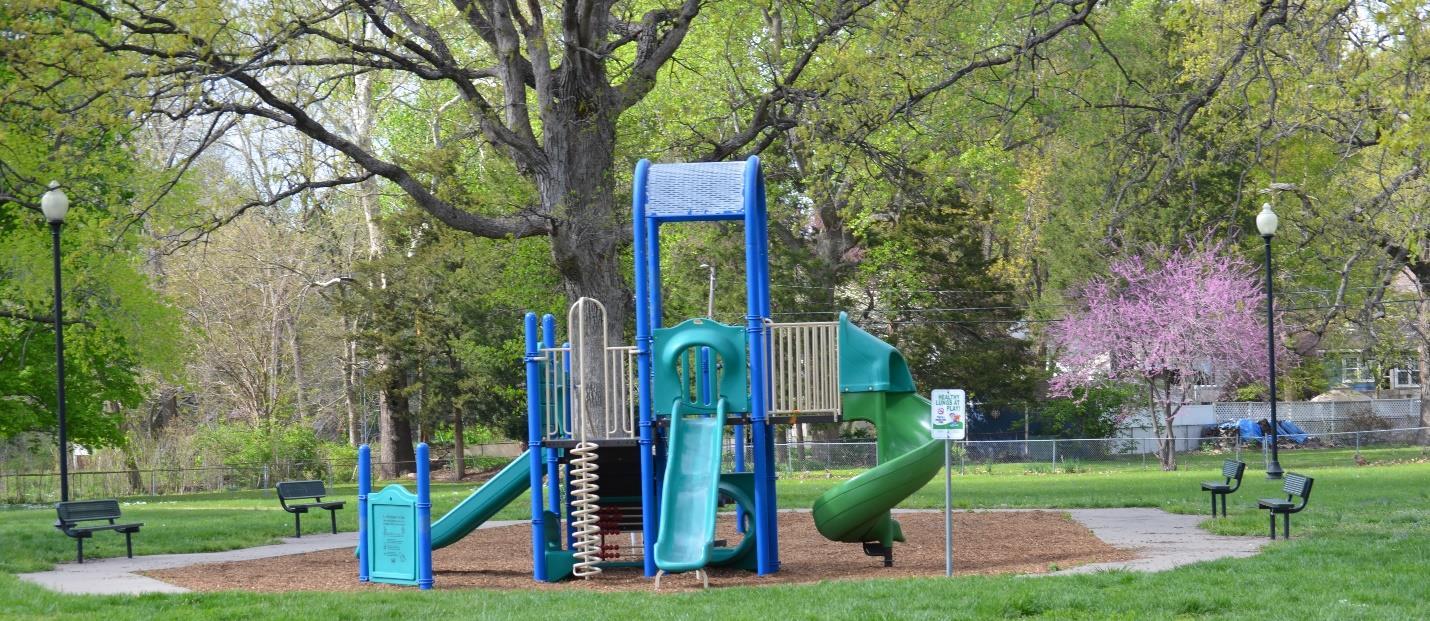
• Tourism Fund – collected on the charges for transient guests of hotels, motels, bed and breakfast inns, campgrounds, and short-term rentals.
The department achieved several notable achievements in FY 2023-24, including:
• Completing the Tourism and Museum Master Plan.
• Initiating the centralization of facilities and grounds maintenance for to achieve greater operating efficiencies and improved service delivery.
• Coordinated with various City departments and community partners to address 21 homeless camps located on Park property.
As the parks funds are special revenues, the City’s policy is for each fund to meet a reserve requirement between 5-16% of revenues. As of the 2024-25 budget, the Tourism, Parks Improvement Sales Tax and Parks & Recreation Levy are projected to meet a 16% reserve. Like the General Fund, PRT funds are facing a structural imbalance that impedes the long-term fiscal sustainability of current levels of operation and service.
Current operating costs are not sustainable given increasing internal service costs, higher personnel service costs, and inflationary expenditure costs. To compensate for these increasing costs, the department is implementing a Reduction in Force impacting 8.7 full-time equivalent positions, or 10.3% of the total PRT staff. Current capital project costs for the Park Improvement Sales Tax Fund and the Tourism Fund are also not sustainable for the long term. Additional revenue streams are needed.
Despite these challenges, the submitted budget contemplates several program enhancements for the department to meet the needs and expectations of the community. These include:


• Restructuring the Recreation Division to emphasize programming rather than facilities.
• Addition of 1.3 FTE Seasonal Recreation Worker and 2 FTE Seasonal Maintenance Worker positions from April through October to address park maintenance needs.
• Structured the submitted budget to reflect the option of Tourism being separated from the Parks & Recreation Department. Tourism includes the operation and maintenance of historic sites, museum, Truman Memorial Building, Main Street 1849, marketing, and visitor’s guide production. As this was our first year utilizing Priority Based Budgeting, I will note that historic sites rated as the most expensive and least aligned operation with the Parks & Recreation Department.
Over the next three years, I will be working with the City Council and the Parks/Recreation/Tourism Department to develop and implement a new vision for this department. Such items may include:
• Reviewing Park property to determine underutilized locations for surplus.
• Implementing revised hours and programming for Recreation to focus on youth activities and more weekend events, activities, and programs.
• Investigate new recreation software programs for enhanced customer service.
Pursue accreditation as a Park and Recreation Agency through the National Recreation and Parks Association.
Estimated revenues in the Fiscal Year 2024-25 Proposed Budget from the Use Tax are outlined in the table below. Voters approved amended Use-Tax ballot language in November 2021 to support expanded applications of the Use Tax. FY 2024-25 Budgeted amounts are based on a 2% growth over FY 2023-24 projected amounts. Per the ordinance language, both the Animal Shelter and Police will see a growth rate of 4.4% based on the Consumer Price Index.
In addition to the Use Tax, the City of Independence administers five additional voter-approved sales taxes. Like all City funds, these continue to experience pressure of increasing costs to support their intended uses against limited growth. The only exception to this is the Fire Public Safety Sales Tax which received voter approved expansion in November 2021.
• Fire Public Sales Tax Changes: $5,450,000 for Capital Projects
• $2,750,000 for Architectural Design Fees for new station construction
• $300,000 for Parking Area Addition
• $1,050,000 for a new pumper
• $1,350,000 for new aerial ladder truck
• Police Public Safety Sales Tax Changes and Use Tax Changes:
• $550,000 in Capital Projects for the purchase of a new Bearcat vehicle

• $1.2M for Axon contract for body cameras and other equipment and software


The submitted budget does not forecast significant revenue growth in the enterprise funds which is a result of limited economic expansion, flat consumption, and fixed utility rates.
Highlights in the Budget for the Enterprise Funds include:
• Municipal Services:
• Incorporation of Water operations into Municipal Services.
• Transition of Facilities Maintenance to the Parks/Recreation/Tourism Department
• $33,473,103 in Capital Improvements, including:
• $260,000 for the General Fund portion of the Spring Branch Garage Complex.
• $7,380,915 in Street Improvements Sales Tax projects.
• $3,364,171 in grant-funded projects.
• $7,583,017 in Stormwater Sales Tax projects.
• $5,505,000 in Sewer projects.
• $9,380,000 in Water projects.
• Personnel Additions:
• Pipe Worker (Water Fund), 2.0
• Power & Light
• Elimination of the 6% Rate Reduction as recommended by the Public Utilities Advisory Board was approved in FY 2023, FY 2024-25 will be the first full year of the elimination of the reduction.
• Expanding transmission and distribution capabilities to support growth on the east side of town.
• Personnel Additions:
• Engineering Supervisor, 1.0
• System Operator Trainee, 1.0
As this budget is being submitted for City Council consideration, our City is in the midst of some of the most decisive years it has faced in its long history After 50 years of planned growth, the Little Blue Valley is finally realizing the development that has been long anticipated. New and varied housing stock is being added to our community while underutilized spaces are being primed for redevelopment. Pending decisions on transformational issues like amending the City Charter, seeking a multi-million-dollar General Obligation Bond, and future governance of Independence Power & Light have the capacity to further enhance the delivery of basic services and enhance the quality of life for our community members.
Yet, the City of Independence has a series of underlying issues that threaten our financial stability, and these promising developments will not deliver on their potential without solidifying our financial position. The City has had many hard conversations and taken equally hard steps each of the last eight years to bolster our fiscal health, but more work remains to be done. Deliberate and thoughtful dialogue must continue to be had about what programs and services our community values most. A budget is, after all, a statement of values.
I want to thank you, the City Council, and the City departments for the assistance provided in preparing this budget. I also wish to thank all our City staff who serve our community. They do so with the utmost professionalism and commitment in a highly challenging environment.
The options presented as a part of this budget are not easy choices; my staff and I are ready to address any questions regarding the information presented.
Respectfully,

Zachary C. Walker City Manager

In 1961, Independence voters selected a council-manager form of government. Under Charter Article 2.1, this form of government calls for one mayor and two council members elected by the city, and four council members elected by districts. The mayor and all city council members are elected to staggered four-year terms. The governing body is generally referred to as the “City Council.” As the policy makers, the City Council passes resolutions and ordinances, adopts the city budget, appoints citizens to advisory boards and hires the city manager.










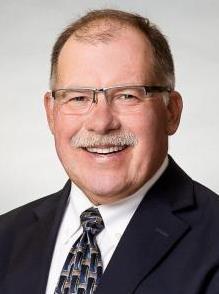









The purpose of this budget document is to provide a comprehensive view of the operating budget. The budget is a tool for management to plan services, but it is also a communication to the public on the overall financial and policy direction of the city. Use this guide to navigate the document.
The City Manager’s Budget Message provides the framework for how the budget was developed, including contextual information on the city’s finances, economic trends, and changes to the budget.
Introduction
This section provides general information about the city:
• Names and photos of Mayor and City Council
• City of Independence overview and history
Fund Summaries
This section of the book gives the highest-level overview of the fund structure of the city.
• The breakdown of expenditure types across all funds
• The breakdown of revenue types across all funds
• Fund summaries for each fund, which show how the expenditures relate to the revenues.
Department Summaries
This section contains summary and detail information about each city department:
• Organizational chart shows the director and divisions of each department.
• Department summary page highlights the mission of the department, the budgetary funds that make up the budget, a summary of expenditures, and total budgets and FTE counts.
• The department is then broken down further into divisions (for instance, the Patrol Division of the Police department). The top half of the page will show summary information about the types of expenditures in that division, as well as the funding source and FTE counts.
Appendix
The appendix includes miscellaneous information that may help further understanding of the budget, including:
• Approved packages included in the budget.
• Capital Outlay details by department.
• ARPA summary
• Glossary of budget and finance terms
Development of the annual City budget is a year-long process that culminates in June, with the formal adoption of the budget.
1. Finance develops the 2025 budget manual.
2. Finance meets to resolve issues and prepare budget outlook.
1. Finance meets with departments to kickoff budget process.
2. Updated Five Year Forecast presented to City Council.
3. Finance prepares the base budget, chargebacks, and preliminary personnel budgets.
4. Revenue projections and estimated actual expenses for prior year are prepared.
5. Capital Improvement Program budget presented by Economic Development to the Planning Commission.
1. City Council adopts annual Strategic Plan update.
2. In conjunction with the Finance, departments and divisions prepare budget proposals.
3. Capital Improvement Program memo with recommendations issued from Planning Commission.
4. Departments Directors present budgets and package requests to the City Manager.
5. Final adjustments in revenue and expenditure estimates are complete.
6. City Manager reviews recommended budget and gives preliminary approval on budget changes to be included in Proposed Budget.
7. Finance prepares Proposed Budget document.
1. City Manager Proposed Budget submitted to the City Council.
2. City Council makes policy decisions and budgetary amendments to the Proposed Budget.
1. First reading of appropriation ordinances held adopting budget.
2. City Council proposes / amends budget per policy decisions.
3. Second reading of appropriation ordinances held adopting budget.
4. Finance begins production of final budget document.
1. Assessed valuation received from Jackson and Clay Counties to set Property Tax Levy Rates.
2. Public hearing to set Property Tax Levy held.
3. Second reading of appropriation ordinances held adopting the annual tax levy.
4. Tax levy rates submitted to Jackson and Clay Counties.
5. Adopted budget book printed and published online.
6. First quarter budget amendment prepared for City Council approval.


Personnel Allocations and Overtime Budgets sent to departments Friday, December 15, 2023
CIP Kickoff Meetings December 18-26, 2023
CIP updates and new projects entered Friday, January 12, 2024
Budget Kickoff Meeting Wednesday, January 10, 2024
Personnel Allocation Changes Due Tuesday, January 09, 2024
Overtime Budget Changes Due Wednesday, January 17, 2024
Mid-Year Financial Status / 5 Year Forecast Update at Study Session Monday, February 12, 2024
Internal Service Charges due (Central Garage, Tech Services, WC, Risk) Wednesday, February 1, 2024
Personnel Posted to Munis for department review
Wednesday, February 1, 2024
Finance set items and internal charges are loaded Monday, February 12, 2024
Munis is open for budget entry
Due from departments:
- Proposed department budgets and package requests
- CIP for the fiscal year
- Revenues
- Estimated Actual Expenditures
- Personnel corrections / adjustments
- Capital Outlay List
Review of department budget submissions
City Manager meets with departments to review proposed budgets
Wednesday, March 06, 2024
March 8 - March 31, 2024
March 9 - March 29, 2024
CIP Presented to Planning Commission Tuesday, March 12, 2024
CIP Report Presentation at Study Session Monday, April 8, 2024
Financial Update at Study Session Monday, April 8, 2024
City Manager approves recommended changes for proposed budget, packages posted, and departments notified Monday, April 8, 2024
Department summary pages and org charts due Friday, April 12, 2024
Fee Changes are due from departments Wednesday, May 1, 2024
City Manager Proposed Budget submitted to the City Council Monday, May 13, 2024
Public Hearing held for Proposed Budget Monday, May 20, 2024
First Reading of Proposed Budget Monday, June 3, 2024
Second Reading of Proposed Budget Monday, June 17, 2024
Independence is the fifth largest city in Missouri, located within Jackson County. It is the largest suburb of the Kansas City metropolitan area on the Missouri side. Located ten miles east of Kansas City, Missouri in the geographical center of the United States. Independence has a Mayor/City Council/City Manager form of government. The Independence City Council is made up of six members, four are elected to represent one of the city districts, the other two are elected by the city. The mayor also sits on the City Council and serves as the “Head of Government” for the city. Members serve a four-year term, beginning January 1 following the election.
Many towns and cities have stories that have been passed down from generation to generation. The rare few have stories of such historic proportions that they become the stuff of legends. Rarer still are the cities whose “Once upon a time” is tied to the opening chapters of so many American lives. Independence, Missouri is a city unlike any other. It is where 400,000 fearless souls set off on a new venture that would not only alter the course of their lives, but the trajectory of an entire country. It is a city so visionary, selfdetermined and free-spirited, that it became the jumping off point to a whole new world.

Independence was originally inhabited by the Missouri and Osage Indians and became part of the United States with the Louisiana Purchase in 1803. It was the farthest point westward on the Missouri River where steamboats or cargo vessels could travel. The city quickly became the hub of the California Trail, Santa Fe Trail, and the Oregon Trail. Independence was soon known as the Queen of the Trails, due to is unique location where all three trails converged. It wasn’t until the 19th century that Independence was defined by The United States Congress as the “Start of the Oregon Trail.” In 1826, Independence was named the county seat of Jackson County. During the years of 1862 and 1864 the First and Second battles of Independence were fought.
It’s not surprising then that 100 years later, the 33rd President of the United States should also find his roots and jumping off point in Independence. In his own pioneering way, Harry S. Truman helped write a big part of our country’s history. And as a great American himself, shape its ideals and role in the world. After his two terms, President Truman returned to Independence, where the Presidential Library was built in 1957. For another two decades, he and his wife Bess remained Independence residents. The Harry S. Truman National Historic Site and the Harry S. Truman Presidential Library and Museum are both located in Independence.

From the strength and fortitude of its earlies trailblazers to the straight-talking, pragmatism of Harry S. Truman, Independence has provided the country just what it needed at the time. And the city continues its role as a launching pad for brave new ideas and future growth. Nowhere is that more evident than in places like the Ennovation Center, an entrepreneurial incubator where

a fiercely independent and creative work ethic is blazing new trails in industries from business technology and healthcare to food services and bringing a whole new generation of innovators to the area.
Independence is positioned strategically at the crossroads of I-70 and I-470, where approximately 150,000 cars pass each day. The Kansas City metropolitan area has more lane miles of freeway per capita than any other metro area in the United States. Two rail lines, three interstates and five state highways serve Independence. The city is located just 25 minutes from Kansas City International Airport.
Population: 120,931
Square Miles: 78.00
Number of Households: 51,311
Average Household Size: 2.3
Median value of owner-occupied units: $180,700
School Enrollment: 23,928
Miles of highways: 46.38
Sister City: Higashimurayama, Tokyo, Japan
Source:CityofIndependenceandCensusreporter.org
Independence has seven police stations, ten fire stations, and the city provides Water, Sanitary Sewer, and Power and Light utilities, with three power stations.
The development of the Little Blue Parkway, a new thoroughfare connecting the eastern portion of the City from I-70 to 24 Highway will open 38 miles of land for development. It is estimated that by the year 2020, the Little Blue Valley will be home to an additional 20,000 people and 5,000 new office, industrial and retail jobs.
In the heart of the city, Historic Independence Square is undergoing a renaissance with substantial increase in private investment and a planned restoration of the Historic Jackson County Courthouse. The traditional town square offers unique shops, restaurants, loft-style apartments and a newly renovated cinema and bowling alley.
Creating the educated workforce of the future is a priority for the Independence Community. The city is supported by four award-winning public-school districts: Independence, Blue Springs, Fort Osage, and Raytown school districts. Independence is home to four colleges to support the higher education needs of our citizens, including Metropolitan Community College, Graceland University, Park University, and National American University.

Independence has a history of a pro-business attitude. Its low-cost environment is a natural incentive to companies looking to expand or relocate. Independence has the third lowest property tax rate in the Kansas City Metropolitan Area. Additionally, the City does not tax on personal property, including machinery and equipment. The city tax structure coupled with the many affordable housing options makes it the best value in the Metro for working and living.

Per capita personal income, Missouri Adjusted Gross Income per return data for the city, County, and State are presented in the following table:
The population trends for the city, county, and state are shown in the table below:
Source for income and population data: City of Independence, Jackson County, State of Missouri.

The major employers in the city by number of employees (full and part time) for 2022.

The table below shows the city's ten largest taxpayers for 2023, the total assessed valuation for the city was $1,788,344,428
Source: Jackson County Collection Department

Summary
Each year, Independence City Council holds a strategic planning session to identify the main areas of focus for the City Council over the next year. Following the strategic planning session, each member of the City Council completed a survey to confirm the primary issues identified by the Council at the strategic planning session.
Background
The Charter of the City of Independence, Section 1.2, empowers the City Council to determine the policies of the City of Independence. The Council established a vision statement and strategic goals by the passage of Resolution No. 4017 on June 6, 1994, amended the strategic goals by Resolution No. 4937 on October 31, 2002; amended the strategic goals by Resolution No. 5879 on January 6, 2014; adopted a new strategic plan, Independence for All 2017-2021, by Resolution NO. 6186 on February 6, 207; and amended the strategic plan, Independence for All 2022-2026, by Resolution No., 6647 on March 1st, 2022.
The Independence City Council wished to develop the newest set of strategic priorities to guide future policy and funding decisions. Considerable effort has been made to develop a strategic plan that includes a purpose, purpose statements, and action items that are based on input from a wide crosssection of the community. The Council adopted the newest plan by Resolution No. 6902 on February 20, 2023.
Purpose and Purpose Statements
Independence is a safe, inclusive community fostering civic engagement and creativity, with a thriving and diversified economy, a strong and proud history, and a high quality of life as our community grows and adapts.
Purpose Statements
1. An Engaged Community. We foster a culture of engagement and civic leadership based on innovation and best practices involving community members of all backgrounds and perspectives.
2. An Innovative Economy. We grow a diversified and innovative economy leveraging our community amenities, skilled and creative people, and educational resources to generate economic opportunities.
3. A Safe, Welcoming Community. We embrace a safe, healthy, welcoming, and inclusive community.
4. A Well-Planned City. We consistently improve our community’s appearance and quality of life as it grows and changes, honoring our unique history and sense of place as we plan for a livable, affordable, more connected city.
5. A Financially Sustainable Organization. We create long-term financial stability by using equitable and sustainable sources of funding for City services, and we deliver them in a

lean and efficient manner.
6. A High-Performance Organization. We operate as an ethical, high performance organization anticipating future needs, utilizing best practices, and striving for continuous improvement.
Wefosteracultureofengagementandcivicleadershipbasedoninnovationandbestpractices involvingcommunitymembersofallbackgroundsandperspectives.
1.1 Outreach - Continue to strengthen and innovate in how we deliver information to the community and our partners.
a.) City Communication Plan and Protocol. Update, implement, and train for a City-wide communications protocol and outreach plan.
b.) Communicate more effectively internally and externally. Continue to enhance the City’s primary public information tools: City 7, website, newsletters, social media.
c.) Complete an Audio/Visual Needs Assessment for City Facilities and Implement Upgrades to Meet Current and Future Needs.
d.) Automate Systems for Fulfillment of Records Requests.
1.2 Community Engagement - Broaden and deepen engagement of the community in city government, innovating methods for inviting input from the community and stakeholders.
a.) Enhance City Committees and Advisory Boards. Restructure or combine City boards and committees to more effectively advise the city and engage the public.
b.) Community Engagement Plan. Develop a plan to increase community engagement in city decision-making processes.
c.) Create a Standard City Council, Boards, and Commissions Onboarding and Education Process. Increase education for City Council, commissions, boards, and advisory boards.
d.) City Charter Review. Complete the review of the City Charter by the Charter Review Commission and seek voter approval of proposed changes to reflect best practices.
1.3 Public Agencies Collaboration - Foster successful collaboration with other public agencies and build on these successes.
a.) Quarterly City/County Meetings. Establish regularly scheduled meetings between the City of Independence and the Jackson County Legislature to discuss issues of mutual interest.
b.) Continue the City’s Participation in the Eastern Jackson County Shared Services Initiative and Other Regional Collaborations through the Mid-America Regional Council.


c.) Enhance the City’s relationship with the Independence, Fort Osage, Blue Springs, and Raytown School Districts.
d.) Enhance the City’s relationship with Blue River Community College.
e.) Enhance the City’s relationship with the Mid-Continent Public Library.
f.) Enhance the City’s relationship with State and Federal Agencies.
g.) Develop and support a legislative agenda.
1.4 Business and Institutional Partnerships – Explore opportunities for partnerships with key business groups and non-profit organizations.
a.) Enhance the City’s relationship with the Independence Square Association, Community Services League, Hotel and Lodging Alliance, Truman Habitat for Humanity.
Wegrowadiversifiedandinnovativeeconomyleveragingourcommunityamenities,skilledand creativepeople,andeducationalresourcestogenerateeconomicopportunities.
2.1 Business Growth – Support retention and growth of both the traded and local business sectors while welcoming and encouraging new and existing businesses, in coordination with the Independence Economic Development Partnership.
a.) Update the Business License Code.
b.) Establish a small business support center to facilitate and guide the City’s licensing and permitting process.
c.) Support the continued development of the Eastgate Commerce Center.
2.2 Infrastructure Investments – Strategically invest in infrastructure as a mechanism to encourage economic development and economic redevelopment.
a.) Identify Residential/Commercial/Industrial Infrastructure Needs. Identify sites for new or redevelopment in areas that lack adequate infrastructure and develop new financing strategies to fund these investments.
b.) Complete the Tourism Master Plan to Attract and Retain Visitors to the City’s Historic Sites, Amenities, and Events.
c.) Complete the Deployment of High-Speed, Broadband Internet Service Throughout the City.
2.3 Workforce Development – Support education and workforce development initiatives to improve the skills of our citizens.
a.) Develop partnerships with Independence, Fort Osage, Blue Springs, and Raytown School Districts for apprenticeship, internship, and job shadow opportunities to promote career options for high school graduates.
Weembraceasafe,healthy,welcoming,andinclusivecommunity.
3.1 Public Safety – Support high-quality public safety programs, emergency preparedness, facilities, and leadership.
a.) Improve Emergency Preparedness Programs. Improve our community’s emergency preparedness by implementing outreach programs to include information and planning to assist residents in self-preparedness.
b.) Implement the Independence Fire Department Community Risk Assessment and Standard of Cover Analysis Master Plan.
c.) Complete Fire Service Strategic Plan.
d.) Enhance the City’s Relationship with the Jackson County Prosecutor’s Office to Improve the Prosecution System.
e.) Develop and implement a comprehensive recruitment strategy for Independence Police Department, including both sworn and civilian positions.
f.) Review and Update All Police Department Policies and Procedures.
g.) Update Public Safety Technology Systems. Fund and implement necessary new technology systems for Police and Fire Departments.
h.) Analyze Current and Future Staffing Needs Across the Police and Fire Departments and Shift Alignment of Personnel for Operational Efficiency and Optimal Service to the Public.
i.) Develop a Comprehensive Professional Development and Training Program within the Police and Fire Departments to Address Succession Planning Needs.
j.) Reduce Crime and Disorder. Balance proactive policing efforts with community engagement-including neighborhood watch program and business crime prevention program-within allotted resources.
k.) Increase Park Patrol to enhance Park Safety.
3.2 Health & Safety Action – Work with our partners to improve education, public awareness, and to coordinate programs concerning public health, animal welfare, emergency services, criminal justice, and important social services.
a.) Strengthen Community Services Networks. Identify strategies to improve and expand resources for those with mental health, substance abuse and addiction, and housing challenges, including behavioral crisis and intervention centers.
b.) Enhance the Mental Health Co-Responder and ARCH Programs. Continue to adapt the strategies and services used by public safety to approach mental health crises.
c.) Facilitate the Development of a Drop-In Center and Single Persons Shelter in Eastern Jackson County.


d.) Maintain Status as a No-Kill Animal Shelter.
3.3 Friendly Community – Ensure Independence continues to welcome diversity through policies, public awareness, and community engagement.
a.) Anticipate, Celebrate, and Incorporate an Increasingly Diverse Population into the Community, City Boards and Commissions, and City Staff.
Weconsistentlyimproveourcommunity’sappearanceandqualityoflifeasitgrowsandchanges, honoringouruniquehistoryandsenseofplaceasweplanforalivable,affordable,moreconnected city.
4.1 Improve public infrastructure and the condition of public facilities.
a.) Develop a Criminal Justice Facility Plan.
b.) Complete the National Frontier Trails Museum Master Plan to Focus Emphasis on Museum Exhibits and Visitor Experience.
c.) Identify Permanent Facility Solution for Animal Shelter.
d.) Evaluate Space and Maintenance Needs for City Buildings, Recreation Centers, and Site Amenities and Determine Priorities and Strategies for Needed Improvements.
e.) Increase the Rate at which Problematic Water Distribution and Transmission Mains are Replaced in Order to Replace 1% of the City’s Distribution Mains Annually.
f.) Establish and Maintain a Database of the Material of all Water Service Lines in our Distribution System Pursuant to Revisions to the Lead and Copper Rule.
g.) Complete the Best Professional Judgement Study for Water Plant Sludge Discharge Pursuant to the Missouri Department of Natural Resource’s Water Protection Program.
h.) Refine the Pavement Management Program.
i.) Target Street and Sidewalk Maintenance Along Major Corridors and Historic Sites.
j.) Determine Long-Term Plan for Independence Power & Light, Including Additional Generation Resources, Long-Term Plan for Maintaining Capacity, and Facilitating the Retirement of Existing Combustion Turbines.
k.) Explore Sustainable Technology. Explore technologies to advance environmental sustainability and efficient service delivery. Examples include Advanced Metering Infrastructure, performance management systems also known as community “dashboards, electric vehicle charging infrastructure, and data analytics.
4.2 High Quality Urban Approach – Continue to support high-quality planning, ranging from building design to neighborhood layouts, while pursuing urban approaches to issues such as multimodal transportation, infill, density, connected trails and parks, and walkable neighborhoods.
a.) Develop and Adopt Design and Construction Manual.
b.) Modernize Our Development Engineering Codes.
c.) Develop Access Management Plan and Storm and Sanitary Master Plan to Guide Development.
d.) Adopt a Unified Development Ordinance Amendment to Regulate Short-Term Rentals.
e.) Adopt a Unified Development Ordinance Amendment to Regulate the Number of Used Car Dealerships that May Operate Within the City.
f.) Leverage and Maximize the Historic district Designation for the Square and Explore Establishing Additional Historic Districts.
g.) Research and Implement Strategies in the Historic Preservation Master Plan to Protect Community Historical Resources.
4.3 Stabilize and Revitalize Neighborhoods – Partner with citizens and businesses to promote and maintain a safe, healthy, and desirable living and working environment through the administration of property maintenance, zoning, and right-of-way codes.
a.) Target Incentive Programs (Including Tax Abatement), CDBG, and HOME Resources in neighborhoods, Activity Centers, and Along Corridors to Support Revitalization and Stabilization.
b.) Continue Enforcement of the Vacant Building Registry Program.
c.) Research and Incorporate Best Practices into the UDO to Encourage Infill Housing Units in Neighborhoods, Public Transit Nodes, and Activity Centers.
d.) Support and Engage the Land Clearance Redevelopment Authority to Facilitate Redevelopment Projects.
e.) Collaborate with Community Partners on Various Methods to Stabilize Neighborhoods.
f.) Develop and Implement Strategies to Reduce Chronic Issues of Litter, debris, and illegal dumping within the Community. Increase the resources dedicated to responding to these problems while also curtailing the proliferation of the issue by adopting a mandatory trash service requirement.
g.) Explore Land Acquisition Along Truman Road to Enable Beautification Along Major Entryways into the City.
h.) Continue Project Design and Construction for the 24 Highway Complete Streets Project.
4.4 Vibrant Commercial Districts and Neighborhood Centers – Promote and support healthy, vibrant commercial districts and neighborhood centers – including higher densities and intensification of use in these key areas.
a.) Continue Implementation of the Recommendations in the Adopted Downtown Redevelopment Coordinating Committee Master Plan.


b.) Implement the Recommendations of the Fairmount Planning Sustainable Places Report.
4.5 Housing and Transportation Choices – Vigorously encourage, through a wide variety of actions, the development of sustainable and lasting housing options for all individuals and families and improve mobility options that accommodate all travel modes.
a.) Implement the strategies of the 2022 Master Housing Study to Address Various Community Housing Needs.
b.) Coordinate with RideKC partners to ensure that public transportation connects the Independence workforce to quality jobs.
c.) Advance Design Work on the Noland Road Complete Streets Project.
5. A Financially Sustainable Organization.
Wecreatelong-termfinancialstabilitybyusingequitableandsustainablesourcesoffundingforCity services,andwedelivertheminaleanandefficientmanner.
5.1 Control Long-Term Costs – Ensure City finances are stable and sustainable.
a.) Pursue plan design changes to the Stay Well Employee Insurance Program to Control Long-Term Expenditures.
b.) Conduct a Market Salary Study and Implement Recommendations in the Employee Pay Plan Focused on Recruitment and Retention.
c.) Promote Standardization of Technology and Centralization of IT Functions to Make City Operations More Efficient and Cost-Effective.
d.) Mature the City’s Cyber-Security Practices to Improve Management of Cyber-Security Risks while Protecting Sensitive Information.
e.) Develop Cost of Service Studies for the Electric, Water, and Sanitary Sewer Utilities and Ensure Appropriate Customer Rates.
f.) Research and Evaluate the Governance and Operation of Independence Power & Light.
5.2 Capture Sustainable Sources of Funding – Obtain permanent, viable funding for City services.
a.) Identify and Capture Additional Funding to Stabilize the Health Department.
b.) Identify and Capture Funding for the Parks/Recreation/Tourism Department to Continue and Expand Services and Programs.
c.) Identify and Capture Funding for Cemetery Maintenance and Support.
d.) Identify and Capture Funding for Public Transit.
e.) Identify and Capture Funding for Dangerous Building Demolitions and Code Enforcement Abatements.
f.) Research Additional Long-Term Revenue Streams and Funding Sources to Support Delivery of Basic Services.
g.) Seek Voter Approval of the Recreational Marijuana 3% Local Sales Tax.
h.) Seek Voter Approval of General Obligation Bonds for Infrastructure and Facilities Projects.
i.) Pursue the Museum and Tourism-Related Activities Tax to Support Tourism Needs.
5.3 Financial Planning and Reporting – Identify and update policies, procedures, and systems to ensure transparent and efficient financial information.
a.) Implement a Budgeting Module to Include Priority-Based Budgeting, Capital Improvements Programming, and Capital Outlay/Asset Replacement Program.
b.) Update the City’s Purchasing Policy and Procedures.
c.) Revise the City’s Travel Policy.
d.) Implement Uniform Standard Operating Procedures for Grant Reporting.
e.) Revise the Monthly Financial Reports for Improved Transparency and Ease of Understanding
Weoperateasanethicalhigh-performanceorganization,anticipatingfutureneeds,utilizingbest practices,andstrivingforcontinuousimprovement.
6.1 Values-Driven Culture – Promote a values-driven organizational culture that reinforces ethical behavior, exercises transparency, and maintains the community’s trust.
a.) Develop a Cross-Functional Team Culture. Use cross-functional teams to meet Independence’s future opportunities and challenges.
b.) Create a Culture of Innovation. Empower employees at all levels of the organization to exercise judgement and discretion within the framework of City codes, policies, and procedures.
6.2 Employee Excellence – Recruit, retain, and value a diverse, well-trained, qualified, and motivated team capable of delivering superior performance. Be accountable and expect accountability from others. Make demonstrated use of good judgement a part of the evaluation process for promotions.
a.) Be a “Best in Class” Employer. Enhance the attractiveness of the City as a place to work through salary and benefit packages, workplace amenities and facilities, and professional development opportunities. Negotiate Fair, Sustainable Compensation and Benefit Agreements with Labor Unions.
b.) Continue New Employee Orientation Program. Provide assistance to new employees so they feel welcomed and prepared to succeed.


c.) Adopt Organizational Values and Align with the Employee Recognition Program to Celebrate the Demonstration of Values in Action.
d.) Develop and Administer Annual Performance Evaluation Process for All City Employees.
e.) Set Employee Diversity Goals. Define the Type of Diversity the City Seeks to Achieve as an Organization (e.g. Reflecting the Community At-Large) and Develop a Program to Achieve These Goals.
6.3 Best Practices, Creativity, and Foresight – Utilize best practices, innovative approaches, and constantly anticipate new directions and changes relevant to the governance of the City. Be adaptable and flexible with an outward focus on the customer and an external understanding of the issues as others may see them.
a.) Implement Department Staffing Plans. Compile departmental staffing plans and create a system to implement the plans to address current and future workload.
b.) System Integration. Identify key systems that if integrated would improve efficiency and effectiveness.
c.) Improve Departmental Collaboration. Identify opportunities to improve collaboration between City departments and create subgroups on communications, community interactions, long-range planning, and other matters of common concern.
6.4 Performance Metrics – Utilize key performance and cost measures to monitor, track, and improve the planning and delivery of City programs and services and to promote greater accountability, effectiveness, and efficiency.
a.) Develop Data Analysis Tools. Develop more sophisticated analytical tools to access, monitor, measure, and analyze data to inform decision making.
b.) Set Performance Measures. Set performance measures that align with the strategic plan.
c.) Analyze and Collect Data from Performance Measures. Analyze and collect data from performance measures to ensure implementation of the Action Plan, and redesign measures as needed.
d.) Strategic Municipal Service Delivery Expectations. Strategically manage community and employee expectations about the City’s capacity to deliver services.
The following considerations were made in building the budget for FY 2024-25.
Over the past two years, the U.S. unemployment rate has experienced significant fluctuations influenced by various economic factors, including the ongoing recovery from the COVID-19 pandemic, inflationary pressures, and changes in labor market dynamics.
As 2023 unfolded, the unemployment rate remained relatively stable, hovering around 3.5% to 3.7%. Despite ongoing concerns about inflation and potential economic slowdowns, the labor market showed resilience, with job openings remaining high and wage growth continuing. The overall employment landscape indicated a shift towards a tighter labor market, leading to increased competition for workers.

Much like national unemployment levels, the Kansas City metro area have experienced notable fluctuations influenced by various economic factors over the past few years. In 2022, the region saw a gradual recovery from the impacts of the COVID-19 pandemic, with unemployment rates declining as businesses reopened and hiring resumed. By mid-2022, the unemployment rate had stabilized around 3.5%, reflecting a strong labor market driven by growth in sectors such as healthcare, technology and manufacturing.
However, in 2023, the Kansas City metro faced challenges due to rising inflation and economic uncertainties. As businesses adjusted to higher operational costs, some sectors experienced layoffs, leading to a slight uptick in unemployment rates, which hovered around 4% by late 2023. Desite this, the job market remained relatively robust, with many employers still seeking workers, particularly in service-oriented industries.
Over-the-year percent change in CPI-U, Midwest region
Over the past 12 months, inflationary costs of the Midwest region of the U.S. have been a significant concern for consumers and businesses alike. Following the broader national trends, the Midwest has experienced rising prices across various sectors, driven by factors such as supply chain disruptions, increased labor costs and elevated energy prices.
For households, food prices have seen notable increases, impacting both grocery bills and restaurant costs. Agriculture, a key industry in the Midwest, has faced challenges due to weather conditions and supply chain issue, further contributing to rising food costs. Housing costs have also surged, with rents and home prices climbing due to high demand and limited inventory. This trend has put additional pressure on households.
Overall, while there have been some signs of stabilization, inflationary pressures remain a critical issue in the Midwest, affecting both spending power and economic growth in the region.
All the above-mentioned economic factors have had a significant impact on the Independence economy. While enjoying low unemployment numbers, many factors including inflation in housing expenses, food expenses and energy have all resulted to a reduction in consumer spending in the City

of Independence. In addition to slowing revenue growth, the city also faces growing costs that impact various city departments, as well as staffing issues due to the low unemployment rates.


From Missouri’s 2024 Budget Document:
Missouri’s economy also saw strong growth during 2023. In November, employment had increased by 1.4 percent for the year. Missouri employment has now fully recovered from the COVID-19 recession, growing 2.4 percent higher than the pre-COVID employment peak in December 2019. The peak unemployment rate was 11.2 percent in April 2020. Through November 2023, the unemployment rate had inched up to 3.2 percent as higher wages enticed more people to enter the labor force. A slowdown in labor market growth is expected to occur during 2024 and 2025.
Personal income remained strong during 2023, with average growth of 6.6 percent during the first three quarters. During the same period, wages and salaries grew by 6.8 percent.
Missouri’s economy is expected to follow the national economy trend through 2025. However, economic growth over the next year will depend on inflation, commodity price fluctuations, as well as consumer and business confidence.
The city’s General Fund faces critical funding shortfalls if current levels of services are expected to be maintained after the current fiscal year. At the onset of the budget process, focus on financial sustainability was made a priority in order to meet the City Council’s objective of improving long-range financial planning and decision-making. A key component of this strategy in past years was updating and developing the City’s financial policies, including establishing a plan to grow the General Fund unrestricted fund balance to a target of 16%. The City is expected to achieve the required unrestricted fund balance at the end of the FY 2023-24 FY, a considerable achievement that indicates current leadership’s dedication to stabilizing the General Fund.

Despite these improvements and the anticipation of revenue growth in several areas, expenditures are still outpacing revenue growth. Inflation is causing cost of materials and supplies to increase, protecting public assets through cyber security, health insurance increases, and necessary market adjustments and contracted raises to retain existing employees – PLUS losing funding for transit. The chart below shows that the city can build and maintain the General Fund reserve in the short-term, but future year structural imbalances present the city with some difficult funding shortages in the next five years. Please see the chart below for future year General Fund reserve projections:

Particularly of concern is funding of the city’s transit system as the federal funding in response to the pandemic is set to sunset after this budget year. The conundrum here is that we simply do not have enough riders to cover the cost of operating this service, but we recognize the vital role this service plays for some of the most vulnerable members of our community. The City will seek alternative options to maintain options available to citizens.
With the current FY budget projecting a deficit in future years, it is unclear how this will be funded without additional revenue or offsetting cost reductions. Below is a graph that shows the shift in funding levels from federal to General Fund:
• Top 3 revenue categories represent 74.6% of general fund revenue
o Taxes incl. sales, use and property tax – 36.4%
o Franchise fees – 10.8%
o PILOTS – 27.4%
• Sales tax susceptible to economic cycles
• The city saw exponential growth in Use Tax receipts over the past 18 months due to changes in how the Missouri Department of Revenue can identify businesses subject to the tax. These revenues are expected to level off in FY24-25. While the City will maintain current revenues, significant growth is unlikely in the short term.
• Franchise fees
o Uncertain long-term outlook – experiencing decreases in cable and telephone franchise fees

o Energy efficiency (gas, electric)
o Technological change and customer trends (telephone and cable)

Additional detail on each revenue category can be found below.
Tax
• Like many communities across the country, the city is saw exponential growth in assessed value in 2023
o The local housing market experienced significant increases in property values leading up to 2023 driven by several factors:
▪ Demand outpacing supply
▪ Low interest rates
▪ Strong housing market
▪ Delays in reassessment during COVID
o Most significant revenue growth will occur as a result new construction values.
• For 2024, the city saw a slight claw back in assessed value after continued protests from some property owners regarding the 2023 assessed values.
o 2020 AV Decrease primarily a result of BOE property tax appeals from 2019 reappraisal
• Model assumes a 1% growth in out-years, exclusive of major new construction
• Revenue upside is limited by Hancock Amendment, if more aggressive AV projection were to be assumed.


$2,500

Calculation based on residential home market value of $150,000 Sales Tax
• 2.0% increase in sales tax revenue
• State Department of Revenue remits data to Finance with approximately a two-month lag between sales activity and receipt of tax payment to the City
• Updated projections to incorporate actual receipts YTD
• Outyears project an annual 2% growth rate.
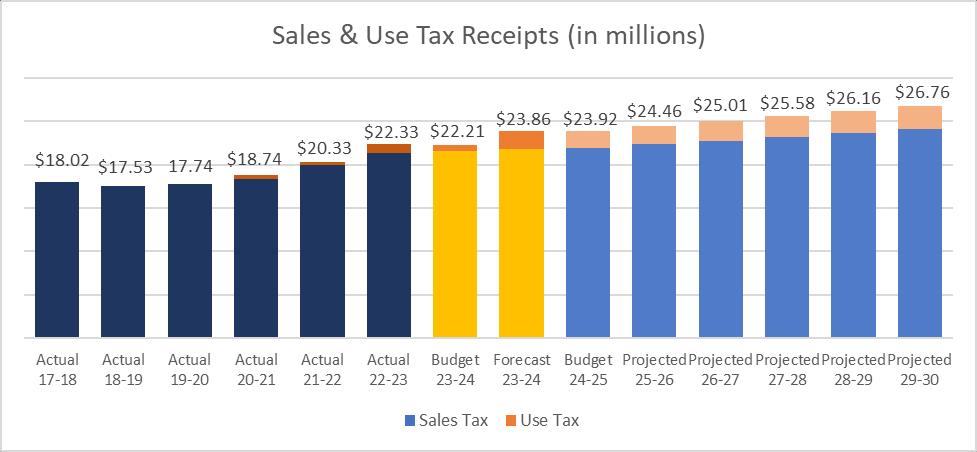

The use tax was passed by voters on a provision that receipts from the tax would be paid first to the Animal Shelter and Police Department. After that provision is met each year, the remainder of the funds will waterfall to the other departments and funds within the city. The use tax is growing at a faster rate than the retail sales tax and is collected at the same rates for each tax type.
• Amounts dedicated to the Animal Shelter and Police Department will increase by 4.4% next year.
o The Animal Shelter will receive $893,000 (up from $855,000 in FY2023-24)
o The Police Department will receive $4.683 million (up from $4.5 million in FY2023-24)
• The budgeted waterfall amount is $4,889,000 in FY2024-25
o The General fund is budgeted to receive $2,040,000


• Based on gross revenue
• Expected trend is to continue increase, particularly for Power & Light
• The growth between 22-23 and 23-24 is due to the elimination of a discount on all electric bills. This particular PILOT is subject to greater fluctuation in receipts due to weather patterns.
• Without increases to utility rates, growth will be limited in out-years.
• Water: Historically volatile revenue source but very small component of total.
• Gas: Performance dependent on weather. Change in State Statute will lead to a decrease in revenue on cable franchise fees but an in
• Telephone: Projected structural decline as citizens cut cord.
• Electricity: Performance dependent on weather; energy efficiency efforts.
• Cable: Projected structural decline as citizens cut cord.
• Fines and forfeitures have trended down significantly since the passage of Senate Bill 5 which limits how much revenue may be generated in a city from court fines and fees.
• With the exception of impacts of the COVID-19 Pandemic, revenues raised from charges for services in the city’s General Fund have remained relatively stable since FY2018-19. There are no upcoming changes expected to make major disruptions to this revenue source.


• General Fund is expected to achieve the required minimum, fund balance at the end of FY2024/25.
• Revenues:
o Sales & Use Taxes projected to grow by 2%
o Franchise fees projected to remain relatively flat
o Elimination of 6% discount on IPL rates will increases projected electric utility PILOT that went into effect of October 2023 will positively impact receipts from July 1 –October 31, 2024.
o Fines & Court Fees remain relatively flat
• Expenditures
o Personnel:
▪ No new GF personnel
▪ 2% COLA for unrepresented employees
▪ Wage increases for represented employees as outlined in each contract
▪ No federal funding for transit provided this year
• Inflation is impacting cost of living and business
• Future budget impact that will need to be monitored:
o Increasing healthcare costs
o Transit program studies & loss of federal funding
o Union negotiations – contractually obligated public safety pay adjustments
• General Fund unassigned fund balance:
o Projected to begin FY 2024/25 at $14 million (17%)
o The city’s reserve balance policy is 16% of revenues
o $260,000 in capital projects approved for General Fund for FY 2024/25
o The city must make additional adjustments over 5-year horizon to not fall into an annual operating deficit.
$6,591,442 $5,700,364
$10,185,654 $14,660,432 $9,258,929 $1,956,769 $6,966,399
$17,514,202 18-19
Enterprise Funds Overview
• The three enterprise funds are Sanitary Sewer (formerly Water Pollution control), Water and Power & Light (also referred to as IPL/Independence Power and Light)
• Enterprise funds support the operation of these departments, separate from the General Fund
• Revenues are based primarily on utility rates
• These funds are established to account for services financed and operated in a manner like private businesses
• Total budget (including capital – see on chart below):
o Sanitary Sewer - $40,894,298
o Water - $48,542,960
o Power & Light - $169,873,760.38

Debt & Leases, 17,411,617 , 7%
Capital Budget, 32,659,000 , 12%
Budget, 209,240,401 , 81%
• These are only known or expected grants that were included in the budget.
• There may be other grants, particularly in Health and Safety, that the city is able to obtain, at which time a budget amendment will be done.
• Amounts do not include grants that may be received by Enterprise Funds.
• The Use Tax is previously explained in the General fund revenues.
• Total Use Tax rate is 2.625%
• This shows the waterfall impact on special revenue funds set up for the use tax.
• Budget estimated that the sales subject to use tax are $398,000,000
o Ballot language requires these two funds to be allocated first:
▪ Animal Shelter Use Tax Fund - $893,000
▪ Police Use Tax Fund - $4,683,000
o Remainder estimated to waterfall is $4,889,000

Use tax all funds
For accounting purposes, a local unit of government is not treated as a single, integrated entity. Instead, a government is viewed as a collection of smaller, separate entities known as “funds”. The Government Accounting Standards Board (GASB) Codification of Governmental and Accounting and Financial Reporting Standard, Section 1300, defines a fund as:
A fiscal and accountability entity with a self-balancing set of accounts recording cash and other financial resources, together with all related liabilities and residual equities or balances, and changes therein, which are segregated for the purpose of carrying on specific activities or attaining certain objectives in accordance with special regulations, or limitations.
All the funds used by a government must be classified into one of seven fund types. Four of these fund types are used to account for a local government’s “governmental-type” activities and are known as “governmental funds”. Two of these fund types are used to account for a government’s “businesstype” activities and are known as “proprietary funds”. Finally, the seventh fund type is reserved for a government’s “fiduciary activities”.
Below is a more detailed explanation of the city’s funds:
General Fund (002)
isusedtoaccountforallfinancialresourcesnecessarytocarryoutbasicgovernmentalactivitiesof thecitythatarenotaccountedforinanotherfund.TheGeneralFundsupportsessentialcityservices, includingpolice,fire,municipalservices,andadministration.
areusedtoaccountforspecificrevenuesthatarelegallyrestrictedtoexpendituresforspecified purposes.


Street Improvements Sales Tax (011) - Voters approved a one-half of one cent sales tax for streets, bridges and safety improvements. Additional revenues from the Proposition "P" waterfall provision are accounted for here.
Park Improvements Sales Tax (012) - The Park Improvements Sales Tax Fund has been setup to account for the one-quarter cent sales tax identified for parks and recreation. Additional revenues from the Proposition "P" waterfall provision are accounted for here.
Storm Water Sales Tax (013) - The Storm Water Sales Tax Fund has been set up to account for the one-quarter cent sales tax identified for storm water system improvements. Additional revenues from the Proposition "P" waterfall provision are accounted for here.
Police Public Safety Sales Tax (016) - The voters approved a Capital Improvements for Police Sales Tax in April 2016 at the rate of one-eighth cent of the receipts from the sale at retail of all tangible personal property or taxable services at retail for a period of January 2017 through December 31, 2028. The Police (Capital) Sales Tax Fund has been set-up to account for the one-eighth cent capital improvements sales tax identified for police equipment. Additional revenues from the Proposition "P" waterfall provision are accounted for here.
Fire Public Safety Sales Tax (017) - The voters approved a one-half cent Fire Sales Tax in November 2021 until repealed by voters to replace the current rate of one-eighth cent of the receipts from the sale at retail of all tangible personal property or taxable services at retail for a period of January 2017 through December 31, 2028. The Fire Public Safety Sales Tax Fund has been set-up to account for the one-half cent for improvements including replacing and maintaining fire stations, apparatus, and lifesaving equipment. Sales tax funds can also be used to hire additional firefighters, administration, and personnel to improve department training needs. Additional revenues from the Proposition "P" waterfall provision are accounted for here.
Animal Shelter Use Tax (010) - Voters approved Proposition "P", a use tax on goods delivered to Independence addresses in 2019. The rate of the use is the same rate as the total City's retail sales. The first $1.5 million (adjusted for inflation annually) will be split equally between a fund for Animal Services and a fund for hiring up to 30 new police officers. The next $1.5 million of use taxes in the fiscal year are applied 100% towards hiring of police officers ($3 million total before inflation increase). Use taxes collected over the amounts identified in the special use taxes will then be receipted into any fund that has a sales tax prorated on its share of sales taxes.
Police Use Tax (018) - Voters approved in November 2021 to increase the Proposition "P" use tax to expand the use of funds for new and current Police Department personnel and equipment and to increase the total before inflation increase from $3 million to $4 million and does not change the first $1.5 million split between Animal Services and Police Department. Originally, Voters approved Proposition "P", a use tax on goods delivered to Independence addresses in 2019. The rate of the use is the same rate as the total City's retail sales. The first $1.5 million (adjusted for inflation annually) will be split equally between a fund for Animal Services and a fund for hiring up to 30 new police officers. The next $1.5 million of use taxes in the fiscal year are applied 100% towards hiring of police officers ($3 million total before inflation increase).
Use taxes collected over the amounts identified in the special use taxes will then be receipted into any fund that has a sales tax prorated on its share of sales taxes.
Health & Animal Levy (005) - Funded by the Health & Recreation tax levy collected against real estate within the city of Independence. The purpose of the levy is for Health and Parks and Recreation purposes. This levy is split between the Health & Animal Levy Special Fund and a Parks Health & Recreation Levy Fund.
Parks Health & Recreation Levy (007) - Funded by the Health & Recreation tax levy collected against real estate within the city of Independence. The purpose of the levy is for Health and Parks and Recreation purposes. This levy is split between the Health & Animal Levy Special Fund and a Parks Health & Recreation Levy Fund.
Tourism (004) - The Tourism Sales Tax Fund is supported by both admission fees to the National Frontier Trails Museum and a 6.5% Transient Guest Tax. The 6.5% Transient Guest Tax is to be paid on the gross daily rent due from or paid by transient guests of all hotels and motels, bed and breakfast inns and campgrounds.
Com. Dev. Block Grant (008) - accounts for the federally funded Community Development Block Grant Act program.
HOME (009) - accounts for the federally funded home program.
Grants (015) - accounts for other grants, including Police, Fire, and Health department grants.
Marijuana Sales Tax Fund (065) – accounts for sales on recreational marijuana. Proceeds are limited to use for public safety department expenditures including Police, Fire and Emergency Preparedness.
Enterprise / Utility Funds
areusedtoaccountforoperationsthatarefinancedandoperatedsimilartoaprivatebusinesswhere theintentisthatthecostofprovidingservicestothepublicisfinancedprimarilythroughusercharges.
Power & Light (020) - operations of the city's power and light utilities.
Water (040) - operations of the city's potable water utility.
Sanitary Sewer (030) - operations of the city's sanitary sewer utility.
Internal Service Funds
areusedtoaccountforoperationsinternaltothecitywheretheintentisthatthecostofproviding servicestothecitydepartmentisfinancedprimarilythroughdepartmentusercharges.
Central Garage (090) - Vehicle maintenance and operations of citywide fleet, including gas and oil charges.
Staywell Health Care (091) - Activities related to the city's' self-insured health care plan.
Workers' Compensation (092) - Management of workers’ compensation insurance and claims.


Risk Management (093) - Management of city liability insurance and claims.
Enterprise Resource Planning (ERP) changed to Finance Internal Service (095) - Management of Finance and Administration for the costs associated with providing services citywide including budget, accounting, human resources and technology services.
AllfundsintheoperatingbudgetbookareappropriatedbyCityCouncilviabudgetadoption.
General Fund (002)
Street Improvements Sales Tax (011)
Park Improvements Sales Tax (012)
Storm Water Sales Tax (013)
Police Public Safety Sales Tax (016)
Fire Public Safety Sales Tax (017)
Marijuana Sales Tax (065)
Animal Shelter Use Tax (010)
Police Use Tax (018)
Health & Animal Levy (005)
Parks Health & Recreation Levy (007)
Tourism (004)
Com. Dev. Block Grant (008)
(009)
Grants (015)
Central Garage (090) *
Staywell Health Care (091) *
Workers' Compensation (092) *
Risk Management (093) *
Enterprise Resource Planning (095)
Power & Light (020)
Water (040)
Sanitary Sewer (030)


All Funds(1)
General Fund(4)
Special Revenue Funds(4)
Notes:
(1) In the All Funds Summary, the totals for Internal Service Funds expense have already been included in the operating expenses for GF, Special Revenues, and Enterprise Funds as they are charged out during course of the year for internal services provided to other departments/funds.
(2) The Internal Service Funds Summary is shown for informational purposes, the total amount is in the operating expenses for each fund. The All Funds Summary is the total of the General Fund, Special Revenue Funds, and Enterprise Funds.
(3) Finance and Administration was moved to an Internal Service Fund in FY 2022-23.
(4) The transfers out to capital project funds have been removed from the charts above as budgeted capital project amounts for individual capital project funds have also been included.


(1) Finance and Administration was moved to an Internal Service Fund in FY 2022-23, therefore most expenses are spread in the operating expenditures of all other departments.
(2) The Water Department was combined with Municipal Services in FY 23-24; Fund remains separate.


Capital Projects Funds(1)
(1) Transfers out in the Governmental Funds tab have not been removed, Capital Projects Funds table have not been included in the All Funds Table to not duplicate expenditures for these projects.


General Fund


of Revenues, Expenditures and Change in Fund Balance


Notes: (1) Unassigned fund balance is per February 2024 financial statements.
Schedule 7
Governmental Funds Tourism Fund (004)
Comparison of Revenues, Expenditures and Change in Fund Balance


Revenues
Schedule 7
Governmental Funds Health & Animal Levy Fund (005)
Comparison of Revenues, Expenditures and Change in Fund Balance
(1) Unassigned fund balance is per February 2024 financial statements.
Schedule 7
Governmental Funds
Parks Health & Recreation Levy Fund (007)
Comparison of Revenues, Expenditures and Change in Fund Balance
Revenues
balance


Revenues
Schedule 7
Governmental Funds
Street Improvements Sales Tax Fund (011)
Comparison of Revenues, Expenditures and Change in Fund Balance
Unassigned fund balance is per February 2024 financial statements.
Schedule 7
Governmental Funds
Park Improvements Sales Tax Fund (012)
Comparison of Revenues, Expenditures and Change in Fund Balance
Revenues


Schedule 7
Governmental Funds
Storm Water Sales Tax Fund (013)
Comparison of Revenues, Expenditures and Change in Fund Balance
Schedule 7
Governmental Funds
Police Public Safety Sales Tax Fund (016)
Comparison of Revenues, Expenditures and Change in Fund Balance
Revenues
Expenditures
Excess Revenues Over (Under) Expenditures $811,687 ($1,859,022) ($2,225,221) ($917,853)
(1) Unassigned fund balance is per February 2024 financial statements.

Schedule 7
Governmental Funds
Fire Protection Sales Tax Fund (017)
Comparison of Revenues, Expenditures and Change in Fund Balance

Revenues Over (Under)
(1) Unassigned fund balance is per February 2024 financial statements. (2) Capital Project Fund was established for the FY24-25 Budget
Schedule 7
Governmental Funds
Animal Shelter Use Tax Fund (010)
Comparison of Revenues, Expenditures and Change in Fund Balance
Revenues


Revenues
Schedule 7
Governmental Funds Police Use Tax Fund (018)
Comparison of Revenues, Expenditures and Change in Fund Balance
Revenues
Expenditures
Schedule 7 Governmental Funds
Community Development Block Grant (008)
Comparison of Revenues, Expenditures and Change in Fund Balance
(1) Unassigned fund balance is per February 2024 financial statements.


HOME Grant - Rental Rehabilitation (009)
Comparison of Revenues, Expenditures and Change in Fund Balance
Revenues
Expenditures
(153,604) (151,937) (1) Unassigned fund balance is per February 2023 financial statements.
Schedule 7
Governmental Funds Grant Fund (015)
Comparison of Revenues, Expenditures and Change in Fund Balance


Comparison of Revenues, Expenditures and Change in Fund Balance
Schedule 8
Enterprise Funds Power and Light Fund (020)
Comparison of Revenues, Expenditures and Change in Available Resources
Revenues


Schedule 8
Enterprise Funds Power and Light Fund - Capital (021)
Comparison of Revenues, Expenditures and Change in Available Resources
Enterprise Funds
Sanitary Sewer Fund (030)
Comparison of Revenues, Expenditures and Change in Available Resources
Revenues


Schedule 8
Enterprise Funds Sanitary Sewer Fund (031)
Comparison of Revenues, Expenditures and Change in Available Resources
Schedule 8
Enterprise Funds Water Fund (040)
Comparison of Revenues, Expenditures and Change in Available Resources


Schedule 8
Enterprise Funds Water Fund - Capital (041)
Comparison of Revenues, Expenditures and Change in Available Resources
Expenditures
Schedule 9
Internal Service Funds
Central Garage Fund (090)
Comparison of Revenues, Expenditures and Change in Fund Balance
(1) Unassigned fund balance is per February 2024 financial statements.


Schedule 9
Internal Service Funds
Staywell Health Care Fund (091)
Comparison of Revenues, Expenditures and Change in Fund Balance
Schedule 9
Internal Service Funds
Workers' Compensation Fund (092) Comparison of Revenues, Expenditures and Change in Fund Balance
Other Fund Balance Components
Fund Balance
(1) Unassigned fund balance is per February 2024 financial statements.


Schedule 9
Internal Service Funds Risk Management Fund (093)
Comparison of Revenues, Expenditures and Change in Fund Balance
Schedule 9
Internal Service Funds
Enterprise Resource Planning (ERP) Fund (095)
Comparison of Revenues, Expenditures and Change in Fund Balance
In from Other Funds
(1) Unassigned fund balance is per February 2024 financial statements. (2) Fund 095 was used to establish Finance and Administration as an Internal Service Fund in FY 2022-23.


Schedule 9
Internal Service Funds
Enterprise Resource Planning (ERP) Fund - Capital (096)
Comparison of Revenues, Expenditures and Change in Fund Balance
Schedule 10
Governmental Funds
Street Improvements Capital Fund (051)
Comparison of Revenues, Expenditures and Change in Fund Balance

Schedule 7
Governmental Funds Police Improvement Fund (052)
Comparison of Revenues, Expenditures and Change in Fund Balance
Revenues

Expenditures
Schedule 10
Governmental Funds
Fire Capital Improvements Fund (053)
Comparison of Revenues, Expenditures and Change in Fund Balance
Revenues
Expenditures


Schedule 10
Governmental Funds
Buildings and Other Improvements Fund (057)
Comparison of Revenues, Expenditures and Change in Fund Balance
Schedule 10
Governmental Funds
Storm Water Improv Capital Fund (058)
Comparison of Revenues, Expenditures and Change in Fund Balance


Schedule 10 Governmental Funds
Park Improvements Fund (059)
Comparison of Revenues, Expenditures and Change in Fund Balance
Notes:
FY2023-24 and FY2024-25 includes positions that are included in the hiring "chill" but that may be filled with City Manager approval.
Increase in Municipal Services is due to the merging of the Water Department.


Personnel Expenditures - All Other
Notes:
FY 2022-23 reflects General Fund vacancy savings and movement of Finance and Administration out of the General Fund.
FY 2023-24 reflects General Fund vacancy savings (incl. hiring chill) and movement of Communications out of the General Fund.









Department by Expenditure Category
Full-Time Equivalent Employees
The purpose of the Community Development Department is to enhance the quality of life in Independence by encouraging public involvement in the planning and creation of quality places in which to live, work, and play.
The Code Enforcement Division contributes to the City’s strategic plan by improving customer service and communication with the public through our daily interactions. Code Enforcement is essential in combating blight through corridor sweeps, monitoring known blight areas, and by continuing to recognize and address code violations proactively.
The Development Services Division contributes to the City’s strategic plan by updating necessary codes to help stabilize neighborhoods and help residents increase or maintain the value of their properties. In keeping with the Independence for All Strategic Plan, the division has ensured that land use policies provide residents with quality housing opportunities with safe and improved infrastructure. The Division has focused on Growth by supporting and guiding developers seeking to redevelop key corridors in the city with proactive planning and quality engineering. Through the short-term rental program and working with business owners, staff has worked to ensure quality guest facilities that attract visitors to our community. Finally, the division has worked to be Customer-Focused by developing positive working relationships with developers and landowners to improve communication and clarity by guiding applicants through the development process, assist them in navigating the City’s codes, specifications, and permit process and provides interdepartmental communication with the applicant.
The Historic Preservation Division strives to provide excellent customer service via assistance from preservation staff in-person, on- site, online, and in prompt responses to email and phone requests for information. The Historic Preservation goals outlined in the Preservation Master Plan promotes growth and improves the quality of life for residents and business owners within our city’s historic districts and throughout the historic built environment.
In trying to align with the City’s strategic plan, the Building Inspections Division of Community Development has worked even further towards revamping and streamlining our online/electronic permitting efforts. We currently have all permitting available online and/or able to be electronically submitted. This have drastically improved our customer service capabilities. We also have the Vacant Structure program 100% up and running now (completing the Cityworks implementation was our last step), and the program is operating well.
The Regulated Industries Division contributes to the City’s Strategic Plan goal to improve customer service by putting the right staff in place to provide our service and by updating applications and other documentation to be more clear and to improve the customer experience. The division also contributes to the increase economic prosperity of the community by removing or reducing as many barriers as possible between the business owner and the city services they need to succeed.


Program by Expenditure Category
Program by Fund
Total Full Time Equivalent Positions
PROGRAM MISSION
The mission of Community Development Administration is to lead and direct development policy for the City so that safe, livable and sustainable environments are created and maintained.
MISSION
The Neighborhood Services Division strives for partnerships with citizens and businesses to promote and maintain a safe, healthy, and desirable living and working environment through the administration of the Property Maintenance, zoning, and right-of-way codes.
ACCOMPLISHMENTS
Completed Pitcher Neighborhood Improvement Initiative (neighborhood sweep).
Proactive Enforcement on Used Car uses in light of the recent UDO changes.
Assisted Tech Services in making modifications to CityWorks for better case management, which will improve large scale code enforcement initiatives and reporting.


by Expenditure Category
by Fund
Total Full Time Equivalent Positions
The mission of the Development Services Division is to apply City standards, Ordinances, and the Comprehensive Plan to ensure an attractive, safe, and functionally built environment that maintains the vision, values, and priorities of the community.
Development Services completed updates to the UDO on Adult Businesses which updates operational provisions and requires a special use permit for new adult business projects.
UDO amendment updates also included Vehicle Sales, Repair, Gas Sales, and Car Washes to address concerns about these uses congregating along commercial corridors having potential impacts on land use conflicts and altering the character of those corridors.
Amendments to our Multi-Family UDO were also accomplished that provided clear and consistent specifications for those wishing to develop multi-unit, multiplex, and mixed-use residential projects. The amendment also included more consistent parking regulations for larger density developments.
The process for Historical Conservation Overlays was streamlined to reduce redundancies for applicants seeking Conservation, Historic, or Historic Landmark Overlays.
Updates to our Donation Bin Code were made to clarify and better define enforcement and abatement actions for those not in compliance.
A UDO amendment for our Short-Term Loan services code to include consumer installment loan providers. Several major development projects – the first phase of the Northpoint Industrial Development site, the Cargo Largo commercial building, and the housing development New Town at Harmony Phase 1A, 2, and 3 – completed infrastructure.
Program by Expenditure Category
Total Full Time Equivalent Positions
MISSION
The purpose of the Transportation function is to provide a rider-focused transit system that provides access to employment, health, educational and social destinations through a fixed route system and paratransit program.


The Historic Preservation Division assists in cultivating diverse and sustainable places by encouraging community-wide preservation of our irreplaceable, historic built and natural environments through proactive preservation planning, public engagement, and reinvestment in traditional building stock.
Continued public outreach/education with free architectural walking tours in September, October, and November 2023.
Hosted a series of in-person events celebrating National Historic Preservation Month, May 2024.
Updated/re-structured the preservation webpage as part of the city’s new website launch.
Continued and expanded a social media presence to promote historic preservation city-wide.
Commenced a grant project to create construction documents for the Vaile Mansion.
Initiated a grant project to update the city’s preservation design guidelines.
Total Full Time Equivalent Positions
The Building Inspections Division enhances the quality of life in Independence by ensuring that buildings are constructed, utilized, and maintained in a manner that reduces the risk to public health, while ensuring the safety, welfare, and trust of citizens, business owners, and visitors in all elements of construction throughout the City.
Continued to utilize ARPA funds in the demolition of dangerous building resulting in more dangerous/blighted structures being demolished.
Continued enforcement of the Vacant Structure program. Staff has identified hundreds of vacant properties and are succeeding in registration efforts as well and in many cases these properties have been made viable again.
Building Inspection is finally at full staff, which is helping in our customer service efforts and aiding our citizens and contractors.


Total Full Time Equivalent Positions
The purpose of Regulated Industries is to issue licenses and permits to businesses and to inspect said businesses for compliance with City ordinances so that safe, healthy and livable environments are maintained.
Continual effort on enforcement of business license regulations with higher focus on follow through of enforcement process.
Implemented process with Utilities and Rental Ready Program to locate unlicensed landlords. Executed plan with Neighborhood Services to review auto use locations and enforce recent ordinance changes.
Worked with Finance to update businesses and Cityworks mapping for Benefit District purposes to ensure all businesses are reporting correctly for state and city sales tax.
Program by Expenditure Category
Program by Fund
4451)
Total Full Time Equivalent Positions
4451)


The mission of the Community Development Block Grant (CDBG) Program is to improve the quality of life of low- and moderate-income residents living in Independence by providing for the availability, affordability, and sustainability of suitable living environments, decent housing, and economic opportunities.
Total Full Time Equivalent Positions
MISSION
The purpose of the HOME Investment Partnerships Program is to improve the quality of life in Independence by addressing the unmet housing needs of very low, low, and moderate income persons.







Full-Time Equivalent Employees


Our mission is to protect and promote health and safety and prevent disease and injury for the residents and visitors in our community through a variety of programs and services.
Joined Spay/Neuter Collaborative to increase access to spay/neuter services in our community
Registered with Medicare, Medicaid, and VFC/VFA programs to improve vaccine access
Began sharing a staff member with Emergency Preparedness for coordination with MRC
Re-started the Social Services Summit to improve collaboration among Independence agencies
Began distribution of Narcan and condoms to combat opioid epidemic and increase in STIs
Engaged Community:
Communicate more effectively internally and externally. Continue to enhance the City’s primary public information tools: City 7, website, newsletters, social media.
Improve Emergency Preparedness Programs.
Strengthen Community Services Networks.
Maintain Status as a No-Kill Animal Shelter.
Enhance the Mental Health Co-Responder and ARCH Programs.
A Financially-Sustainable Organization:
Identify Permanent Facility Solution for Animal Shelter.
Identify and Capture Additional Funding to Stabilize the Health Department.
Expenditure Category
PROGRAM MISSION
Our mission is to protect the safety and welfare of people and animals in our community by promoting an environment of responsible pet ownership. Basic animal services, such as animal control, are provided through funding from the Health and Recreation levy and fees for services.
ACCOMPLISHMENTS
Staff responded to 4,807 animal control calls in 2023.


MISSION
Our mission is to protect the safety and welfare of people and animals in our community by promoting an environment of responsible pet ownership. This cost center provides for the operations of the regional animal shelter through funding from the Proposition P use tax.
ACCOMPLISHMENTS
Staff neutered/spayed 357 community cats as part of our TNR program. Staff continued operation of the shelter as "no-kill" with a live release rate of 95.1%. Staff increased Facebook followers from 8,823 to 10,240.
MISSION
Our mission is to promote general health and well-being as well as foster healthy and safe communities. Our specialists strive to incorporate not just policies but practices to reduce hazardous environments in our community.
ACCOMPLISHMENTS
Staff conducted 1,088 health inspections of permitted establishments in our city, including restaurants, lodging, and childcare centers.


Our mission is to protect the health, safety, and welfare of our community through the use of disease surveillance systems, community education, and maintaining partnerships in our community.
ACCOMPLISHMENTS
Staff administered over 130 COVID vaccine doses to the public at no charge. Staff handled 1,364 non-COVID communicable disease cases. ARCH released/cancelled 703 emergency units from incidents.
SIGNIFICANT BUDGET CHANGES
Continued to add grants to support Health operations.
Recreation & Tourism
Director: Morris Heide
Park Services
Athletic Fields and Courts
Arts and Culture
Aquatics
Citywide Facilities
Citywide
Park
Family Programs and Special Events
Nature Programs
Senior Programs
Tourism Services
Historic Sites and Attractions
National Frontier
Trails Museum
Tourism Marketing
Visitor Services and Promotions


Department by Expenditure Category
Department by Fund
DEPARTMENT MISSION
The mission of Parks, Recreation and Tourism is to provide quality leisure, recreational, and educational opportunities for visitors to and residents of Independence.
SIGNIFICANT OPERATIONAL CHANGES
Shifting focus of recreation programming from location-based to category-based: Adult Programs, Youth Programs, Family Programs, Arts & Culture, and Special Events.
Focus on streamlining organization in anticipation of the passage of the GO Bond and construction of a new community center.
Streamlining schedule of fees.
Centralizing citywide facilities oversight from Municipal Services to PRT.
Centralizing citywide grounds maintenance and mowing oversight from individual departments to PRT.


Shifting the cost of Park Patrol to the Police Department.
Transferring all staff out of Fund 004 (except Communications) in anticipation of Tourism being split from PRT.
Reduction in force of 8.7 positions (10.3% of staff) from the FY25 budget.
An Engaged Community
Partnered with ISD, Truman Library, NPS Truman Visitor Center, CSL, and Noland RD CID on initiatives to improve the community
An Innovative Economy
Long-term strategy to add attractions for increased tourism; 2024 Visitor Guide; Wayfinding
Signage project; Tourism Study
A Safe, Welcoming Community
Homeless feeding permits in parks; The Neck monument project; Juneteenth event
A Well-Planned City
Community Center & Recreation Services Study; Truman Depot RFP; centralized trash, mowing services and custodial contracts; completed Vaile, Bingham & MO Model RR Museum facility repairs; completed AO operations analysis; Cable Dahmer Arena upgrades
A Financially Sustainable Organization
Ongoing review of operations to reduce costs, increase revenue and downsize properties
A High Performance Organization
Recreation Programming and Staffing Improvements
MISSION
Administration oversees the various divisions within the department to promote the City as a quality place to visit and reside by providing quality historic sites, parks, recreation facilities, tour packages, and various types of programs and events.
Began Community Center & Recreation Services Study to streamline services with anticipation of the potential GO Bond and a possible new community center. Assessment expected completion date is September 2024.
Began Tourism Wayfinding Signage Plan
Updated contracts with partner groups and organizations
Amended City Code to enable Police to remove homeless individuals from Park Property
Collaborated with Health & Animal Services Dept and Technology Services to create a permit to regulate free food distribution on park property
Oversight of Cable Dahmer Arena projects to include emergency compressor repairs, storm water repairs, new seating, electronic signage, sound system & suite access controls
Implemented new Procurement Policy for the Events Center CID
Internal Services charges are split between 0076071 & 0126041 in order to balance funds


MISSION
The Turf and Facilities Division is responsible for daily park maintenance operations including the cleaning and maintenance of picnic shelters and park restroom facilities, athletic fields and landscape bed maintenance, snow removal, and mowing and trimming in all City parks and recreation facilities.
SIGNIFICANT BUDGET CHANGES
Consolidated with Parks & Grounds Maintenance (6049) in FY 2024-25.
MISSION
The Cemetery Maintenance Division is responsible for daily maintenance operations at Woodlawn Cemetery, including: routine turf and landscape maintenance, coordinating final arrangement needs and internments, and providing accurate facility records for public viewing.
ACCOMPLISHMENTS
Coordinated with Municipal Services to overlay 75% of streets in Woodlawn Cemetery
Purchased new trailer for Cemetery operations
Increased community participation in the national Wreaths Across America Event
Installed new curbs around cemetery office with assistance from Municipal Services
SIGNIFICANT BUDGET CHANGES
No significant budget changes


MISSION
George Owens Nature Park strives to promote, educate and encourage a love and curiosity of nature with all individuals, families, and organizations by creating a welcoming and safe environment to explore nature. This will be accomplished through a variety of group and self-learning exploration activities throughout the park and the City of Independence community to support our natural environment for future generations.
ACCOMPLISHMENTS
Fishing dock repaired and installed in a new location on Lake Lorraine
Completed interior improvements to Lodge and updated taxidermy displays
Created new trail heads for Butterfly and Wapiti Trails and widened portions of PawPaw Trail for more efficient maintenance
Coordinated with Boy Scouts and Eagle Scouts to complete 7 projects (636 volunteer hours) to clear invasive growth in preparation for prescribed burn in winter 2024/2025
Awarded MO Dept of Conservation grant to remove 2 acres of invasive Honeysuckle and stabilize lake areas
Created and implemented new Fur Trader booth at Main Street 1849 with card game, native mammal furs and history of MO mammal
SIGNIFICANT BUDGET CHANGES
Transferring 4.4 FTE to 0126044 and 0126049 in Park Improvement Sales Tax Fund
Transferring expenditures to 0126040 and 0126044 in Park Improvement Sales Tax Fund
MISSION
George Owens Nature Park strives to promote, educate and encourage a love and curiosity of nature with all individuals, families, and organizations by creating a welcoming and safe environment to explore nature. This will be accomplished through a variety of group and self-learning exploration activities throughout the park and the City of Independence community to support our natural environment for future generations.
ACCOMPLISHMENTS
Increased number of programs and events at George Owens
SIGNIFICANT BUDGET CHANGES
Transferring expenditures from Parks Levy Fund to Park Improvement Sales Tax Fund for facility costs
Restructuring Recreation Division to emphasize programming rather than facilities and merging majority of Recreation Division staff into one org in anticipation of a new community center
Transferring Recreation Division staff to org 0126044
Transferring expenditures from Parks Levy Fund to Park Improvement Sales Tax Fund for facility costs


MISSION
This division oversees and manages park revitalization, maintenance, and capital improvement projects planned for the City's park system made possible through the Parks Improvement Sales Tax.
ACCOMPLISHMENTS
Created tiered Parks, Facilities, and Grounds Supervisor positions to provide opportunities for advancement
Executed lease of Crysler Stadium with Independence School District
Installed new computers at both splashpads to monitor chemicals and shut off water if necessary
Formed and poured concrete disc golf tee pads in cooperation with ISD at Pioneer Ridge Middle School
Replaced fence at Rotary Park
SIGNIFICANT BUDGET CHANGES
Removing Park Patrol funding
Shifting 2.0 FTE from Tourism Fund into 0126041
Adding 2.0 FTE Seasonal Maintenance Workers
Improvement Sales Tax (0126042)
MISSION
The mission of this division is to provide ongoing operation of the City's historic Truman Memorial Building, which serves as a community asset capable of hosting a variety of different functions.
ACCOMPLISHMENTS
Relocated the National Frontier Trails Museum to the ground floor of the Truman Memorial Building
Displayed veterans exhibits throughout the facility to open Veterans Hall for rental space and meetings
Increased regular business hours of the museum and facility
Updated lighting fixtures to LED throughout the building
SIGNIFICANT BUDGET CHANGES
Transferring Truman Memorial Building facility expenses to Tourism Fund
Restructuring Recreation Division to emphasize programming rather than facilities and merging majority of Recreation Division staff into one org in anticipation of a new community center
Transferring Recreation Division staff to org 0126044
Transferring Truman Memorial Building facility expenses to Tourism Fund


MISSION
The Palmer Center encourages the well-being of older adults in Independence by providing diverse senior adult programs and services including a daily meal program, fitness opportunities, education classes, recreational programs, and a wide variety of social needs.
ACCOMPLISHMENTS
Palmer Center retained status as a Gold Level Senior Center which is the highest level from MARC
MARC grant funding was awarded to purchase a new serving line, additional freezer, and new dining room tables and chairs
Annual Scamboree program to inform seniors about fraud and scam prevention is used by MARC as a model for other regional senior center
Palmer Center Enhancement Funds used to add additional safety padding to both ends of the gymnasium
Senior trip program resumed following COVID hiatus
SIGNIFICANT BUDGET CHANGES
No significant budget changes
MISSION
The mission of Family Programs and Events is to develop programs, special events and activities throughout the Park system, public grounds and through community partnerships that help all individuals and families create positive memories; giving special attention to the development of youth and family programs, outdoor programs and special events.
ACCOMPLISHMENTS
Initiated Community Center and Recreation Services Study
Partnered with City of Sugar Creek, Boy Scouts, Health & Animal Service Dept & television station KCWE for first Sky-High Kite Festival
SIGNIFICANT BUDGET CHANGES
Restructuring Recreation Division to emphasize programming rather than facilities and merging majority of Recreation Division staff into one org in anticipation of a new community center
Reduction in Force of 4.7 FTE
Adding 1.3 FTE Seasonal Recreation Workers


by Fund Parks Improvement Sales Tax (0126045)
MISSION
This division serves to provide ongoing management, support, and supervision of the Adventure Oasis Water Park, spray grounds, and development of aquatics-oriented programs, activities, and events.
ACCOMPLISHMENTS
Painted the slides and large bucket in kiddie pool area
Presented cost analysis to Park Commission and Finance and Audit Committee
Installed air conditioning in lifeguard breakroom
SIGNIFICANT BUDGET CHANGES
Opening the waterpark in summer 2024 to non-residents in an effort to decrease losses
Only budgeting for the 2024 summer season
Restructured Recreation Division to emphasize programming rather than facilities and merged majority of Recreation Division staff into one org in anticipation of a new community center
Transferring Recreation Division staff to org 0126044
Program by Fund
Parks Improvement Sales Tax (0126046)
MISSION
The mission of Sports Administration is to support and fund year-round sports programs for Independence residents of all ages and abilities at multiple indoor and outdoor facilities.
ACCOMPLISHMENTS
Replaced ballasts and lights at Athletic Complex
Installed new windscreens at the Blackburn pickleball courts
SIGNIFICANT BUDGET CHANGES
Reduction in Force of 2.0 FTE


MISSION
The mission of the Independence Uptown Market is to provide a modern, unique, and versatile addition to the list of community assets capable of hosting a variety of different functions including Farmers and Crafters Markets, special events, recreation and fitness programs, and private group rentals.
ACCOMPLISHMENTS
49 Farmers Market events were held and the market received the Best Farmers Market in Eastern Jackson County award for the fifth year in a row
SIGNIFICANT BUDGET CHANGES
Restructuring Recreation Division to emphasize programming rather than facilities and merging majority of Recreation Division staff into one org in anticipation of a new community center
Transferring Recreation Division staff to org 0126044
MISSION
The mission of the Roger T. Sermon Community Center is to provide an affordable rental option for a variety of services including health and physical fitness opportunities, weddings, birthday parties, and business meetings, and advance cultural arts through community theatre performances.
ACCOMPLISHMENTS
Following COVID hiatus, resumed the Toddler Town program
Initiated Community Center and Recreation Services Study
SIGNIFICANT BUDGET CHANGES
Restructuring Recreation Division to emphasize programming rather than facilities and merging majority of Recreation Division staff into one org in anticipation of a new community center
Transferring Recreation Division staff to org 0126044


Parks Improvement Sales Tax (0126049)
MISSION
The mission of Parks and Grounds Maintenance - PST is to mow, maintain and landscape City-owned property, including snow removal, as funded by the Park Improvement Sales Tax.
Removed 142 truck loads of brush from the parks and trails (Honeysuckle, Bradford Pear, Bamboo)
Purchased new high loader to use in trash pickup, homeless camp cleanups, and landscape work
Removed 35 homeless camps on park property (through March 2024)
Shifting 1.0 FTE from George Owens (0076078) in Parks Levy Fund and 3.6 FTE from Historic Sites (0046063) in the Tourism fund
Reduction in force of 1.0 FTE as part of transfer from Tourism Fund to Parks Sales Tax
Park Maintenance staff will mow fire stations this spring
Tourism Administration oversees administrative, marketing, and historic preservation activities associated with the Tourism Division of the department.
City Manager's Office initiated a study to determine the future of Tourism
Tourism Development Fund provided $100,000 to the Independence Square Association to expand event offerings which promote Tourism in the City
Completed Economic Impact Study to determine the impact of the KC Royals moving away from the Truman Sports Complex
Began Wayfinding Signage Project as recommended in the 2024 Tourism and Museum Master Plan
Developed and distributed the 2024 Independence Visitor Guide
Marketed the City in various mediums including print ads in Missouri Life, the 2024 MO Travel Guide, the Royals Yearbook as well as online advertising and promotion on the City's website and multiple social media platforms
Sponsored the Mavericks and Comets promoting the City of Independence at games
Partnered with MO Model Railroad Museum to add a new attraction to draw tourists
Worked with the National Park Service on the design for the new Harry S Truman Visitors Center


MISSION
The mission of the National Frontier Trails Museum is to serve both the local community and visitors to Independence by operating a historic museum featuring the westward expansion of the United States and the role Independence played in that development.
ACCOMPLISHMENTS
Relocated the Museum to the lower level of the Truman Memorial Building
Secured humidity- and temperature-controlled storage for covered wagons and wall murals during museum relocation
SIGNIFICANT BUDGET CHANGES
No significant budget changes
MISSION
The Historic Sites Maintenance division is responsible for daily maintenance operations, including mowing and trimming, landscape bed care, snow removal, litter and debris removal, holiday decorating, and basic repairs for all City-owned historic properties.
Replaced roof on the Stable at the Bingham Waggoner Estate
Executed updated use agreement with the Vaile Victorian Society
Began repairs to the South Side Porch of the Vaile Mansion
Issued Request for Proposal for the Truman Depot to repurpose the facility after renovations are complete
Completed interior and exterior renovations to former NFTM facility
Executed long-term lease with MO Model Railroad Museum to bring a new tourism attraction to the City
Demolished Mill Office as it was deemed a dangerous building
Replaced roof on the Stable at the Bingham Waggoner Estate
Executed updated use agreement with the Vaile Victorian Society
ShiftingTruman Memorial Building's operational costs to the Tourism Fund
Shifting maintenance staff back to Parks and will charge Tourism for services performed at Historic sites


MISSION
Visitor Services and Promotions is responsible for directly and indirectly soliciting, securing, and supporting group tours, events, conferences, etc. and maintaining relationships with the Hotel and Lodging Alliance and historic site friends groups.
ACCOMPLISHMENTS
Sponsored two 'Hearts' in the KC Parade of Hearts to increase visitors to Independence
Collected information about partnerships' activities and attendance at Historic Sites and attractions
Distributed over 4,000 promotional items
Sales and Services Staff attended several promotion, marketing and sales events
Supported the Hotel & Lodging Alliance by attending meetings
Attended City Owned Attractions/Historic Sites Board meetings
SIGNIFICANT BUDGET CHANGES
No significant budget changes
MISSION
The mission of Right-of-Way Maintenance is to provide landscaping and grounds maintenance for City-owned property and City-maintained right-of-way.
ACCOMPLISHMENTS
Cleared brush and debris from railroad easement and the I-70 & Noland Road corridor to reduce homeless activity
Cleared 56 loads of brush and trash from City-owned lots
SIGNIFICANT BUDGET CHANGES
No significant budget changes


MISSION
Facilities Maintenance provides routine maintenance of City buildings to ensure a clean, secure and welcoming environment for employees and visitors.
ACCOMPLISHMENTS
Implemented citywide contracts for custodial services, mowing and landscaping services and trash removal
Citywide fire extinguisher inspections and backflow testing performed by City staff reducing overall expenses
Inventoried Facilities Maintenance Furniture, Fixtures and Equipment at new city facility
Relocated Facilities Maintenance to new city facility
SIGNIFICANT BUDGET CHANGES
No significant budget changes
SIGNIFICANT BUDGET CHANGES












(4100, 0954100, 4150)
(0954240)
0954058, 0954059)
Department by Expenditure Category
The mission of the Internal Service Fund is to provide leadership and direction for the City's internal operations and responsibilities so that all assets of the City are protected while providing effective and efficient support.




Director Meagan Borth

Administration

Treasury
Accounting
Finance

Operations


Program by Expenditure Category
Total Full Time Equivalent Positions
PROGRAM MISSION
The mission of Finance Administration is to provide leadership and direction for the City's financial duties and responsibilities so that all financial assets of the City are protected.
Program by Fund
Total Full Time Equivalent Positions
PROGRAM MISSION
The mission of Finance Administration is to provide leadership and direction for the City's financial duties and responsibilities so that all financial assets of the City are protected.


Program by Expenditure Category
by Fund
Total Full Time Equivalent Positions
The mission of Accounting is to maintain the accounting records for all of the City's operations and component units so that the records meet all governmental accounting standards and the annual independent audit is completed.
Total Full Time Equivalent Positions
MISSION
The mission of Treasury and Debt is to ensure excellence in the management of its banking, investing, and financing services and the administration of unclaimed property.


Program by Expenditure Category
by Fund
Total Full Time Equivalent Positions
MISSION
The mission of Finance Operations is to work collaboratively across the organization to ensure operations and core functions are performed according to best practices to the highest standards of customer service, accountability and efficiency.
ACCOMPLISHMENTS
P-Card process for training of new card holders was developed. Procurement policy has been updated.







Total Full Time Equivalent Positions
MISSION
To tell the many stories of Independence and engage our community while guided by the City’s strategic plan.
SIGNIFICANT BUDGET CHANGES
Reduction in force of two full time employees.

Human








Program by Expenditure Category
Program by Fund
Total Full Time Equivalent Positions
MISSION
The Human Resources Department is focused on creating a positive workplace culture that aligns with the City's values and mission as determined by the City Council and implemented by Executive Leadership. This team is pivotal in building, shaping, and reinforcing the organization's culture by overseeing all employee-related functions.
Accomplishments
Changing the operating model of the department by hiring subject matter experts in recruiting, employee relations and training.
Significant Budget Changes
Implemented Case Management System via Dayforce (fka Ceridian). Will save $12.4 million over 3 years as well as 39,200 employee hours saved annually.


Program by Expenditure Category

Program by Fund
Total Full Time Equivalent Positions
MISSION
To conduct and carry on all civil suits, actions, and proceedings; draft or review proposed City ordinances and amendments; and prepare or officially approve as to form all contracts, deeds, bonds, and other documents.



by Expenditure Category
Program by Fund
Total Full Time Equivalent Positions
MISSION
The mission of Technology Services is to provide information technology solutions within a secure and reliable environment and support City departments in delivering quality services to the community.
ACCOMPLISHMENTS
Implemented a new telephone system
Implemented a utility customer service call center software
Implemented a new public website
Expanded the use of mobile device management tools
Data center capacity expansion
Implemented several cyber security tools
2023 Digital Cities Winner
SIGNIFICANT BUDGET CHANGES
Added data center replacement to CIP. The cost will be broken out across a multi-year period to minimize operating impact on departments.
Program by Expenditure Category
Program by Fund
MISSION
The mission of Voice and Data Systems is to maintain the telephone trunk system for land line telephones, radios, and to provide internet connectivity to City Departments so that modern communication can exist.


Program by Expenditure Category
Program by Org Key
(0954054)
Total Full Time Equivalent Positions
Provide innovative GIS-centric solutions within a secure and reliable environment in order to support City departments in delivering quality services to the community.
Internal Service Funds are used to account for the financing of goods or services provided by one department or agency to other departments or agencies of the government and to other governmental units on a cost-reimbursed basis. This fund is used to account for the costs of the City's self-insured Worker's Compensation claims and administration plan. Workers' Compensation is part of Finance and Administration.


MISSION
Internal Service Funds are used to account for the financing of goods or services provided by one department or agency to other departments or agencies of the government and to other governmental units on a cost-reimbursed basis. The mission of Risk Management is to manage the insurance and programs that safeguard the City's financial, human resource, and capital assets. Risk Management is part of Finance and Administration.
Municipal Services

Director: Lisa Reynolds

Collection System
Maintenance

Central Garage

Storm Water Maintenance Engineering


Environmental
Services

Storm Water
Permit Compliance

Facilities
Management
Sanitary Sewer

Treatment

Street Maintenance

The mission of the Municipal Service Department is to provide quality, reliable, and responsive public services for the Independence community. The Department must proactively and reactively maintain City infrastructure such as streets, facilities, sanitary sewer, stormwater mitigation, and wastewater treatment. Additionally, the Department is dedicated to public health and environmental protection through the enforcement of local, state, and federal laws. Ensuring a motivated and professional staff is essential to the success of the Department.
• Incorporated Water operations into Municipal Services
• Transitioned Facilities Maintenance to Parks/Rec/Tourism
• Implemented software to allow enhanced Customer Service operations
• Converted sludge at Rock Creek to a Class A product to apply to agricultural fields
Goal: An Engaged Community
• Continue to solicit public feedback on citywide infrastructure projects
• Streamline coordination of public concerns reported to the City
• Finalize transfer of Crysler Stadium to ISD
Goal: An Innovative Economy
• Support the continued development of Eastgate Commerce Center by facilitating related infrastructure improvements
• Partner with ISD to provide job shadowing opportunities and potential internships
Goal: A Well-Planned City
• Assist with the development of a criminal justice facility plan
• Facilitate the construction of new fire stations and necessary rehab of existing stations
• Evaluate space and maintenance needs for City facilities and determine priorities for necessary improvements
• Refine the Pavement Management program
• Target street and sidewalk maintenance along major corridors and historic sites
• Develop and adopt Access Management Plan and Storm and Sanitary Master Plans to guide development
Goal: A Well-Planned City
• Develop an ordinance requiring residential trash service
• Continue construction of 24 Highway Complete Streets project
• Continue implementation of the recommendations in the adopted Downtown Redevelopment Coordinating Committee Master Plan
• Continue design work on Noland Road Complete Streets project
• Complete an ADA transition plan
• Increase rate at which water transmission and distribution mains are replaced
• Establish and maintain a database of the material of all water service lines

• Complete Best Professional Judgement study for water plant sludge discharge
Goal: A Financially Sustainable Organization
• Perform cost of service study for the sanitary sewer utility
• Modify Drop Off Depot fee schedule for tires
• Create equipment/facility/vehicle replacement plans and fund accordingly
Goal: A High-Performance Organization
• Set performance measures that align with the action plan
• Lead effort to improve departmental collaboration and communication
• Encourage operational innovation at all levels
• Expect excellence
• Rock Creek selected as the MWEA’s Wastewater Plant of the Year
• $16.2M in grant dollars obtained for various projects throughout the city
• Assisted with the purchase of the GEHA building
• Expanded the Enterprise lease program to include additional divisions
• Successful modification of IPL rate structures in CIS
• Adoption of the D&C Manual
• Completion of the 40 Hwy Complete Streets project
• 50.83 lane miles of roadway addressed via preventative maintenance program
• 100% passing rate for the 1242 water distribution samples collected
• Implemented new Customer Service call center software
Overlayed ~50% of Woodlawn Cemetery roads utilizing city staff, supplies, and equipment




Program by Expenditure Category
Program by Fund
(002-5001, 5013)
PROGRAM MISSION
The Administration Division is responsible for the supervision and administration of the Public Works division, including support and response to the City Manager and City Council.
The Engineering Division provides public works services through the following work elements: plan review, design, investigations, studies, contract specifications, inspections, permits and traffic engineering, land acquisition for public improvements, and tracking project reimbursements on construction projects.


by Expenditure Category
SIGNIFICANT BUDGET CHANGES
The Construction Division was established in the FY 2024-25 budget.
SIGNIFICANT BUDGET CHANGES
Function and budget transferred to Parks, Recreation & Tourism after beginning of FY23-24.


Program by Expenditure Category
Total Full Time Equivalent Positions
MISSION
Street Maintenance is responsible for maintaining 575 miles of City streets and 38 bridge structures, as well as the coordination of the Drop-Off Depot events.
Program by Fund
MISSION
The mission of the Storm Water Program is to maintain the City's storm water system to the standards of the Missouri Department of Natural Resources so that the MS4 operating permit is granted to the City.


MISSION
Internal Service Funds are used to account for the financing of goods or services provided by one department or agency to other departments or agencies of the government and to other governmental units on a cost-reimbursed basis. This fund is used to account for costs of maintenance of the City's fleet of vehicles and mobile equipment and related charges to other departments.
Department by Expenditure Category
DEPARTMENT MISSION
Sanitary Sewer, formally known as Water Pollution Control, is part of Municipal Services, and is responsible for the maintenance and enforcement of the City's water pollution control policies and regulations.


MISSION
The mission of the Administration program is to provide leadership and back-office support for the development, maintenance and enforcement of the City's water pollution control policies and regulations.
Program by Expenditure Category
Program by Fund
MISSION
The mission of the Facilities division is to ensure reliable operation of wastewater collection and treatment systems through preventative and predictive maintenance practices.


Program by Expenditure Category
Program by Fund
MISSION
The mission of the Treatment Facilities program is to operate and maintain the Rock Creek Wastewater Treatment Plan and thirteen pumping stations throughout the City so that wastewater meets all National Pollutant Discharge Elimination System permit limits.
Program by Expenditure Category
Program by Fund
The mission of Collection System Maintenance is to maintain over 614 miles of sanitary sewer pipe and over 14,720 manholes to a level that minimizes the number and frequency of overflows and backups.


MISSION
The mission of the Environmental Services program is to inspect, sample and analyze industrial sewage discharges to determine compliance with National Pretreatment regulations.
MISSION
The mission of the Inter-Jurisdictional program is to provide administrative support for cooperative sewer services within the contiguous watersheds of adjoining municipalities and the Little Blue Valley Sewer District.


MISSION
Provides funding for department-wide activities not attributable to one single sewer program.
Department


The mission of the Water Department is to produce and supply drinking water that meets the requirements of the Safe Drinking Water Act and standards of the Missouri Department of Natural Resources to about 250,000 people, including residents of Independence and 12 wholesale customers.
Expenditure Category
The mission of the Administration program is to provide leadership and back office support so that the Department can successfully meet the requirements of the Safe Drinking Water Act and standards of the Missouri Department of Natural Resources.


by Expenditure Category


by Expenditure Category
Program by Expenditure Category
Program by Fund
The mission of the Water Field Service Division is to provide an onsite response to customer inquiries and requests in addition to installing and maintaining meters for over 49,657 customers so that consumption levels are accurate and service line leaks can be identified for repair.


Program by Expenditure Category
MISSION
The mission of Customer Service is to accurately issue utility bills to all City water, sewer and electric customers and to operate a customer service center for all billing inquiries.
Program by Expenditure Category
Program by Fund
MISSION
The mission of Production is to operate and maintain the Courtney Bend Water Treatment Plant so that up to 48-million gallons of water, that meets or exceeds all federal and state standards, can be pumped daily.


by Expenditure Category
Program by Expenditure Category
Program by Fund
MISSION
The mission of the Transmission and Distribution Division is to engineer, construct, and maintain 766 miles of water main pipe so that water is distributed to the customers with consistent pressure and minimal loss of treated water.

Program by Expenditure Category

Program by Fund


$33,473,103
Program by Expenditure Category
Program by Fund


Lease Purchase 19LP - Street Sales Tax
Lease Purchase 031 - Street Sales Tax
Issue 2013D - Water













Department by Expenditure Category
Department by Fund
DEPARTMENT MISSION
The City Manager is the Chief Administrative Officer of the City government, exercising direction over all municipal operations. The Office of the City Manager is comprised of the City Manager and Public Information Officer departments.
PROGRAM MISSION
The mission of the City Manager is to serve as the Chief Administrative Officer of the City government so that Mayor and City Council-directed policies are implemented and city services are delivered efficiently and effectively.
* Excludes headcount that is allocated to other departments.


SIGNIFICANT BUDGET CHANGES
The Communications Department (PIO) has moved into the Internal Service Fund beginning FY 202324
PROGRAM MISSION
The mission of the Emergency Preparedness Division is to protect and serve our community by preparing for the unexpected and ensuring a swift, coordinated, and effective response to emergencies of all kinds.
ACCOMPLISHMENTS
Awarded $220,000 dollars in grant funds
Fully implemented our remote activated and automated outdoor warning siren system (NWS)
Completed the COOP plans for each City Department
Applied for additional COVID-19 assistance grants
Participated in and led several City, region and state-wide exercises
Is an ongoing stakeholder in several of the MRCKC projects


PROGRAM MISSION
The mission of the City Clerk is to manage and record the official proceedings of the City of Independence so that the official business of the City is duly recorded and maintained. ACCOMPLISHMENTS
In working with all departments, we have streamlined the records request process, and become more consistent when it comes to open records requests. Our current processes are more closely aligned with the Missouri Sunshine Law and the Independence City Code. This continues to be a focus in FY 23/24 to continue to improve this process.
The Clerk’s Office has tackled some big projects when it comes to converting paper records into electronic records. This creates efficiencies when it comes to pulling older records for staff and the public.
Strategic Plan Connection
Our primary connection to the Independence Action Plan is being Customer Focused with effective engagement with the community. Updates to the records request process has resulted in faster and more frequent responses to the requestor, and a one stop shop for obtaining public records
Offices of the Mayor and City Council
and City Council






Department by Expenditure Category
Department by Fund
Full-Time Equivalent Employees
DEPARTMENT MISSION
Process, record, and report all transactions in a timely and accurate manner using sound business practices and methods. In performing our mission, we will maintain a well-trained staff and utilize the tools provided by the City to their greatest advantage.
The mission of the Mayor is to serve as the presiding officer of the City Council, as provided by the City Charter. As the presiding officer, the Mayor works with other members of the City Council to enact legislation and make appointments to various advisory boards and commissions.


MISSION
The mission of the City Council is to enact legislation that protects the health, peace, property, and general welfare of the citizens of the City of Independence. The Council consists of four members elected by the voters of the Council District, and two members elected at-large, or by all Independence voters.
MISSION
The mission of the City Clerk is to manage and record the official proceedings of the City of Independence so that the official business of the City is duly recorded and maintained.
This org was consolidated with the City Council org as of the FY 23-24 budget and has been transferred to the Office of the City Manager as of December 2023.


MISSION
The mission of the Management Analyst program is to systematically and continuously examine all works of the City in order to identify opportunities to reduce costs, increase program efficiency, improve program effectiveness, and enhance professionalism of the administration of the City.
This org has been consolidated with the City Council, Mayor and City Clerk into one org. Expenditures will now be budgeted and recorded in org 4002.

Fire Chief
Interim Chief Charles Lauss


Emergency Medical Services Training & Professional Development

Fire Operations


Fire Prevention

Department by Expenditure Category

Department by Fund
Full-Time Equivalent Employees
The Independence Fire Department will meet the challenges of present and future community needs through pro-active leadership, dedication to our core values, provision of quality All-Hazard emergency services, and community risk-reduction strategies in an efficient and effective manner.

by Expenditure Category
Program by Fund
Total Full Time Equivalent Positions

PROGRAM MISSION
The Administration Division is responsible for the overall management of the department and ensures that strategic goals and objectives meet the visions and mission of the department.
Total Full Time Equivalent Positions
MISSION
The mission of the Fire Operations Division is to serve the emergent needs of the community with response to emergency medical calls, fires, explosions, bomb threats, vehicle accidents, homeland security terrorism, hazardous chemical spills, and other emergency calls.


Program by Expenditure Category
Total Full Time Equivalent Positions
The Emergency Medical Services (EMS) and Wellness Division is responsible for the training and operation of emergency medical services to ensure firefighters can provide basic and advanced life support measures to the citizens.
Expenditure Category
Total Full Time Equivalent Positions
MISSION
The Fire Prevention Division provides for the safety of the residents through inspection of new businesses within the city, fire code enforcement, plan reviews, fire safety education, fire investigation, and the re-inspection of all violations found during company inspections.


Program by Expenditure Category
Total Full Time Equivalent Positions
MISSION
The Maintenance Division manages the service, preventative maintenance, and replacement programs for all staff vehicles, fire apparatus, facilities, and equipment.
Total Full Time Equivalent Positions
The Training/Professional Development Division provides training which promotes safe, effective, and efficient emergency response to the community.


Program by Expenditure Category
by Fund
Total Full Time Equivalent Positions
The Emergency Preparedness Division is responsible for support during times of disaster for all local, state, and federal departments across the spectrum of the emergency management functions, including preparedness, response, prevention, and recovery.
Total Full Time Equivalent Positions
MISSION
The purpose of this cost center is to budget and track expenditures of Fire Protection Sales Tax funds to ensure compliance with the stated goals of this initiative when passed by voters.







DEPARTMENT MISSION
The Municipal Court has jurisdiction of cases involving violation of City ordinances; establishes and collects all fines, court costs, and bond money; issues warrants, subpoenas, and orders of commitment; and provides other services as prescribed by the Charter of the City of Independence, Missouri and applicable State Statutes.
Municipal Court is operating out of three case management systems. Comain, Incode, and Show Me Courts.
July 1, 2023, the Supreme Court launched Remote Public Access, which means, the public now has “remote access” to certain public documents filed in Missouri court cases via Case.net. This applies only to public documents filed on or after July 1, 2023. The public now can view, download and print these public case documents from their personal computers, tablets or cell phones. This, has in turn has created more steps in Show Me Courts, while we are struggling to stay ahead of the very next week’s dockets.
Looking forward to Municipal Court being fully staffed in 24-25. We will be able to process the citations quicker so the public can have access to pay online quicker.
PROGRAM MISSION
The Municipal Court has jurisdiction of cases involving violation of City ordinances; establishes and collects all fines, court costs and bond money; issues warrants, subpoenas, orders of commitment; and provides others services as prescribed by the Charter of the City of Independence, Missouri and applicable State Statutes.







Department by Expenditure Category
The mission of the Independence Police Department is 1) to protect the life, individual liberty, and property of all people within the City of Independence; 2) to lower crime and disorder in the community; 3) to develop and maintain a positive relationship with members of the community; and 4) to foster a positive working environment for police employees.
- Eliminated one Police Records Administrator position.
- Filled all but one vacant Command Staff position.
- Added an Electronic Fleet Technician, a System Admin I and II, an Internal Affairs Sergeant, and a Digital Media Officer Position
The Police Department remains committed to finding ways to operate in the most efficient and effective manner. This will include a department-wide review and evaluation in FY 2024-25 to ensure we are structured to remain a High-Performance Organization. The proposed budget will allow for the Police Department to continue succession planning and development to ensure we remain a part of a Well-Planned City.
We will continue to be good stewards of the Police Department funds to find new and innovative ways to stretch budgeted dollars for maximum efficiency. This will ensure we remain a Financially Sustainable Organization.
At the heart of the mission of the Police Department is public safety. We will continue to look at new and creative ways to combat crime and disorder in our city, while increasing the perception of safety for our citizens. We will continue to utilize our outreach efforts and programs to support an Engaged Community. This will ensure we remain focused on maintaining a Safe, Welcoming Community.

by Expenditure Category

PROGRAM MISSION
The Office of the Chief of Police is responsible for the overall operation and administration of the department. Responsibilities include technology and fleet management, budget and accounting processes, inventories, professional standards, and recruitment.
ACCOMPLISHMENTS
Filled all but 1 vacant Command Staff position.
Added 1 Internal Affairs Sergeant and 1 Systems Admin II position.
SIGNIFICANT BUDGET CHANGES
Salary and benefits have increased due to the addition of 2 FTEs to this Org.
Retiree Health Insurance has increased by $515,981 and Work Comp by $119,400.
Significant increase to Interfund Charges in this Org.
Program by Expenditure Category
Program by Fund
Total Full Time Equivalent Positions
MISSION
The grants program includes federal and state grant programs to assist the Police Department in maintaining peace and order. The general fund portion of this program is the match needed to receive the grants or the funding gap between the actual cost of the program and the amount available from the grantor agency.
IPD was awarded a federal Department of Justice grant for a Body-Worn Camera Implementation Program. The grant will partially cover the purchase of the body worn cameras, plus the addition of three (3) new personnel to assist with and manage the new technology.
Total FTEs increased by the additional personnel added through the new Body-Worn Camera grant. Overtime grants are added throughout the fiscal year as they are awarded and are not included in the proposed budget for the year.

by Expenditure Category

Total Full Time Equivalent Positions
The mission of this unit is to coordinate all department training, including mandated Police Officer Standards and Training (POST) certification, federal, state, and City requirements, and all external training activities. This unit is also responsible for the Field Training Officer (FTO) program, and assists with recruiting and hiring for the department.
Completed updated First-Line Supervisor Course for all Sergeants. Identified Power Users and began initial training for Axon Deployment as well as planning for full implementation.
Existing Training Sergeant was promoted to Captain and a new Training Sergeant was installed.
The cost of salaries and benefits continue to rise each year. Central Garage fuel has increased in Supplies, as well as Training and the cost of Vehicle Repairs. ERP Interfund Charges increased by $12,550.
Program by Expenditure Category
MISSION
The mission of the Patrol division is to reduce crime and disorder by being the initial responder for all calls from citizens 24 hours per day, 365 days per year.
ACCOMPLISHMENTS
2023/2024 completes one full year of the new Sector deployment. The sector concept will remain, as has had positive feedback from officers and resulted in a more balanced workload and improved it response times. 2023/2024 Patrol remains at full staff.
The cost of benefits like health insurance and LAGERS continues to increase. ERP Interfund Charge increased by $37,361.

Program by Expenditure Category
MISSION
The Investigations division consists of the Criminal Investigations Unit, the Drug Enforcement Unit, and the Street Crimes Unit. This division is tasked with reactionary as well as proactive investigation of crimes, including homicides, assaults, domestic violence, drug offenses, and burglaries.
ACCOMPLISHMENTS
Added a second full-time Property Room Technician.
Restaffed and adjusted the mission of the Gun Squad.
Restaffed and adjusted the mission of the Street Crimes Unit.
Continued the use of the PIIT (Police Involved Investigation Team). Had a IPD activation for an Officer Involved Shooting in Blue Springs. Utilization of the PIIT was seemless and very successful. Identified and began training four (4) additional Arson Investigators due to recent retirements. Renewed essential equipment and software that is necessary for the retrieval of evidence and the investigation of many types of crimes.
Genetec system was implemented in the interview rooms and Detectives were trained on the new system.
The cost of salaries and benefits continues to rise.
Operating Supplies increased $2,200 for investigative programs.
ERP Interfund Charge increased by $17,558.

by Expenditure Category
MISSION
The Investigations division consists of the Criminal Investigations Unit, the Drug Enforcement Unit, and the Street Crimes Unit. This division is tasked with reactionary as well as proactive investigation of crimes, including homicides, assaults, domestic violence, drug offenses, and burglaries.
ACCOMPLISHMENTS
Added a second full-time Property Room Technician.
Restaffed and adjusted the mission of the Gun Squad.
Restaffed and adjusted the mission of the Street Crimes Unit.
Continued the use of the PIIT (Police Involved Investigation Team). Had a IPD activation for an Officer Involved Shooting in Blue Springs. Utilization of the PIIT was seemless and very successful. Identified and began training four (4) additional Arson Investigators due to recent retirements. Renewed essential equipment and software that is necessary for the retrieval of evidence and the investigation of many types of crimes.
Genetec system was implemented in the interview rooms and Detectives were trained on the new system.
The cost of salaries and benefits continues to rise.
Operating Supplies increased $2,200 for investigative programs.
ERP Interfund Charge increased by $17,558.

Program by Expenditure Category
Program by Fund
Total Full Time Equivalent Positions
MISSION
The mission of the Tactical Operations division is to assist in reducing crime and disorder by providing support, coordination, and implementation of additional services to Patrol and Investigations through the Canine Unit, SWAT, Explosive Ordnance Disposal (EOD) Team, Crisis Negotiations, Tactical Medics, and Drone Operations.
ACCOMPLISHMENTS
Added one new SWAT operator to replace an operator who had been promoted.
Cable Dahmer donated K-9 Vinnie, who has been certified and is in service.
Procured and certified K-9 Riggs, who is in service.
EOD robot was repaired through a Regional Homeland Security Coordinated Council grant. X-ray equipment for EOD was received through a Regional Homeland Security Coordinated Council grant.
The Canine Unit is transitioning from the Tahoe platform to the Explorer platform.
Several additional officers were trained to be UAS (drone) pilots assigned to Patrol.
SIGNIFICANT BUDGET CHANGES
The cost of salaries and benefits continues to increase. ERP Interfund Charges increased by $10,984.
Utilities and Operating Supplies decreased by $3,300 for FY 24/25.

by Expenditure Category
by Fund
Total Full Time Equivalent Positions
MISSION
Special Enforcement focuses on responded to traffic complaints and crashes, as well as enforcing all traffic laws. The primary duties of Special Enforcement include speed enforcement operations, crash investigation and reconstruction, and DWI/DRE enforcement. In addition, Special Enforcement also provides support during special community and department events.
ACCOMPLISHMENTS
Administered over $1.6 million in Highway Safety Traffic Grants through MODOT.
Added a second Detective position to Crash Investigations and filled an open vacancy with a new Crash Investigator.
Acquired new long range speed detection lasers through Department of Justice JAG funding.
Added a third Type II Operator for Intox 8000 and AS4.
Two officers attended training in Advanced Crash Reconstruction.
Two officers attended training in Basic Crash Reconstruction.
Developed "Wet Lab" DWI enforcement for the department.
SIGNIFICANT BUDGET CHANGES
The cost of salaries and benefits continues to increase.
Operating Supplies have decreased $3,214.

by Expenditure Category

Total Full Time Equivalent Positions
MISSION
The mission of Students Transitioning Exceptionally Prepared (STEP) Program is to prevent or reduce drug, alcohol, tobacco, vaping and violence among students. This is done by conducting coordinated training using PowerPoint presentations and videos. The primary audience for this training consists of students preparing to transition from the elementary school setting to the middle school setting, and those students preparing to transition from middle school to the high school setting.
ACCOMPLISHMENTS
Applied for and received continued funding from COMBAT to fully fund these two School Resource Officer positions
Program by Expenditure Category
by Fund
Total Full Time Equivalent Positions
MISSION
The mission of Community Services is to provide citizens with the information and resources necessary to improve their quality of life and sense of security. This is accomplished through community engagements, the Disorderly /Nuisance property abatement program, Homeless Outreach Program, public demonstrations, Volunteer in Police Services (VIP's), crime prevention and education, and Crisis Intervention.
ACCOMPLISHMENTS
Re-established the Citizen's Academy.
Re-established the Volunteer in Police Services (VIPS) program. Transferred three new School Resource Officers (SRO's) to replace outgoing SRO's, and filled the vacant SRO Sergeant position.
Several School Resource Officers attended the annual SRO conference and training.
Saw a significant increase in citizen attendance at community events held or sponsored by the Police Department. This included National Night Out, whih IPD had not hosted in several years.
SIGNIFICANT BUDGET CHANGES
The cost of salaries and benefits continues to increase. ERP Interfund Charges increased $10,633 but overall Operating Supplies are down $1,600.


Program by Expenditure Category
by Fund
Total Full Time Equivalent Positions
MISSION
The Crime Scene Unit consists of investigators who are responsible for processing crime scenes to gather evidence and other data to support criminal charges. The Unit is also responsible for collecting video evidence from local businesses and residences. The collection and identification of evidence is utilized in the prosecution of criminal defendants, helping to reduce crime in the community.
ACCOMPLISHMENTS
Filled three vacancies which included the selection and training of those employees. Due to staffing shortages during the year, the unit identified, established, and actually utilized an emergency back-up plan with the FBI Crime Scene Unit.
Identified three sworn investigative personnel that will be trained in 2024 in Basic Crime Scene to assist if needed.
Program by Expenditure Category
by Fund
Total Full Time Equivalent Positions
MISSION
The Detention Unit is responsible for processing and housing individuals arrested for violations of City Ordinances, State Statutes, and Federal laws. The unit houses prisoners on a short-term basis who are held for investigation of an alleged violation, awaiting arraignment, or until their bond is posted. Longterm prisoners are transferred and incarcerated at an outside facility.
ACCOMPLISHMENTS
Install shelving and bins in the garage for excess property.
Relocated staff lockers to a secure area.
Implemented Mobile court system.


Program by Expenditure Category
by Fund
Total Full Time Equivalent Positions
MISSION
The Records Unit provides customer service to the public by completing police reports, answering questions, and receiving and returning warrants, subpoenas, and other pertinent court and jail papers.
ACCOMPLISHMENTS
Implemented credit card system for bonds. Clear FBI records audit with no major infractions.
SIGNIFICANT BUDGET CHANGES
FTEs decreased by one due to the elimination of the Records Administrator position.
ERP Interfund Charges increased by $20,032, but Operating Supplies decreased by $1,870.
Program by Expenditure Category
Program by Fund
Total Full Time Equivalent Positions
MISSION
The Communications Unit receives emergency and non-emergency telephone calls from the public and routes them to the appropriate responder: Fire, Police, or AMR.
ACCOMPLISHMENTS
Continued to replace and update aged-out desktop computers with new computers essential for emergency Dispatch.
Continued recruiting, hiring, and training efforts to reduce vacancies.
The cost of salaries and benefits continues to increase.
Funding has increased for part-time Seasonal Call Takers, who are being relied on more heavily due to staffing shortages.


Program by Expenditure Category
MISSION
This cost center serves to provide oversight and management of the revitalization and capital improvement projects planned for the City's Police Department, made possible through the adoption of a one-eighth cent sales tax.
ACCOMPLISHMENTS
Received several orders of vehicles this year, although several were not expected until 2025.
Purchased new Mobile Command Centers out of Sales Tax Fund Balance in 2023/24 FY. The smaller unit is expected to be received before fiscal year end, but the larger unit will not be delivered until next year.
Sales Tax funds were used to partically fund the first year of a 10-year contract with Axon for the purchase of tasers, body cameras, in-car cameras, Virtual Reality training, Records Management software, Internal Affairs software, and all ongoing replacements and maintenance over the 10 year contract period.
Org 4562 (Communications) has increased to cover the annual increase for the Tyler Tech SSMA and an increase needed for MDT air card service.
Org 4563 (Facilities) has increased to cover the increasing utilities and service from outside Technical Contractors.
Org 4564 (Equipment) has significantly decreased due to the annual purchase of tasers and in-car cameras moving to the 10-year contract with Axon.
Capital Project to purchase a new Bearcat has been added in place of the Mobile Command Centers that were purchased out of Sales Tax Funds in FY 2023/24.


Program by Expenditure Category
Program by Fund
MISSION
Revenues generated from the Proposition P tax will hire certified and non-certified police officer candidates, as well as fund equipment for the sworn officers.
ACCOMPLISHMENTS
Use Tax funds were used to partially fund the first year of a 10-year contract with Axon for the purchase of tasers, body cameras, in-car cameras, Virtual Reality training, Records Management software, Internal Affairs software, and all ongoing replacements and maintenance over the 10 year contract period.
SIGNIFICANT BUDGET CHANGES
- The cost of salaries and benefits continues to increase.
- FTEs increased by one officer in the Use Tax, due to the local match required of one Digital Media Officer to be assigned to the DOJ Body-Worn Camera Grant program.
- ERP Interfund charges have increased by $1,109,013.
Expenditure Category






Full-Time Equivalent Employees*
The mission of Power and Light is to provide reliable, safe and cost-effective electricity to the customers of Independence.
Succession Planning continues to be problematic.
Significant employee turnover, due to retirements and resignation, continues to be an issue. Supply chain issues causing significant increases in pricing and delays in receiving materials. Inability to procure pad-mounted transformers is limiting new development for housing and business.
An Engaged Community:
Partnering with community leaders and city leadership concerning future opportunities for IPL ownership and governance.
Utilizing city communications department on informative public outreach and communications.
An Innovative Economy:
Working with community developers to provide successful approaches on providing timely electric service connections and upgrades, specifically during supply chain issues and growth opportunities.
A Safe, Welcoming Community:
Worked with city leaders to improve lighting following a major project on portions of 40 Highway.
Implementing a new AI driven software enabling more adaptive utilization of tree trimming crews to improve reliability.
A Financially Sustainable Organization:
Restructure rates and fees for sustainable revenues to support Operations and responsible Capital investments.
Developing options for future generation/capacity needs.
A Well Planned City:
Expanding transmission and distribution capabilities to support growth on the east side of town. Assisting with corridor improvement plans.
A High Performing Organization:
Working on building cross-departmental relationships and aligning IPL goals to meet the City’s long term strategic goals.


The mission of Administration is to provide leadership of the Department to ensure reliable and environmentally-friendly electric service to the citizens of Independence at the lowest possible cost, consistent with sound business practices. Also to ensure all financial and statistical records of the utility are kept and reported in accordance with governmental best practices and regulations so that the results are transparent to rate payers.
Diamond Reliable Public Power Provider (RP3) designation from the American Public Power Association for providing reliable and safe electric service.
Excellence in Reliability Certificate from the American Public Power Association for reliable performance in 2023. The certificate recognizes hometown utilities that have provided exceptionally reliable service and power to their communities, shown by comparing their outage records against nationwide data gathered by the U.S. Energy Information Administration (EIA).
Gold Safety Award of Excellence designation from the American Public Power Association and MPUA’s Safety Award - given to participating eligible utilities based on their incident rate, and overall state of their safety programs and culture. Additionally: MPUA Honor award given to Rick Lunceford (IPL’s Safety & Training Specialist) for his contributions to the safety culture which ultimately led to IPL’s safety success and the receipt of multiple Safety Awards.
Tree Line USA Award from the Arbor Day Foundation recognizes public and private utilities for practices that protect and enhance America's urban forest as well as delivering safe and reliable electricity while maintaining healthy community trees.
MRO NERC Audit – IPL completed its most recent audit, completed once every three years, with zero deficiencies and only one minor recommendation.
The Finance and Accounting Division was eliminated in FY 2024 and all salaries & expenses disbursed to Administration.


MISSION
ACCOMPLISHMENTS
SIGNIFICANT BUDGET CHANGES
The Finance and Accounting Division has been eliminated and all salaries & expenses disbursed to Administration.
by Expenditure
by Fund
Total Full Time Equivalent
MISSION
Responsible for planning, engineering, administration, installation, and maintenance of City & IPL internal communication systems, fiber optic facilities, primary and backup data facilities, and ancillary support systems. Areas of responsibility include City traffic signals, school crossing signals, fiber optic systems, UPS power systems, network and telephone systems, land based mobile radio, wireless, microwave, SCADA Remote Terminal Units (RTUs), relay protection communication links and CCTV/security cameras for the electric utility.
ACCOMPLISHMENTS
Completed phase 2 loop closure of the fiber optic network expansions for City Water Plant in Sugar Creek, MO. Providing redundant communications for the facility.
Completed fiber expansion to Blue Springs Schools located in Independence city limits in partnership with Blue Springs School District, expanding IPL’s fiber optic footprint. Fiber relocation project for Cargo Largo expansion completed on time.
Completed Sub M Scada Relay expansions and upgrades for SCADA / EMS Systems.
Completed upgrade of APC UPS facilities for city/IPL backup center, adding maintenance bypass switches allow for routine maintenance without service interruptions.
Completed Telenium, Genetec Application Servers and archiver replacements in Operations
Technology environment.
Completed traffic detection camera upgrades for 3 intersections, replacing end of life equipment.
Completed Traffic control cabinet upgrades for 2 locations, retiring TS1 discontinued cabinets.


Completed IPL Sub Station Fiber Maintenance Network installation for CCTV & SCADA enhancements.
Completed 10G Connection to 1102 Grand Neutrality Center for future internet needs.
Removing additional $125k funding item for traffic signal knock downs, previously budgeted for in 23-24.
Program by Expenditure Category
Program by Fund Power and Light Fund (0206160)
MISSION
The mission of Engineering is to design transmission, substation and distribution systems and manage construction projects in the most efficient manner to enable the City's high voltage electrical power systems to maintain the highest level of reliability.
ACCOMPLISHMENTS
Replacement of 69 kV Breakers in Sub M.
Began Engineering overview for transmission, substation and distribution facilities to serve Northpoint development located on East Side of independence.
Extended distribution facilities to serve the first two buildings in the Northpoint development.
Staff serves on the State Board of Missouri Society of Professional Engineers (MSPE).
Staff serves on the National Council of Examiners for Engineering and Surveying Fundamentals of Engineering Committee (NCEES FE) preparing national engineering examinations.


MISSION
The mission of the Environmental Health & Safety Division is to ensure environmental protection and safety compliance through proactive planning, auditing, training, reporting, and emergency response in order to minimize accidents, injuries and environmental impacts.
Maintained a perfect record of compliance and Conducted over 280 Environmental Compliance sampling and reporting events during the year.
Maintained a strong reporting and safety culture by implementing the Deming Circle or Plan, Do, Check, Act Cycle in our Health & Safety Program.
Received the Award for Safety Excellence for the second consecutive year from the American Public Power Association. This is awarded annually to a select few power companies, out of the Nations over 2,000 Municipal Utilities, that demonstrate outstanding commitment to the safety of their employees.
Division serves on a number of internal & external committees including COI Employee Engagement, IPL Health & Safety Advisory Committee, T&D Safety Committee and APPA's Electric Vehicle Group.
The mission of Meter Reading is to accurately read electric watt-hour and water consumption meters so that customers are billed correctly for their electric and water consumption.
ACCOMPLISHMENTS
Continual Upgrading of Itron handheld computers.
Maintained reading schedule with staff shortages.


MISSION
The mission of Production is to maintain and operate power production equipment so that electricity is generated safely, efficiently and reliably when called for by the Southwest Power Pool.
ACCOMPLISHMENTS
All available units ran when called upon by Southwest Power Pool in extreme cold weather period. Reclassified one Instrument Pneumatics Technician FTE to Journeyman Power Plant Electrician FTE during this fiscal year.
The mission of Purchased Power is to manage agreements - including the cost of energy, demand and transmission charges - with other utilities and the Southwest Power Pool so that electricity is acquired at the lowest cost.
Higher energy market prices are generating increased revenues. Revenues are offset by increased energy costs, driven primarily by natural gas prices. Dogwood gas prepay contract completed which will deliver annual savings for purchases of natural gas during the summer months.


The mission of Security/NERC is the responsibility of managing compliance with almost two thousand North American Electric Reliability Corporation (NERC) Critical Infrastructure Protection (CIP) and Operations & Planning Reliability Standard Requirements. Security/NERC also provides Cyber Security oversight and internal audit for IPL System Operations industrial control systems. Security/NERC represents City interests with Federal, Regional and local regulatory organizations and U.S. electric utilities.
No NERC penalties since 2011. Completed successful 3-year audit in 2024 with no violations. Division serves on several MRO Groups, TAPS Small Entity Group and NERC/NAESB Committee, SPP Reliability Compliance Advisory Group and Security Advisory Group, NERC Electricity-Information Sharing and Analysis Center, and COI Technical Services Cybersecurity Advisory Committee.
The Support Services division is responsible for working with the public and local businesses, and administers the rebate program.
Successfully partnered with Habitat for Humanity to provide weatherization measures which include heating and cooling systems, hot water heaters, caulking and sealing for income eligible residents.
Provided $125,000 in commercial rebates to assist business owners with lowering their energy costs through led lighting and heating and cooling upgrades.
Division serves on the APPA Executive Board for the RP3 committee, APPA Smart Energy Program Executive Committee, Heartland Utility for Energy Efficiency Board, Electric Board Chair.
Support Services continues to provide education to schools and community organizations on Energy Efficiency, Electrical Safety, and the various programs that we offer to help save our rate payers money.
Support Services manages the IShare and IRAP programs that provide electric utility payment assistance to rate payers that are having difficulties paying their bill due to financial hardships.

Expenditure Category
Responsible for the 24/7 monitoring and control of the City's high voltage electrical system in an efficient, cost effective, and reliable manner. Major areas of responsibility include operation of the transmission system, operating and maintaining technology to support department operational software, and regulatory cyber security/reliability compliance efforts, dispatching of crews to address customer electric service issues and dispatching of the generation resources.
ACCOMPLISHMENTS
Triennial NERC regulatory audit with no findings of non-compliance.
New System Operator certified by NERC and qualified for control system duty.
Replaced end of life security server hardware, disaster recovery server hardware, Outage Management System hardware and historian firewall for Production division.
Annual Cyber Security Vulnerability assessment and mitigation of vulnerabilities enhancing security of SCADA/EMS and Operational Technology (OT) environment.
Cyber Security Coordinator CISSP certification.
Continued security improvements/enhancements (joint projects with Technology Services).
Replacement of obsolete network switches used within SCADA control centers.
Transition SCADA communication from serial to ethernet.
Additional staff training due to employee turnover.
Vendor hardware and software maintenance cost increases of up to 7%.

The mission of Transmission and Distribution is to maintain, repair and the City's electrical transmission and distribution systems in order to maintain the reliability of the systems.
Tree Line USA Award from the Arbor Day Foundation recognizes public and private utilities for practices that protect and enhance America's urban forest as well as delivering safe and reliable electricity while maintaining healthy community trees.
Completed new distribution feeder to North Point's two new buildings.
Completed numerous backyard pole line upgrades.
Substation K feeder circuits K-5 & K-8 repair along 39th St. from Arrowhead to Bolger. 24 HWY shared path improvements in conjunction with MODOT.
Significant failing transmission poles changed out.
Completion of electric service to Adirondack apartments and New Town next phase.
Division served on Missouri Public Utility Alliance (MPUA) Mutual Aid & Line workers committees.
Division participated in Mutual Aid for other communities nationally through our involvement with American Public Power Association.


The Utility Field Service Division is responsible for turning both electric and water services on and off, field services of delinquent accounts, and reading meters for customer transfers.
Continued to fulfill Division's mission by consistently ensuring that customer power and water requests were completed in a timely manner.
The mission of Vehicle Maintenance is to procure and maintain the Power and Light fleet so that personnel have available and safe vehicles to perform their jobs.
Completed purchase of a digger derrick, three service trucks, a mini excavator, tracked bucket machine and a small bucket truck.
Division has ensured through various partnerships and forecasting our employees have the vehicles and equipment they need to accomplish their daily duties safely.
Supply chain issues continue to be significant in higher pricing and delays in receiving materials. Decrease in budget due to capital outlay vehicles moved to capital improvement budget for FY 2025.


The mission of the Warehouse and Stores is to order, receive, issue and maintain material and tools for line crews, maintenance personnel and outside contractors.
Secured hard to source materials such as Transformers and Meters by leveraging relationships with vendors.
Entered a guaranteed contract for Transformers with Arkansas Electric to supply us with certain KVA transformers to help us maintain needed stock for day-to-day operations and ongoing projects. Started the process for replacing the outdated malfunctioning HVAC units at the Service Center. Replaced the awnings on the front of the Service Center and restriped the west customer/employee parking lot as well as refreshed the interior paint on the entryways and hallways inside the Service Center.
MISSION
Provides funding for City and department wide activities not attributed to Power and Light programs.





This cost center was traditionally been used for costs considered not to belong to a department. Beginning in FY19 most of these costs - primarily retiree health insurance and workers compensation insurance premiums - have been placed in the department budgets.


MISSION
This cost center was traditionally been used for costs considered not to belong to a department. Beginning in FY19 most of these costs - primarily retiree health insurance and workers compensation insurance premiumshave been placed in the department budgets.
Program by Expenditure Category
Program by Fund
MISSION
The purpose of Community Engagement is to provide funding for various civic, government, and economic development partnerships that are not department-specific. This org key was formerly known as City Memberships. These General Fund expenditures are managed by the City Managers' office.
Conference for President and City Clerk
City, CMO and Community Events; Volunteer breakfast and recognition 5204 Events and Meetings
5205 Advertising & Public Notic.
Employee Engagement Committee
Advertising & Printing 5205 Advertising & Public Notic.
5213 Dues and Memberships
5240 Other Services
Misc.
Mid America Regional Yearly Dues; MARC Emergency Services; Independence Chamber Membership; Employee of the Month Plaques, KC Chamber Renewal; SantaCaliGon Festival (misc. items, fencing, barricades, etc.); Human Relations Commission; MARC Supervisory training.
Youth Court $248,840


Internal Service Funds are used to account for the financing of goods or services provided by one department or agency to other departments or agencies of the government and to other governmental units on a cost-reimbursed basis. This fund is used to account for the costs of the City's self-insured healthcare plan. The salary and benefits budget reflects the City portion of the Health Savings Accounts.
The City differentiates it’s capital program between Capital Outlay items and a Capital Improvement Plan (CIP). Capital outlay includes any assets or equipment purchases budgeted over $5,000 with a useful life of more than one year. The $5,000 threshold applies to a per unit cost and not the total for a group of assets. Like the CIP, capital outlay items are requested to be outlined in a six-year plan. Items included in capital outlay include vehicles, computers, laptops, equipment less than $100,000 (including excavators, compressors, pumps, radios, etc.).
Although some capital outlay items may be purchased on a replacement schedule, these items are still considered one-time expenditures in nature as they are not the same assets purchased year after year.
The first exhibit shows capital outlay items that are included in the FY2024-25 budget plus an additional exhibit that provides items shown in future years. The first exhibit will be utilized during the budget year by the purchasing team when requisitions are submitted to determine if items were in the Adopted Budget.


Beginning on the next page is the capital outlay exhibit for FY 2025/26 – 2029/30
4,777,400










1,078,800 1,089,900 905,500 6,337,800



A capital improvement program is one of the most important responsibilities of a local government official as it coordinates planning, financial capacity, and physical development of a community. A fully developed plan saves taxpayers money by improving the cost-effectiveness of how the city spends limited resources and dollars. The CIP provides a link between the various master plans, the City’s comprehensive plan, Imagine Independence 2040 – A Community Vision, and the annual budget. A complete and properly developed CIP has the following benefits:
• Facilitates coordination between capital needs and operating budgets.
• Enhances the community's credit rating and control of its tax rate.
• Deters sudden changes in debt service requirements.
• Identifies the most economical means to finance capital projects.
• Increases opportunities for obtaining federal and state aid.
• Relates public facilities to public and private development plans, often encouraging economic development.
• Focuses attention on community objectives and fiscal capacity.
• Keeps the public informed about future needs and projects.
• Reduces costs by identifying and consolidating duplicative expenditures across municipal departments.
• Encourages careful project planning and design to avoid costly mistakes and to help a community reach desired goals.
• Increases community resilience.
• Provides documentation to the constituency that the responsibilities for maintaining and enhancing the city’s assets is being addressed.
The operating budget and CIP are closely related. The CIP is a program that matches the City’s major capital needs with the financial ability to meet those needs. As a plan, it is subject to change and not every identified CIP may be funded in a budget year. However, a sound and reliable CIP is critical to maintaining a fiscally healthy City.
CIP projects that are proposed to be budgeted in each fund are intended to be included in the annual budget in the appropriate year(s). Funds for such projects are not available unless and until they are included by specific ordinance in the annual budget approved by the City Council. The needs greatly outpace the resources available to address all needs adequately, so many projects are deferred each year. Projects with revenue sources showing as “Unidentified” have no established funding source and must compete for the same pool of limited resources each year.
In many cases, the completion of capital projects will impact a department's operating budget as projects are completed and require maintenance and upkeep. Some facilities may require additional utilities, such as electricity and water, above current consumption levels – any impact may not be readily evident when projects are funded and then constructed over several years. Consequently, the impacts of capital projects on the annual operating budget are estimated when available and noted in the CIP under each project. Most projects will not have an operating impact in the year during which they are funded since this is typically the construction/installation phase. Also, if a project is a renovation which does not include expansion and the operating costs are already captured in the department’s annual operating budget, no additional operating costs will be listed.

The City updates its six-year CIP annually. Departments begin the process of updating their CIP ahead of operating budget development. Once operational expenses are identified and reserve levels are established for each fund, departments may then identify the amount available to fund CIP and capital outlay expenditures in the upcoming budget year. Currently, the City allows departments to “rollover” previously appropriated funds for CIP projects to the next budget year. Capital needs greatly outpace the resources available to address projects adequately, so many projects are deferred each year. Projects with revenue sources showing as “Unidentified” have no set funding source and must compete for the same limited resources each year.
The City of Independence uses many funding sources to finance capital projects. The planned uses of these sources are reflected in the Capital Improvement Program. The following describes the City’s major funding sources:
This funding originates from revenue generated from the General Fund, Special Revenue Funds, or from enterprise fund appropriations made in the City's annual operating budget. Typically, these appropriations are transferred to the Capital Projects Fund for accounting purposes if the project period lasts more than one fiscal year. CIP projects that are proposed to be funded via the annual operating budget are intended to be included in the annual budget in the appropriate year. Funds for such projects are not available unless and until they are approved by the City Council.
Factors which favor pay-as-you-go financing including the following:
1. Current revenues and fund balances are available.
2. Phasing-in of projects is feasible.
3. Additional debt levels would adversely affect the City’s credit rating.
4. Market conditions are unfavorable or suggest difficulties in marketing new debt.
The City may borrow money from lenders, pledging the full faith and credit of the City to pay the loan through property tax revenue. This method generally requires both the approval of voters through a referendum and the approval of the Local Government Commission. The City sells general obligation bonds to pay for expenses associated with capital projects. Bond sales are held as needed.
The Missouri Constitution permits a city, by vote of two-thirds of the voting electorate, to incur general obligation indebtedness for city purposes not to exceed 10% of the assessed value of taxable tangible property. The city may issue additional debt not to exceed 10% of assessed valuation (20% total) for street and sewer improvements or purchasing or constructing water or electric utility plants.
The City may borrow money from lenders, pledging the revenues generated from the specific operations of the project to pay the debt. Like general obligation bonds, the City sells revenue bonds as needed to pay for expenses associated with capital projects.

In many instances, the city funds a major capital improvement with short or long-term debt. The City will identify a stream of revenue within its budget for paying debt service.
Factors which favor debt financing include the following:
1. Revenues available for debt issues are considered sufficient and reliable so that long-term financing can be marketed with an appropriate credit rating, which can be maintained.
2. Market conditions present favorable interest rates.
3. A project is mandated by state or federal government and current revenues, or fund balances are insufficient to pay project costs.
4. A project is immediately required to meet or relieve capacity needs.
5. The life of the project or asset financed is five years or longer.
6. The life of the project or asset is less than five years, but short-term financing that does not exceed the useful life of the project or asset is feasible.
7. Cost savings can be achieved by completing improvements as a single large project rather than as a multi-year series of pay-as-you-go smaller projects.
Impact fees are one-time charges levied against new development based on the impact on city infrastructure as determined by the land use of the project. The impact fees will be used as a funding source for a proportionate cost of capital facilities and land made necessary by new construction. Impact fees cannot be used for routine or periodic maintenance, or improvements made to the existing infrastructure where the improvements are not related to new development.
This category of revenues identifies funding from Jackson County, State of Missouri, and the Federal Government. The funding sources include the State's revolving loan fund for wastewater treatment plants, state and federal funding for transportation and transit-related improvements. Project pages also show Community Development Block Grant and HOME funds in Housing CIP projects for informational purposes.
RESERVE FUNDS
Circumstances may arise which warrant the use of Unassigned or Unrestricted Fund Balances and working capital balances. These include revenue shortfalls, unanticipated cost increases, emergencies, grant matching, early debt retirement, major projects and expenditures beyond those created by only natural disasters. In such cases, any expenditures from the Unassigned or Unrestricted Fund Balance must be approved by the Council. The rationale for the expenditure must be documented as part of Council action. Any unrestricted and unassigned funds more than target minimums may be expended to fund on-recurring expenditures.


The City of Independence has determined it a sound financial practice to maintain adequate fund balances and working capital. Accordingly, the city will endeavor to maintain a minimum City of Independence, MO CIP Planning Policy Unrestricted and Unassigned Fund Balance in the General Fund equal to 16% of annual operating revenues less one-time funds like grants or transfers. Please see the appendix for current unreserved fund requirements by fund and the specific riskbased methodology for fund balances in the Enterprise Funds.
Capital projects may be fully or partially funded through miscellaneous revenue sources not referenced above. Examples of other funding sources include program revenues, donations, land sales or contributions, payments in lieu of taxes, private contributions, loan repayments, and rental income.
Projects that do not have an identified source of future revenue to fund them are listed here. These projects usually compete for a small pool of general fund dollars, though some may later be determined to be eligible for use of impact fees or certificates of participation. These projects are also candidates for inclusion in future general obligation bond referendums.






City of Independence, Missouri
March2024
City Council
Rory Rowland, Mayor
John Perkins, District 1
Brice Stewart, District 2
Vacant, District 3
Dan Hobart, District 4
Jared Fears, At-Large
Dr. Bridget McCandless, At-Large
Planning Commission
Cindy McClain, Chair
Edward Nesbitt, Vice-Chair
Virginia Ferguson
Laurie Dean Wiley
Heather Wiley
Eric Ashbaugh
Daniel O’Neil
Zachary Walker, City Manager
The Capital Improvements Program (CIP) is a major financial, public infrastructure and equipment planning tool for municipalities. The CIP is a long-range plan that identifies capital projects and equipment, provides a planning schedule, and identifies options to fund the projects and equipment. The development of a CIP provides information regarding planned public improvements and equipment with anticipated funding. The CIP provides a link between the various master plans, the City’s comprehensive plan, and the annual budget.
The Planning Commission’s role in the CIP process is to provide a recommendation of public improvements to the City Manager by April 1st of each fiscal year that further implements the vision, goals, and strategies of the Independence For All Strategic Plan and Imagine Independence 2040 Comprehensive Plan.
The CIP sets forth proposed projects for constructing, maintaining, upgrading, and replacing the City’s physical infrastructure and equipment necessary for continued operations and providing City services during the next six fiscal years beginning in July 2024 through June 2030. Projects listed in the CIP report are not necessarily listed in priority order and are not to be construed as a promise to any person or group that it will be completed within a specific time frame. A CIP is not a static document, but rather, a fluid document that can be changed as the infrastructure requirements change, development occurs, and funding opportunities become available.
In developing a CIP, it is important to distinguish between operating and capital expenses. Generally, these items are defined based on their cost and frequency of occurrence. Operating items are those that represent ongoing operating expenses, such as maintenance, outside of one-time capital expenditures. Presented below are the definitions developed specifically for the City of Independence for capital expenses that should be included in the CIP budget:
• Any construction of a new public facility (e.g., a public building, a public street, water and sewer lines, parks, play field, or the like) or an addition to, or extension of, such a facility.
• A nonrecurring rehabilitation or replacement of existing public facilities, or major repair of all or a part of a public facility, provided that the cost is $100,000 or more.
• Purchase of major equipment of $100,000 or more (either one item or a number of items with a cumulative one-time purchase of $100,000 or over) and a useful life of 5 years or more.
• Planning, feasibility, engineering, or design studies and services immediately related to
• an individual capital improvement project
The CIP contains 148 identified projects with a total projected cost of $522 million. The category with the largest number of projects in the next two years is the Municipal Services Department with 86 projects. For all projects, estimated FY 2024-25 expenditures total approximately $80.9 million and FY 2025-26 expenditures total approximately $134.7 million. The largest projects in FY 2024-25 include the Fire Station 8 Replacement at $13,500,000 and the Springbranch Garage Complex at $5,040,000.



Funding for CIP projects are derived from various sources including General Fund, Federal and State grants (ARP, ARPA, CMAQ, CRP, FLAP, HUB, RAISE, STP and TAP), ERP Enterprise Resource Planning funds, Municipal Services Fund, Power and Light Funds, Sales Tax (Park and Recreation, Public Safety, Storm, and Street) Funds, Sanitary Sewer Funds, and funds yet to be identified as Unfunded. The largest funding sources in FY 2024-25 are the various sales taxes followed by the Power and Light Fund.

• Fire Department projects include the replacement of station 8, currently at Powell and
• Truman Road, and replaced with a new 20,000 square foot station on 78 Hwy combined
• with the existing training facility.
• The Municipal Services Department now covers projects for Street, Storm, Sewer, and Water, and includes the annual Pavement Preventative Maintenance Operations project that will utilize treatment options to optimize the budget including crack sealing, surface sealing and traditional mill and overlay.
• The Rockwood Storm Drainage Improvements project is anticipated to include improvements to 3,500 feet of undersized, eroded streambank and deteriorated storm drainage facilities.
• The Upper Adair Sewer Interceptor Design project seeks to re-route sanitary sewer flows crossing I-70 from areas southwest of I-70 and Noland Road to reduce capacity issues. The project will also review temporary storage needs to avoid downstream sewage overflows and backups.
• The Water Main Replacement Program will be an ongoing project to fund necessary


modifications to the City’s water distribution system resulting from improvements made in conjunction with other new City infrastructure such as street improvements and main replacements. The Future Production Wells project will seek to construct and develop future water production wells at the Courtney Bend Water Plant.
• Parks and Recreation projects includes the overlay of the Independence Athletic Complex parking lot along with renovations to the Rotary Park playground.
• Police Department projects include a replacement of the existing Bearcat that is used for special operation and barricades.
• Independence Power and Light projects include the Construction of a New Substation S project to serve the large Northpoint development project between RD Mize Rd on the south and Hwy 78 on the north, east of Little Blue Parkway. The purchase of Evergy’s Substation A to Substation S which is a 69-thousand-volt transmission line.
This year’s CIP has utilized a Priority Based Budgeting and scorning method which is explained in the following pages. Projects have been scored from attributes determined by this new method. Following that, a Funding Source Summary report has been provided along with a Project by Department list which provides an overview of each Departments yearly funding expenditures. Next a Capital Project Type cart, an Alignment to Strategic Plan chart, and an Estimated Service Life of Existing Asset cart. Lastly, a detailed overview of each project follows. These overviews provide information for projects starting in FY 2024-25 out to FY 2029-30, including project name, sponsoring department, total cost, attribute scoring and amount and years of expenditures.
Priority Based Budgeting is a Government Finance Officers Association and International City/County Managers Association best practice and has been utilized in cities across the county including Kansas City, MO, Johnson County, KS, Lawrence, KS, and Shawnee, KS.
In contrast to traditional budgeting models, priority-based budgets align resources and funding with community priorities and outcomes. This shifts the focus to accountability for a program’s results, creating transparency and a better understanding of the true cost of each program. The following pages will provide an overview of how the City of Independence has shifted to a different model this year in evaluating capital projects driven by alignment to the strategic plan.
An Engaged Community. We foster a culture of engagement and civic leadership based on innovation and best practices involving community members of all backgrounds and perspectives.
• Outreach - Continue to strengthen and innovate in how we deliver information to the community and our partners.
• Community Engagement - Broaden and deepen engagement of the community in city government, innovating methods for inviting input from the community and stakeholders. • Business and Institutional Partnerships – Explore opportunities for partnerships with key business groups and non-profit organizations.
• Public Agencies Collaboration - Foster successful collaboration with other public agencies and build on these successes.
An Innovative Economy. We grow a diversified and innovative economy leveraging our community amenities, skilled and creative people, and educational resources to generate economic opportunities.
• Business Growth – Support retention and growth of both the traded and local business sectors while welcoming and encouraging new and existing businesses, in coordination with the Independence Economic Development Partnership. • Workforce Development – Support education and workforce development initiatives to improve the skills of our citizens.
• Infrastructure Investments – Strategically invest in infrastructure as a mechanism to encourage economic development and economic redevelopment.
A Safe, Welcoming Community. We embrace a safe, healthy, welcoming and inclusive community.
• Health & Safety Action – Work with our partners to improve education, public awareness, and to coordinate programs concerning public health, animal welfare, emergency services, criminal justice, and important social services.
• Public Safety – Support high-quality public safety programs, emergency preparedness, facilities, and leadership.
• Friendly Community – Ensure Independence continues to welcome diversity through policies, public awareness, and community engagement.
A Well-Planned City. We consistently improve our community’s appearance and quality of life as it grows and changes, honoring our unique history and sense of place as we plan for a livable, affordable, more connected city.
• High Quality Urban Approach – Continue to support high-quality planning, ranging from building design to neighborhood layouts, while pursuing urban approaches to issues such as multimodal transportation, infill, density, connected trails and parks, and walkable neighborhoods.
• Vibrant Commercial Districts and Neighborhood Centers – Promote and support healthy, vibrant commercial districts and neighborhood centers – including higher densities and intensification of use in these key areas.
• Stabilize and Revitalize Neighborhoods – Partner with citizens and businesses to promote and maintain a safe, healthy, and desirable living and working environment through the administration of property maintenance, zoning, and right-of-way codes.
• Improve public infrastructure and the condition of public facilities.
• Housing and Transportation Choices – Vigorously encourage, through a wide variety of actions, the development of sustainable and lasting housing options for all individuals and families and improve mobility options that accommodate all travel modes.
A High-Performance Organization. We operate as an ethical, high-performance organization anticipating future needs, utilizing best practices, and striving for continuous improvement.
• Performance Metrics – Utilize key performance and cost measures to monitor, track, and improve the planning and delivery of City programs and services and to promote greater accountability, effectiveness, and efficiency.


• Values-Driven Culture – Promote a values-driven organizational culture that reinforces ethical behavior, exercises transparency, and maintains the community’s trust.
• Employee Excellence – Recruit, retain, and value a diverse, well-trained, qualified and motivated team capable of delivering superior performance. Be accountable and expect accountability from others. Make demonstrated use of good judgement a part of the evaluation process for promotions.
• Best Practices, Creativity, and Foresight – Utilize best practices, innovative approaches, and constantly anticipate new directions and changes relevant to the governance of the City. Be adaptable and flexible with an outward focus on the customer and an external understanding of the issues as others may see them.
A Financially Sustainable Organization. We create long-term financial stability by using equitable and sustainable sources of funding for City services, and we deliver them in a lean and efficient manner.
• Capture Sustainable Sources of Funding – Obtain permanent, viable funding for City services.
• Control Long-Term Costs – Ensure City finances are stable and sustainable.
• Financial Planning and Reporting – Identify and update policies, procedures, and systems to ensure transparent and efficient financial information
The scoring process happens in four stages:
1. Define Basic Program Attributes and Outcomes
2. Department Scoring
3. Peer Review
4. Final Review
Define a list of comprehensive, long-lasting attributes and outcomes that reflect the organizations stated objectives and priorities.
Used to assess a project impact with the community or organization.
Basic and Outcome attributes are described below. Outcome attributes are divided into two criteria, either Governance, including goodgovernanceor Community, including livablecommunity , robust resilienteconomy,engagedcommunity , sustainableinfrastructure , and safeandhealthycommunity .
• Risk Mitigation & Resilience
• Asset Condition
• Portion of the Community Served
• Cost Recovery of the Program
• Mandate to Provide the Program Department Scoring:
• Utilizes the expertise of departments to assess how a project impacts the applicable Community or Governance results and all Basic Program Attributes and Outcomes
• Assessment Scale:
o [Project has] Extreme alignment with achieving the Result
o [Project has] Strong alignment with achieving the Result
o [Project has] Some alignment with achieving the Result
o [Project has] Minor alignment with achieving the Result
o [Project has] No alignment with achieving the Result
o Basic Program Attributes
• Basic Program Attributes:
o Risk Mitigation & Resilience:
0 Asset does not impact risk mitigation or increase resilience
2 Asset has some impact on risk mitigation & increases resilience
4 Asset has extreme impact on risk mitigation & increases resilience
o Asset Condition:
0 Existing asset(s) to be replaced is less than 50% of ESL
2 Existing asset(s) to be replaced is between 50-100% of ESL
4 Existing asset(s) to be replaced EXCEEDS ESL
o Portion of the Community Served:
0 Less than 10% of the population is benefiting
2 Less than 50% of the populating is benefiting
4 Majority of the population is benefiting
o Cost Recovery of the Program: 0 No
4 Yes
o Mandate to Provide the Program: 0 No Mandate
2 Self Mandate or Ordinance
4 State or Federal Mandate


City of Independence, Missouri Capital Improvements Program 24/25 thru 29/30







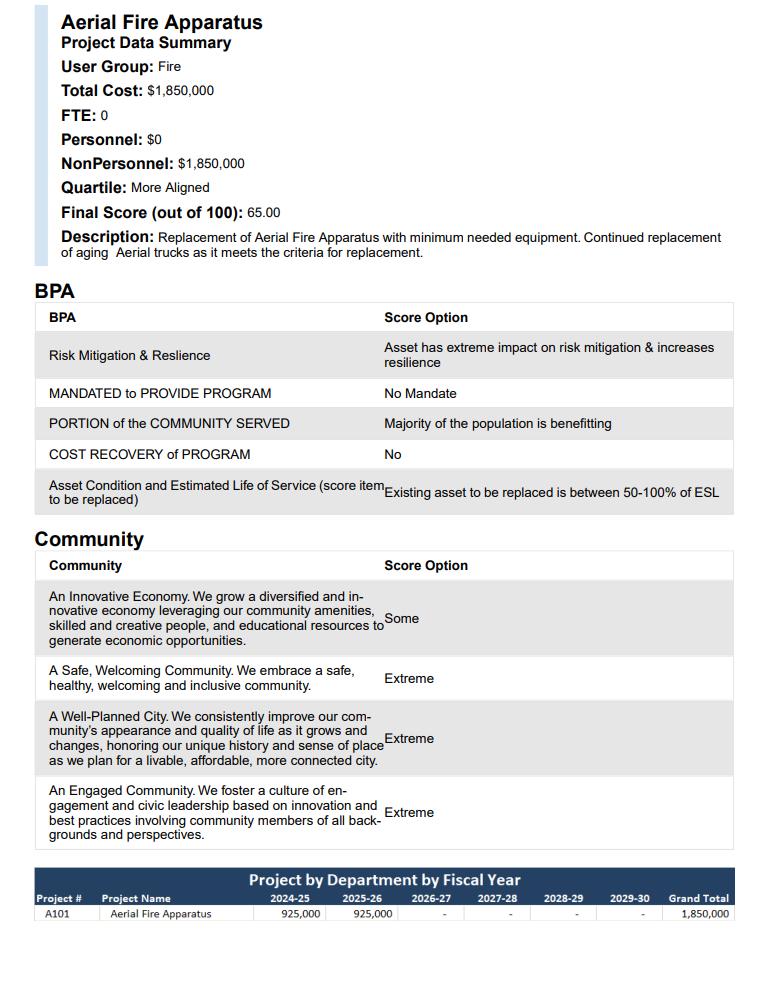

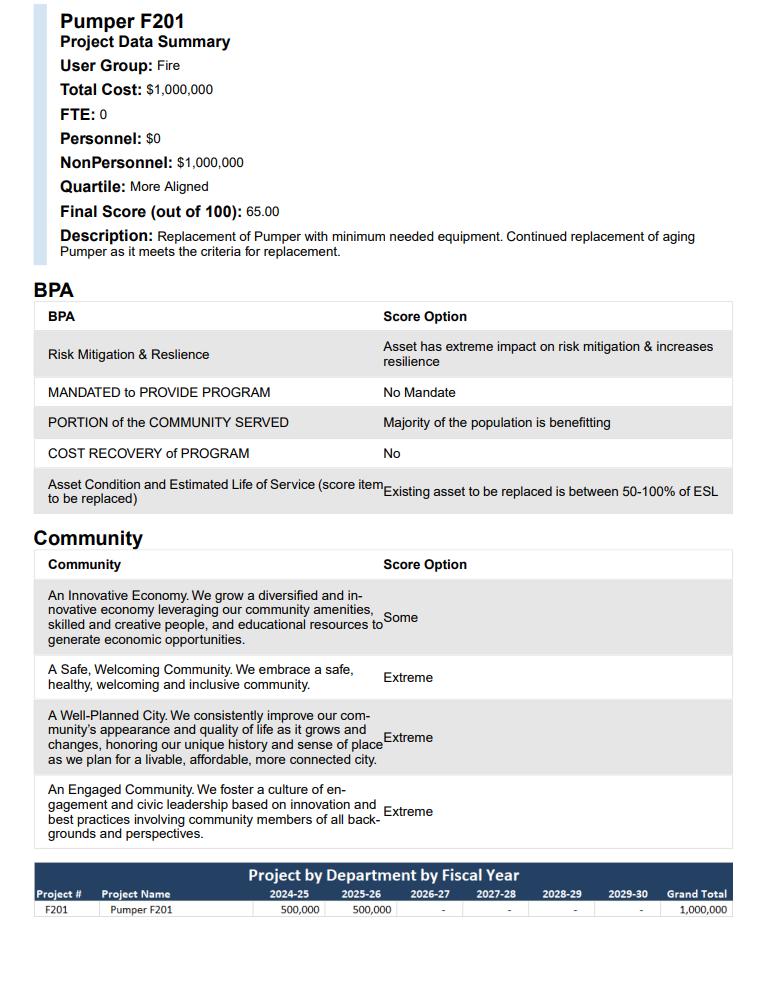

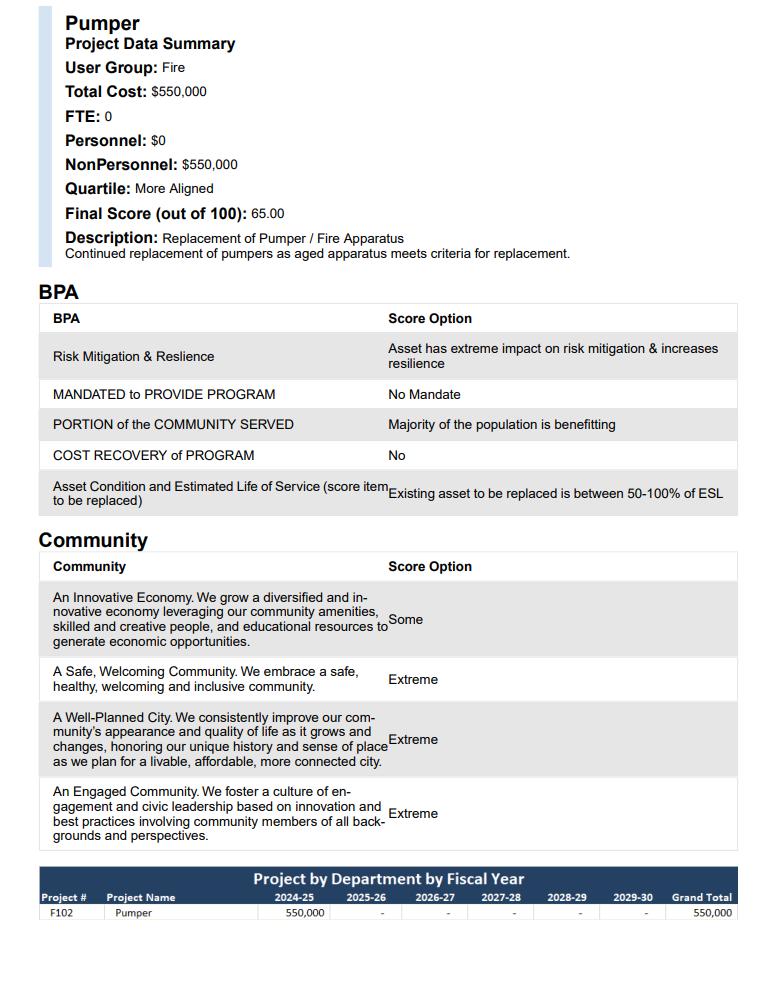



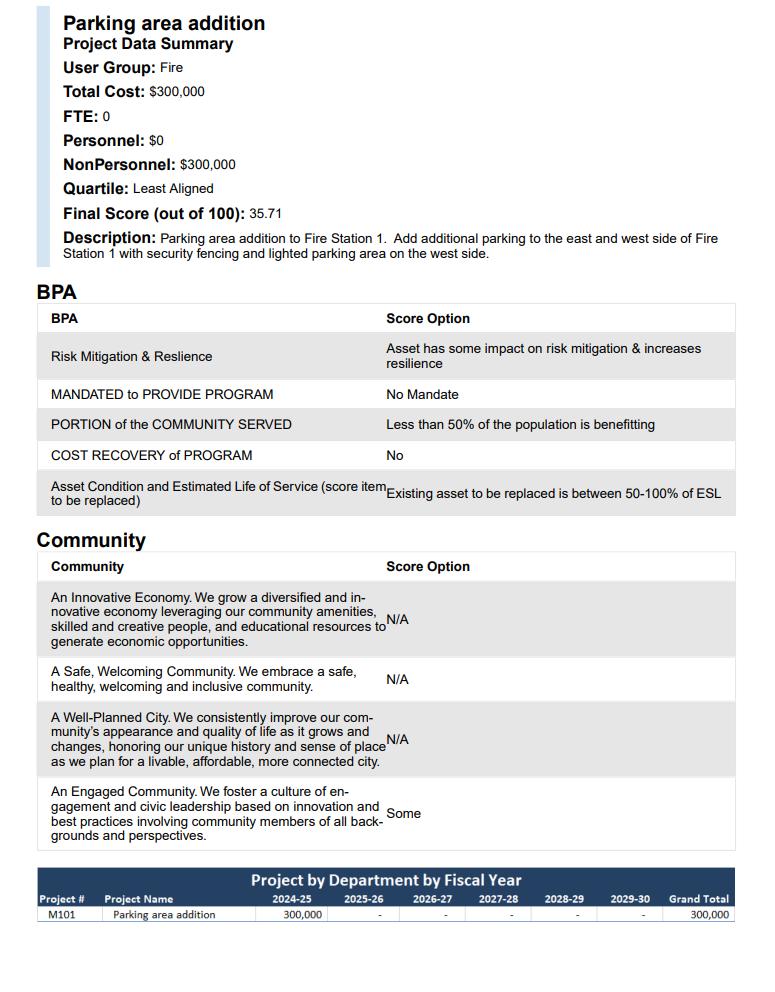





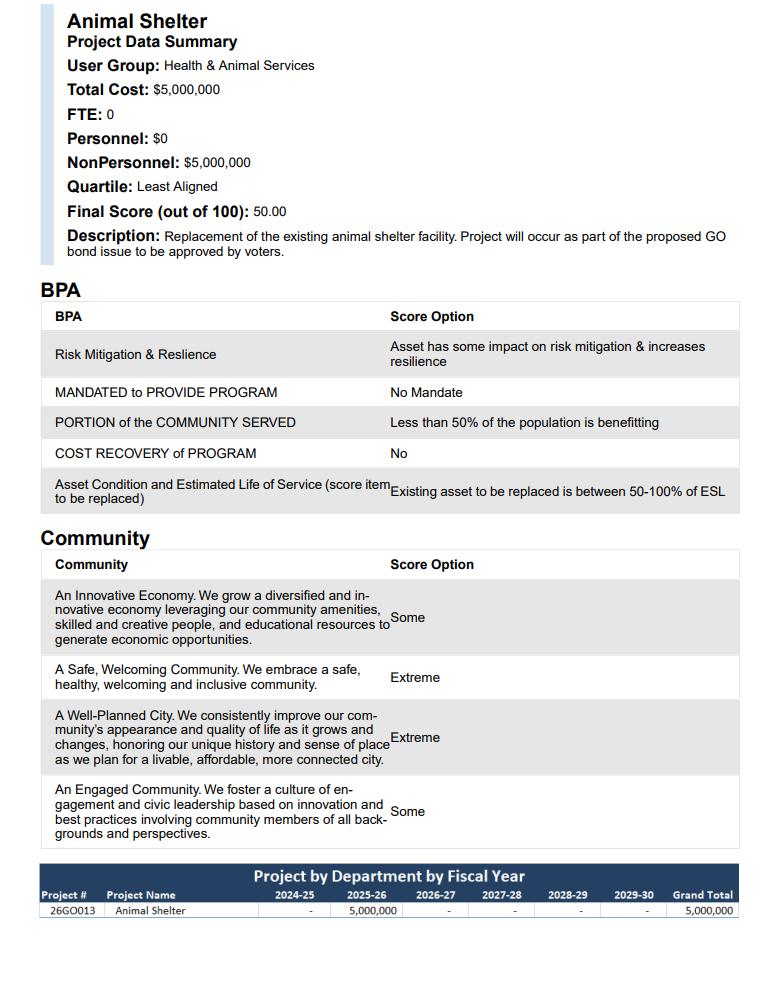







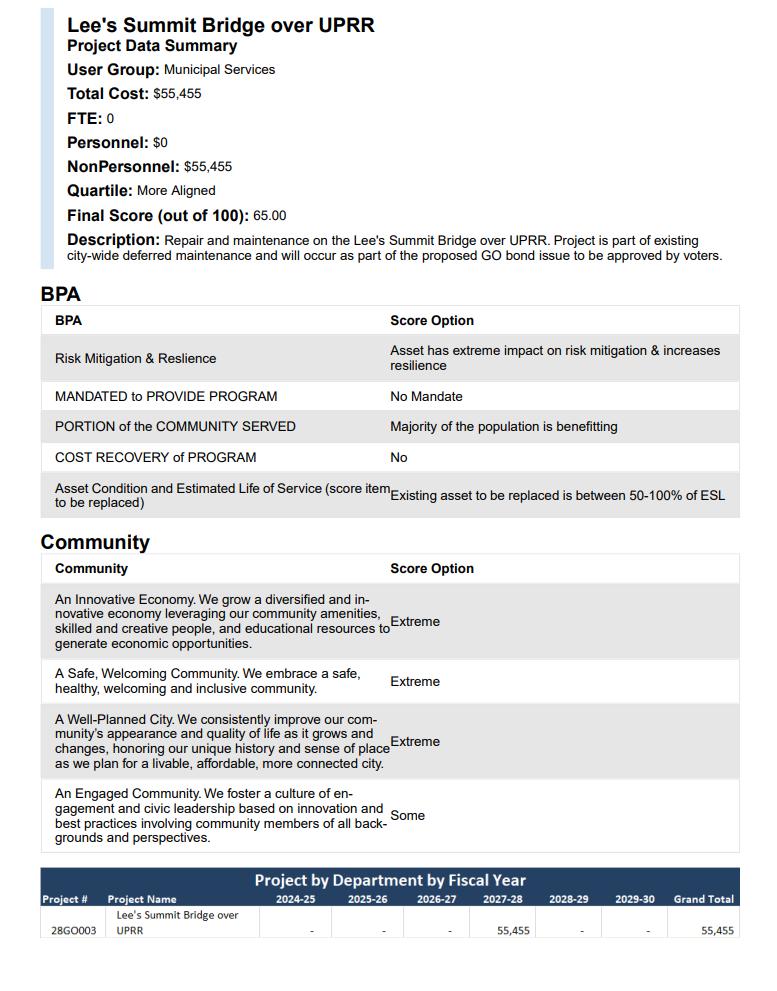

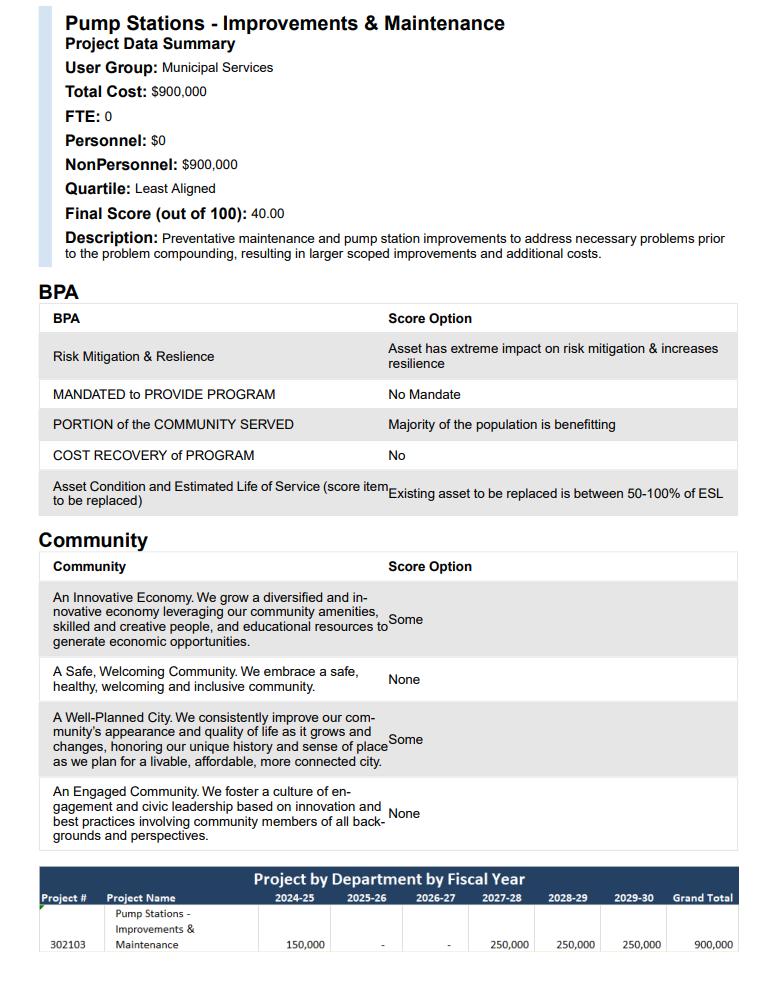





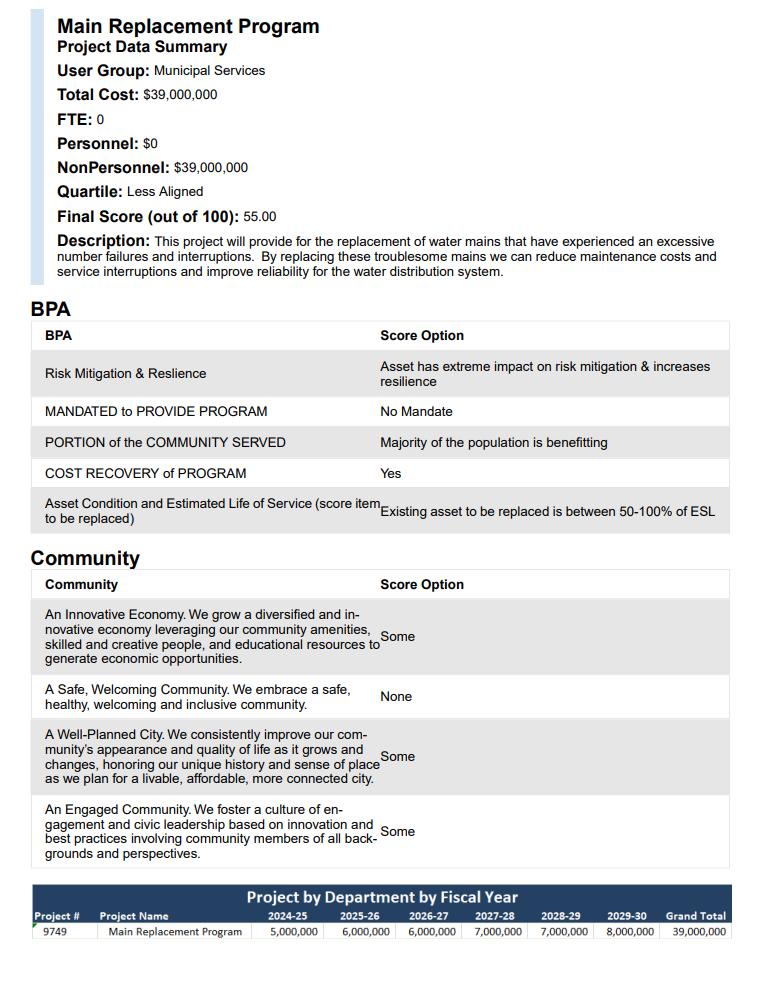



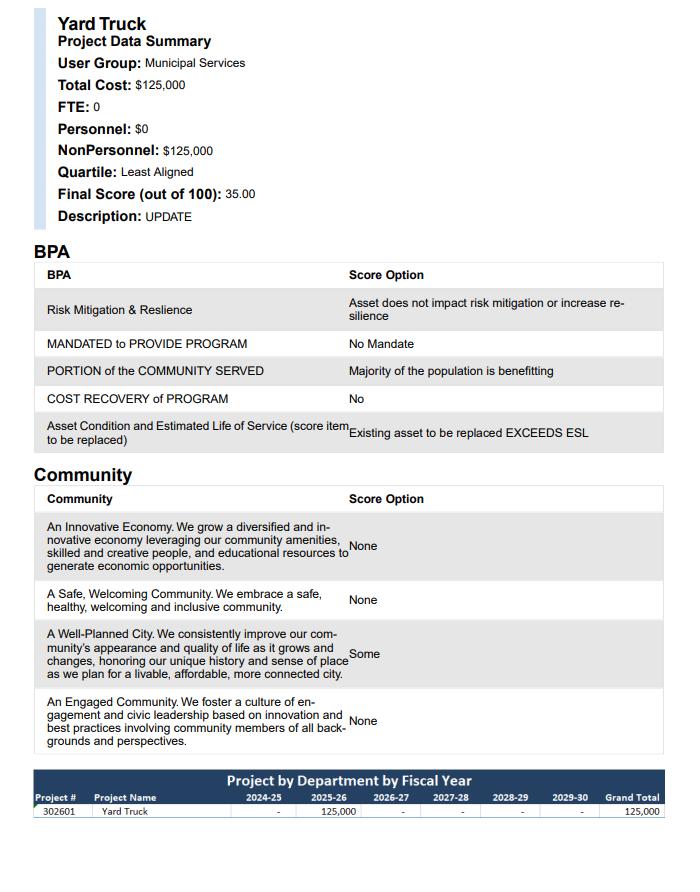





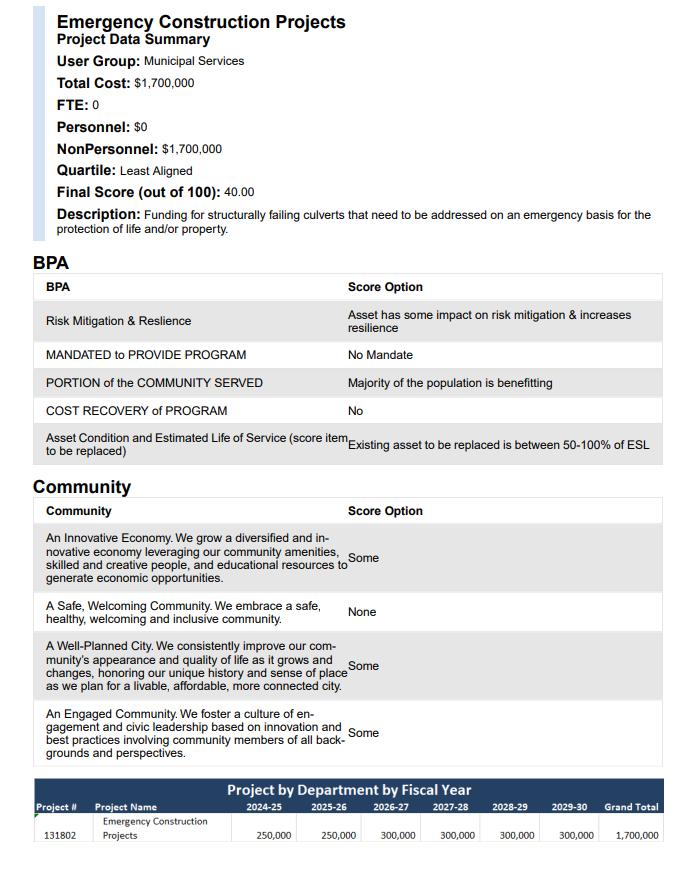

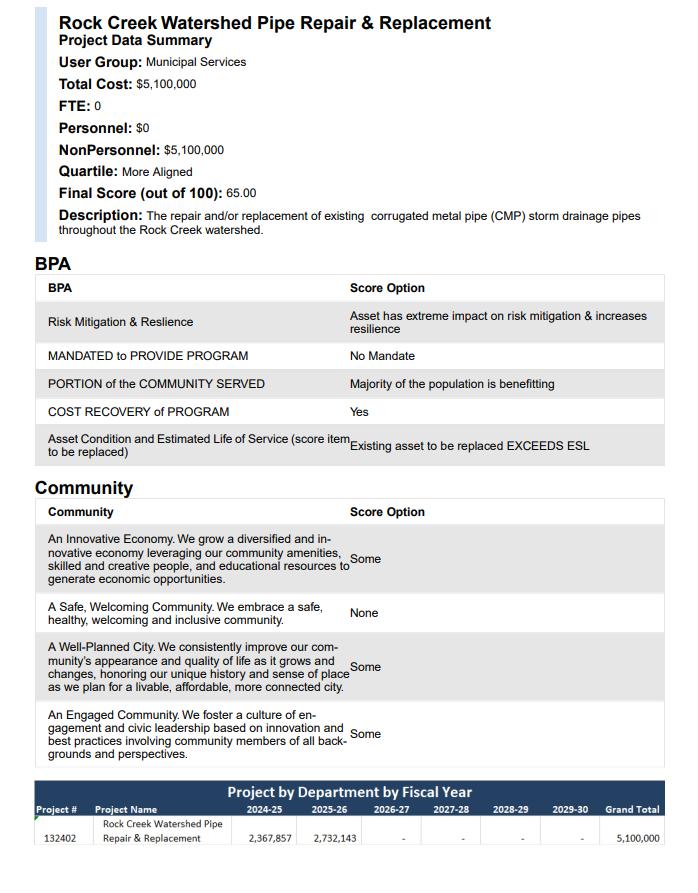







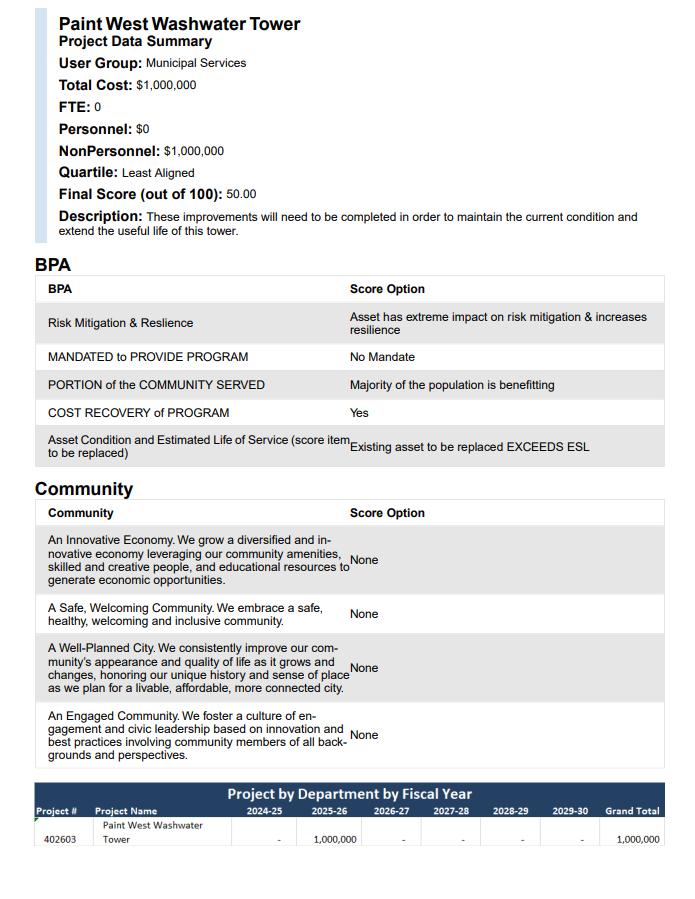







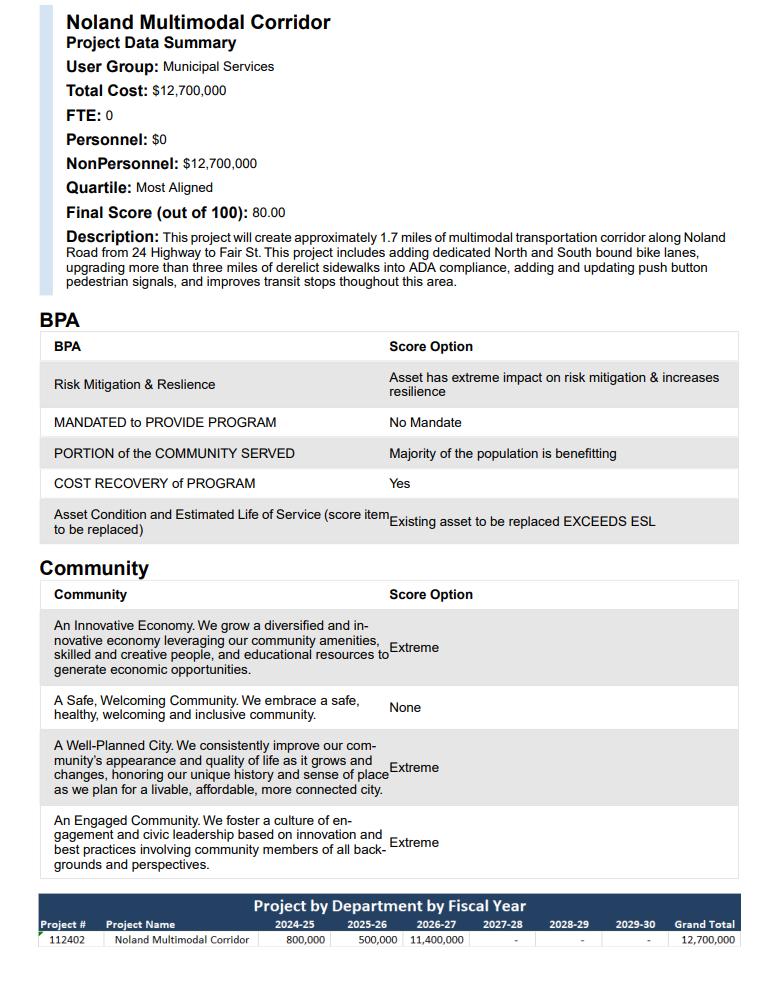

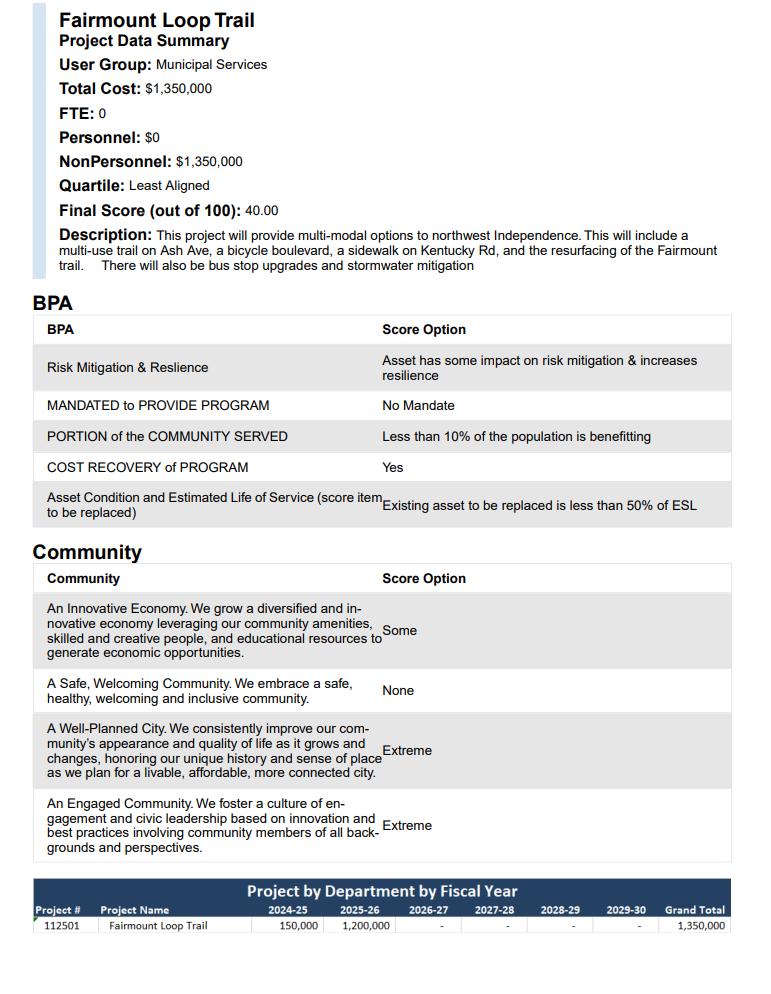

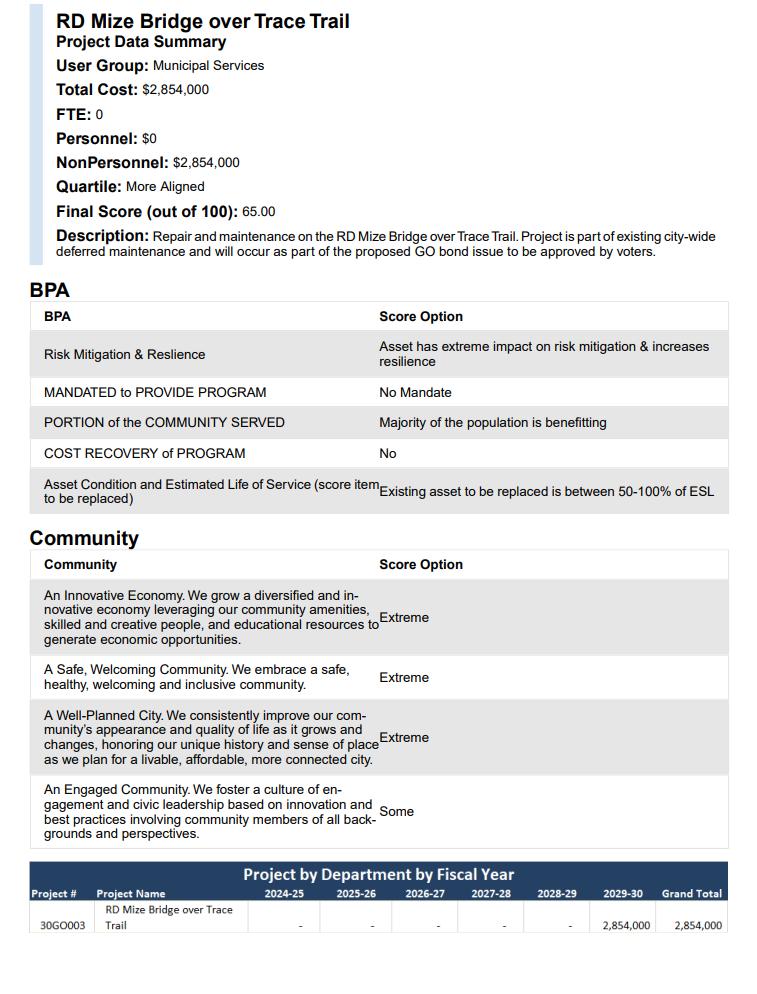







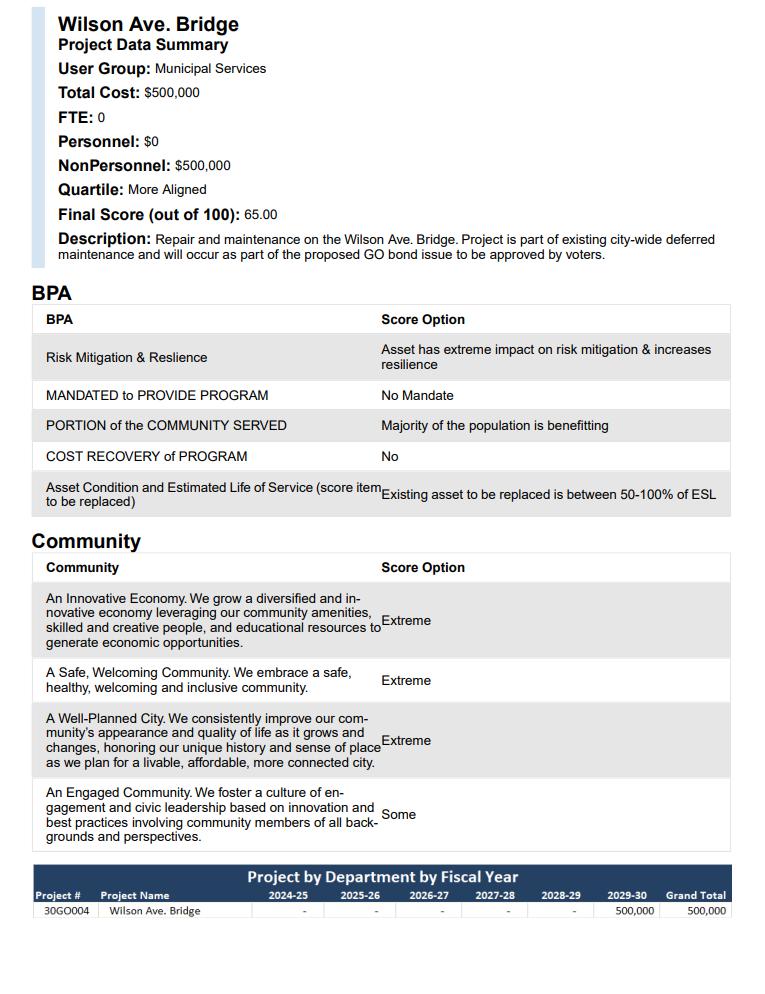

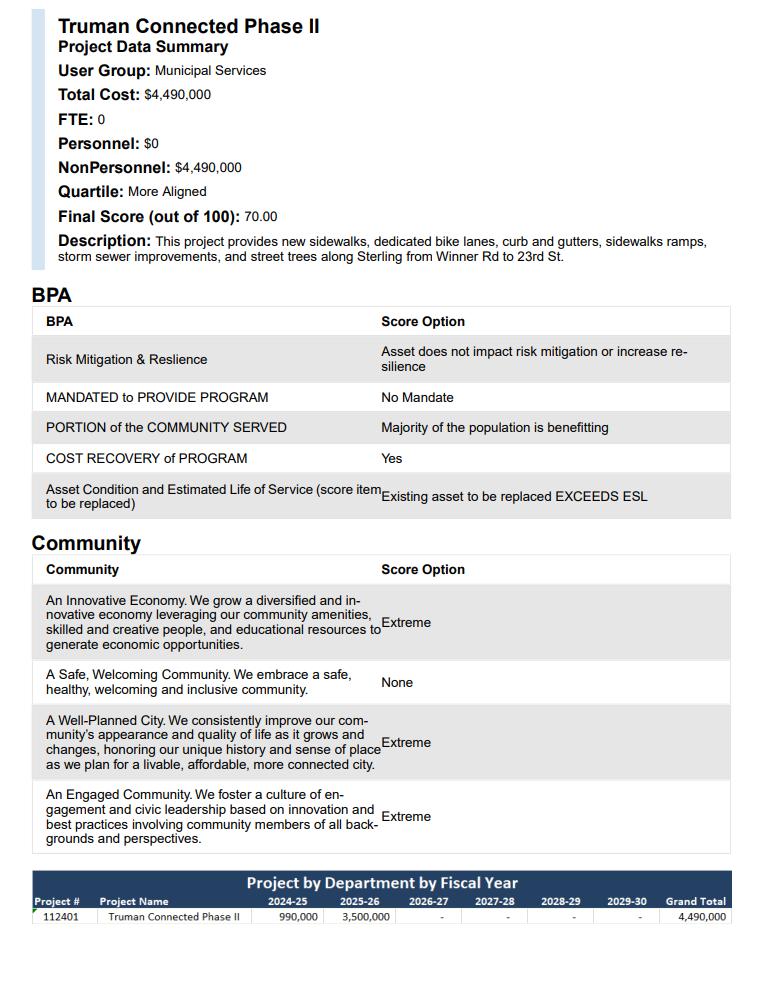

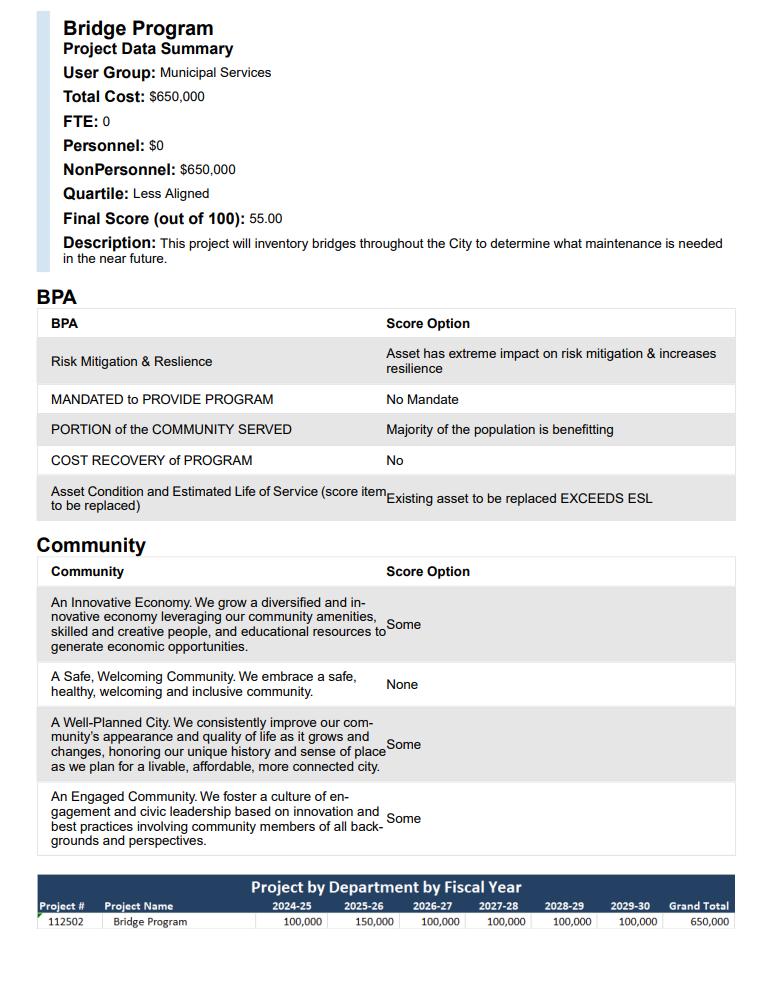







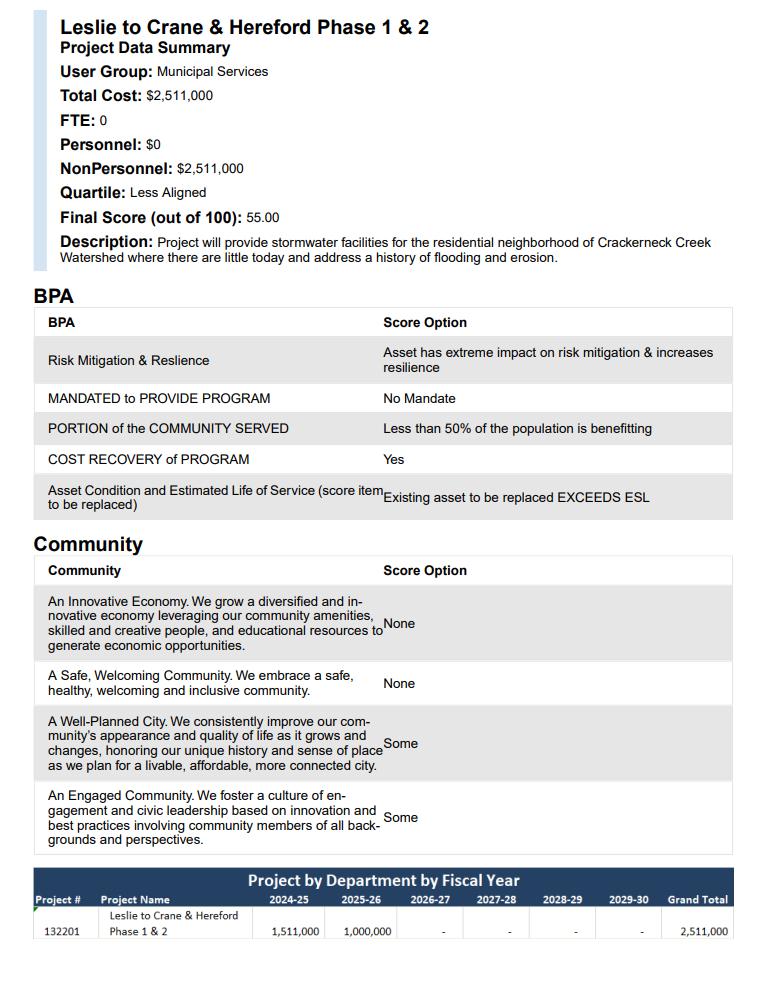

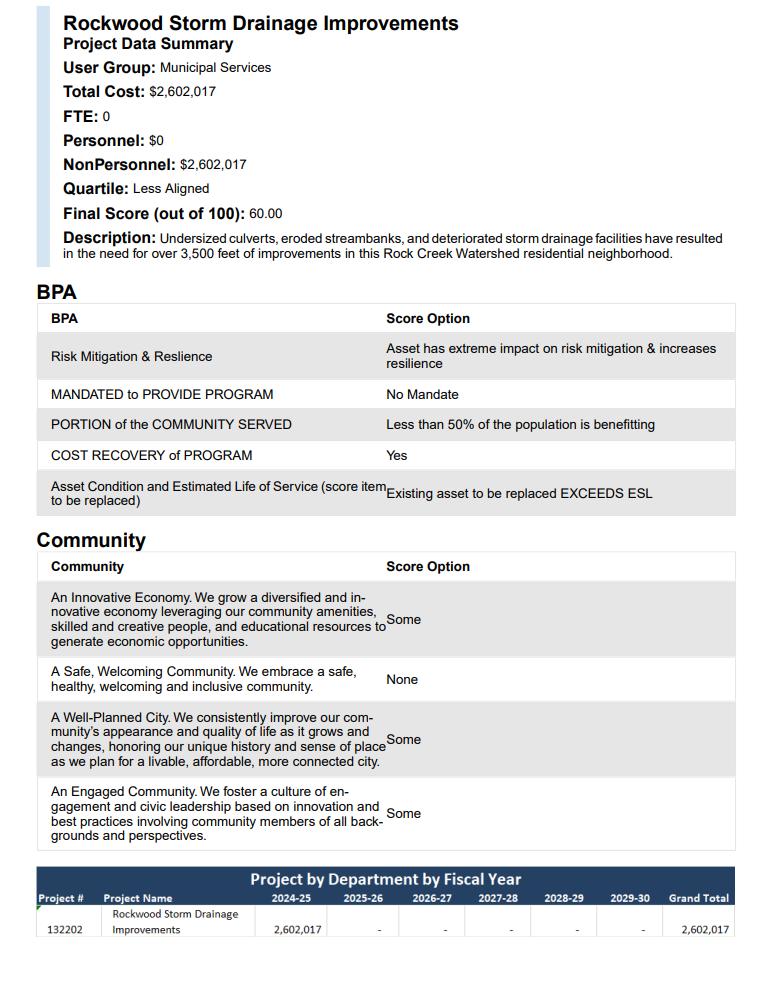

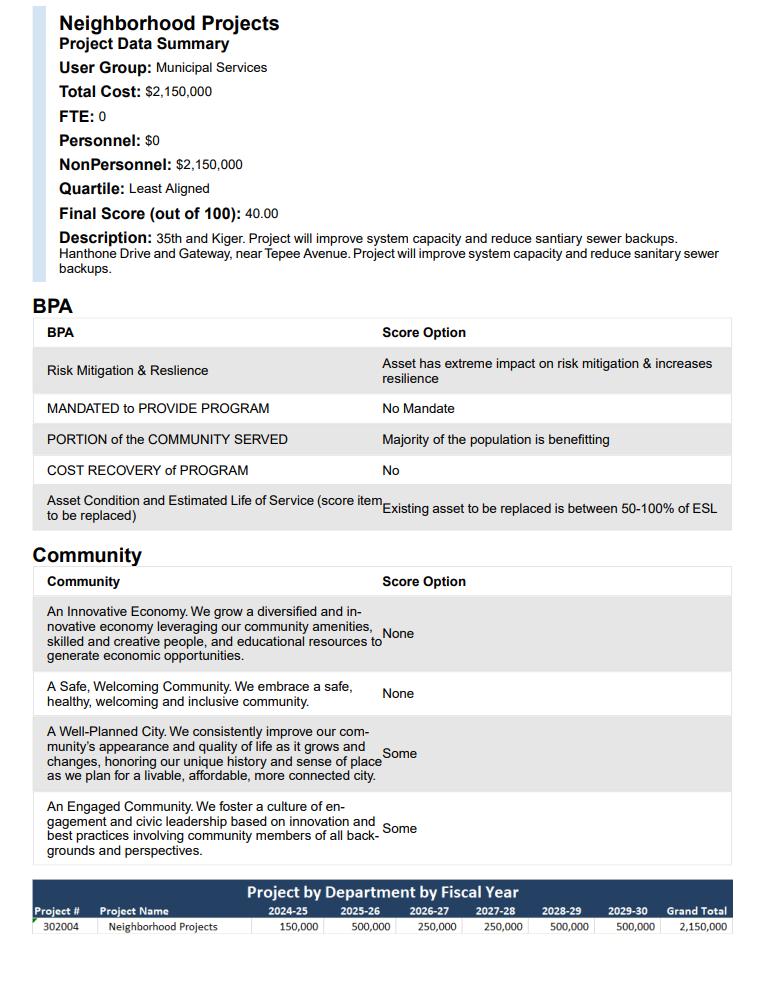



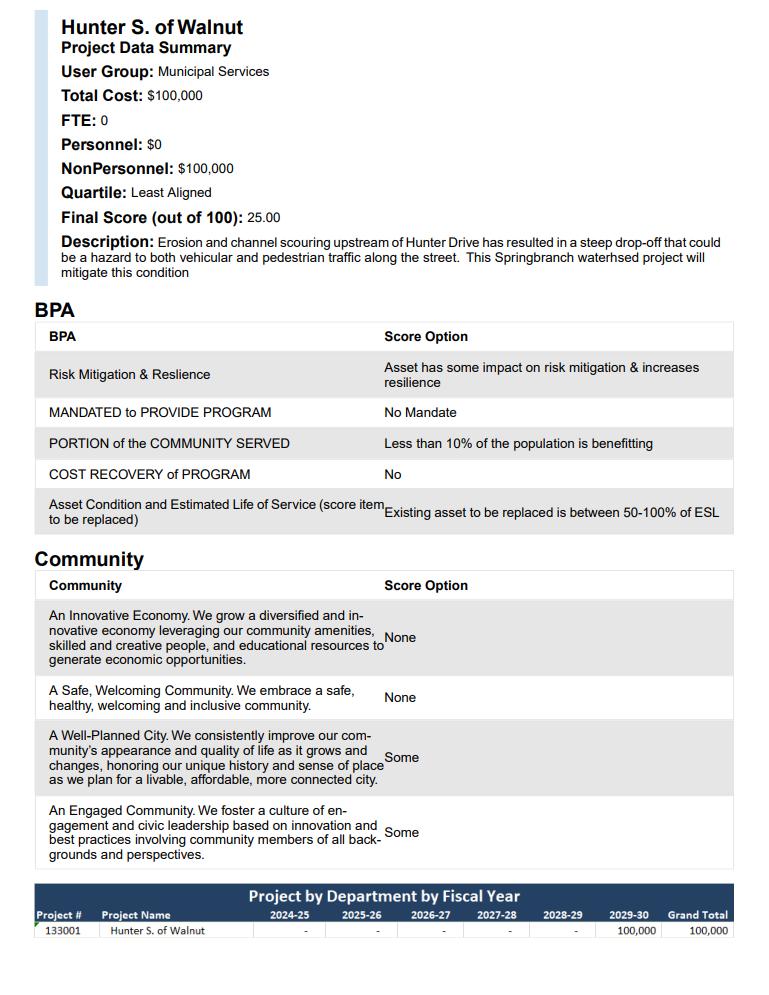



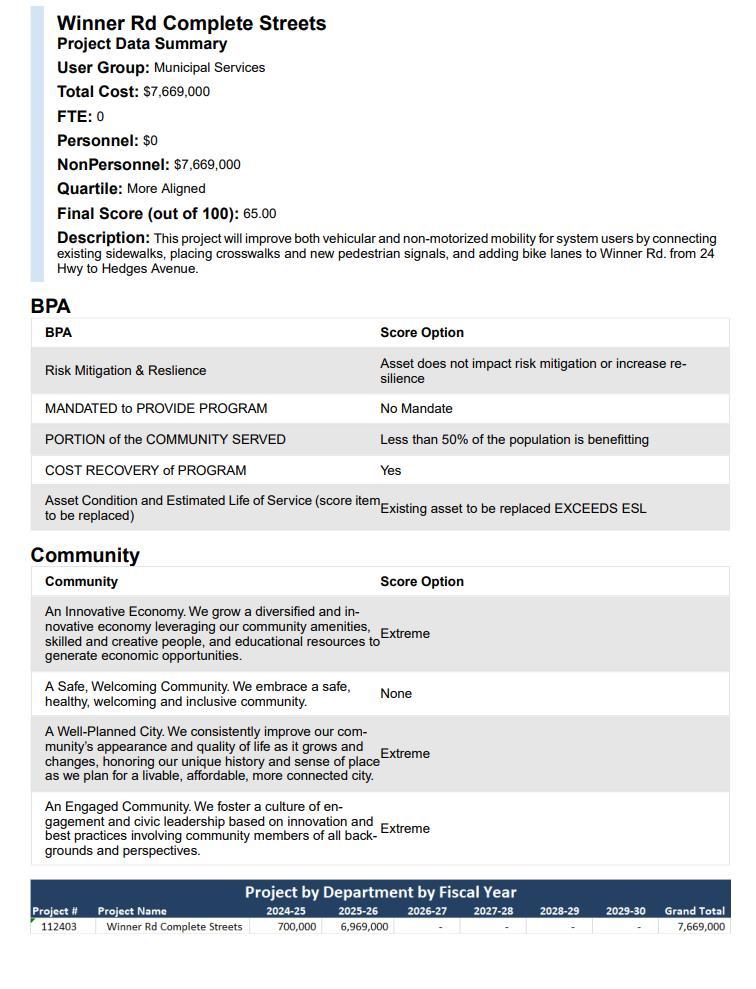

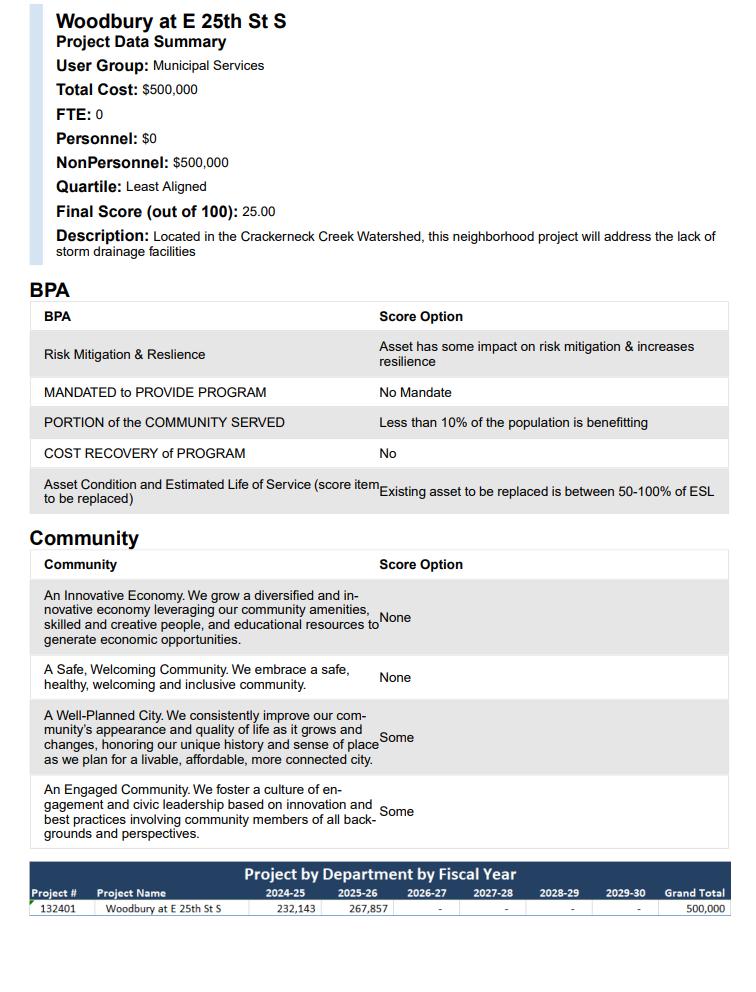







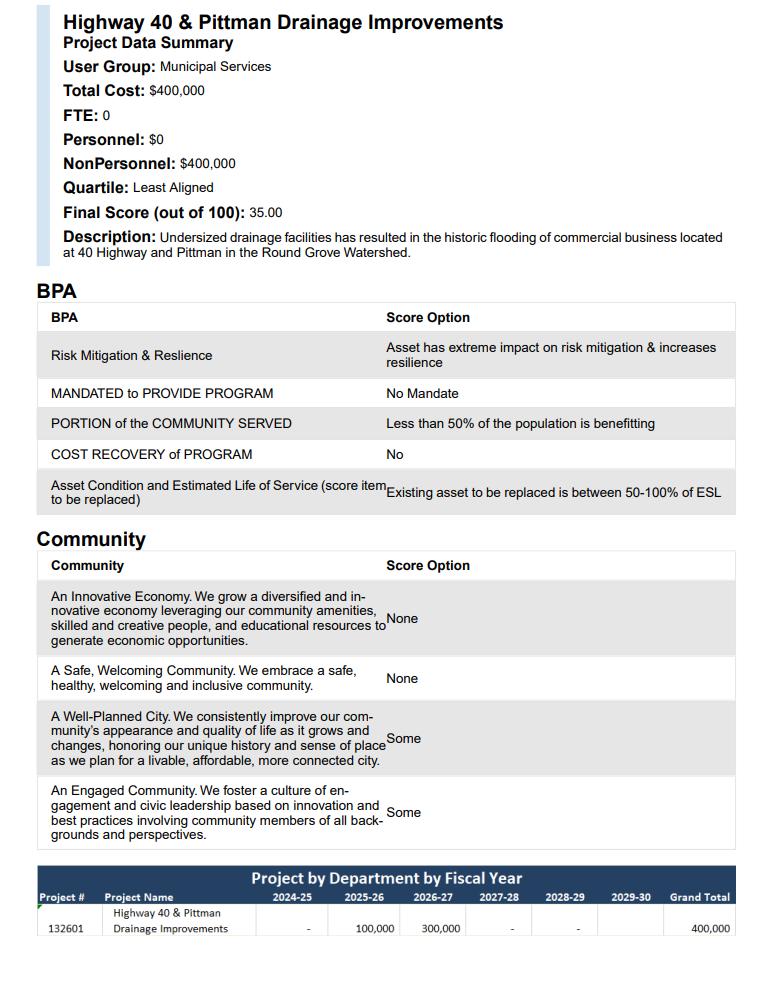













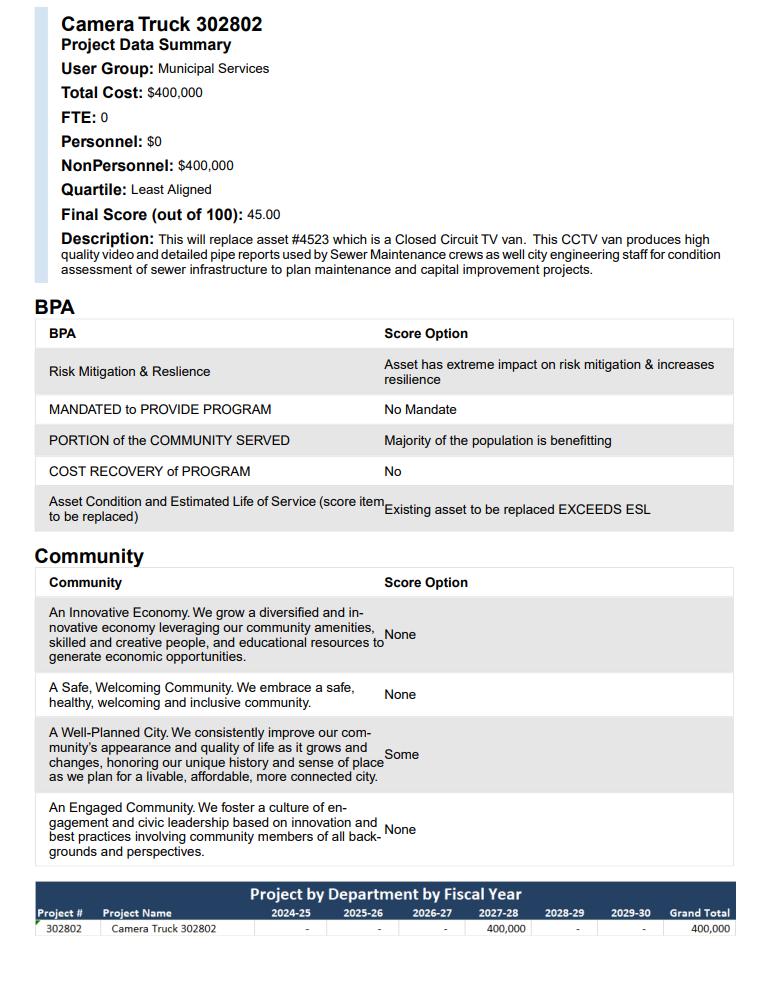

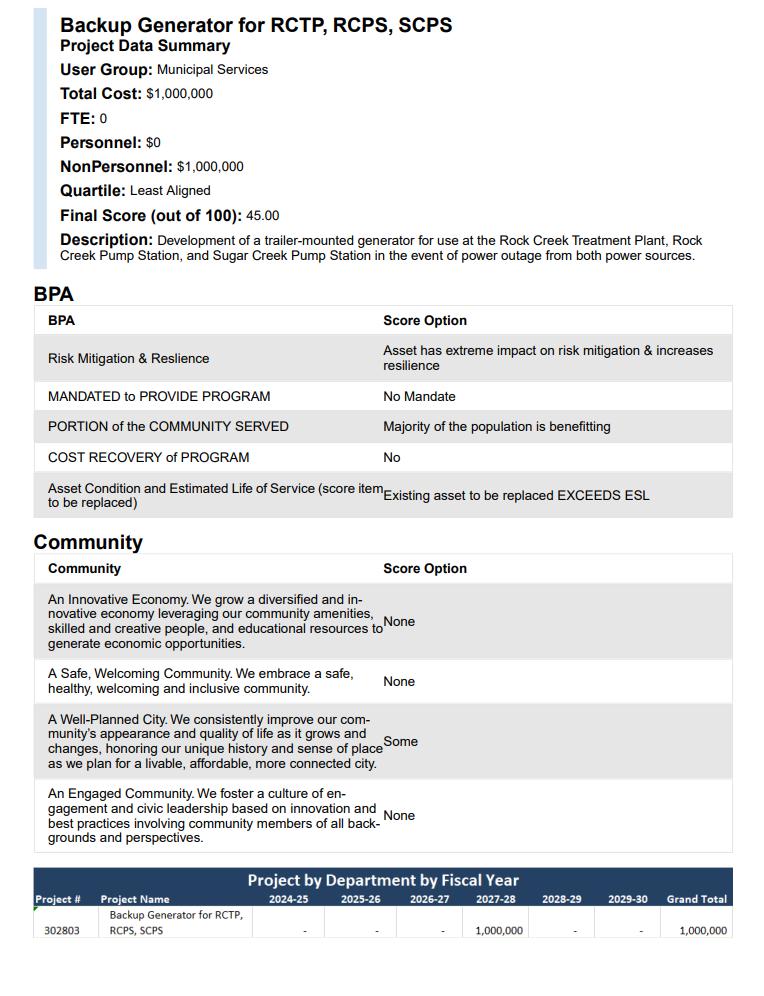







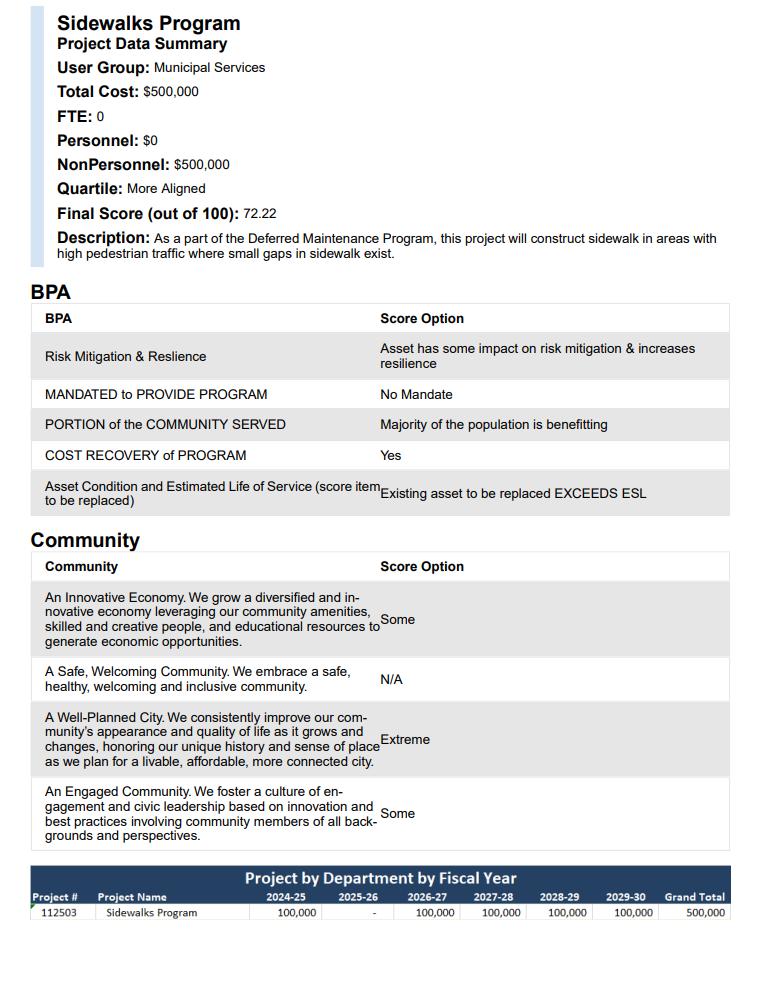

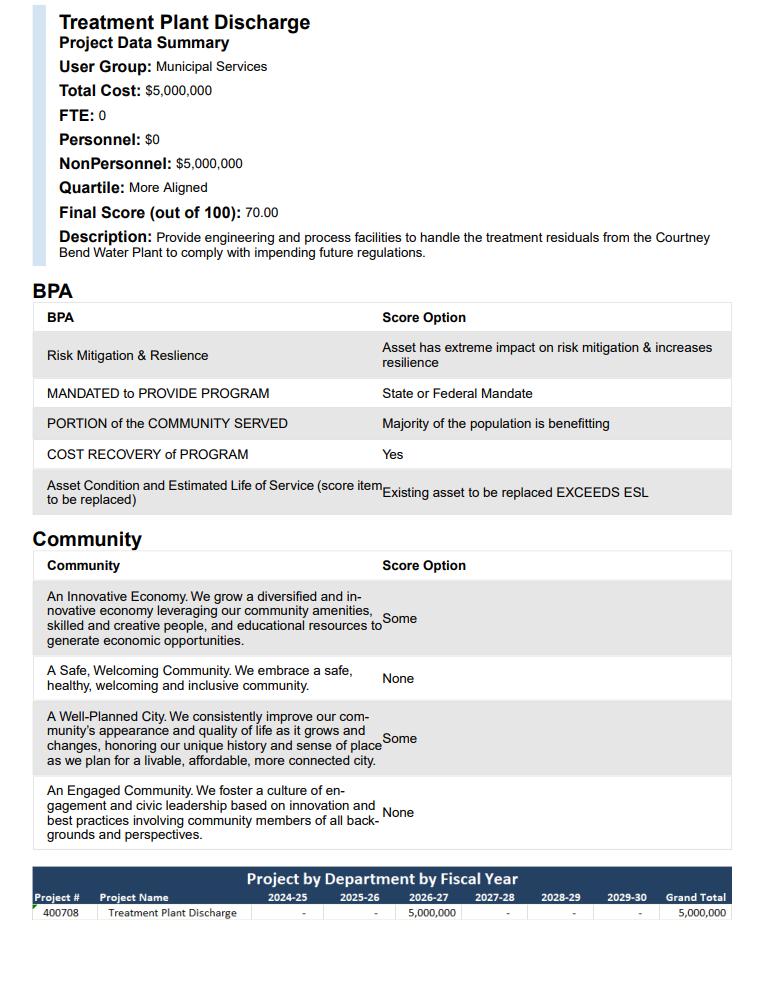



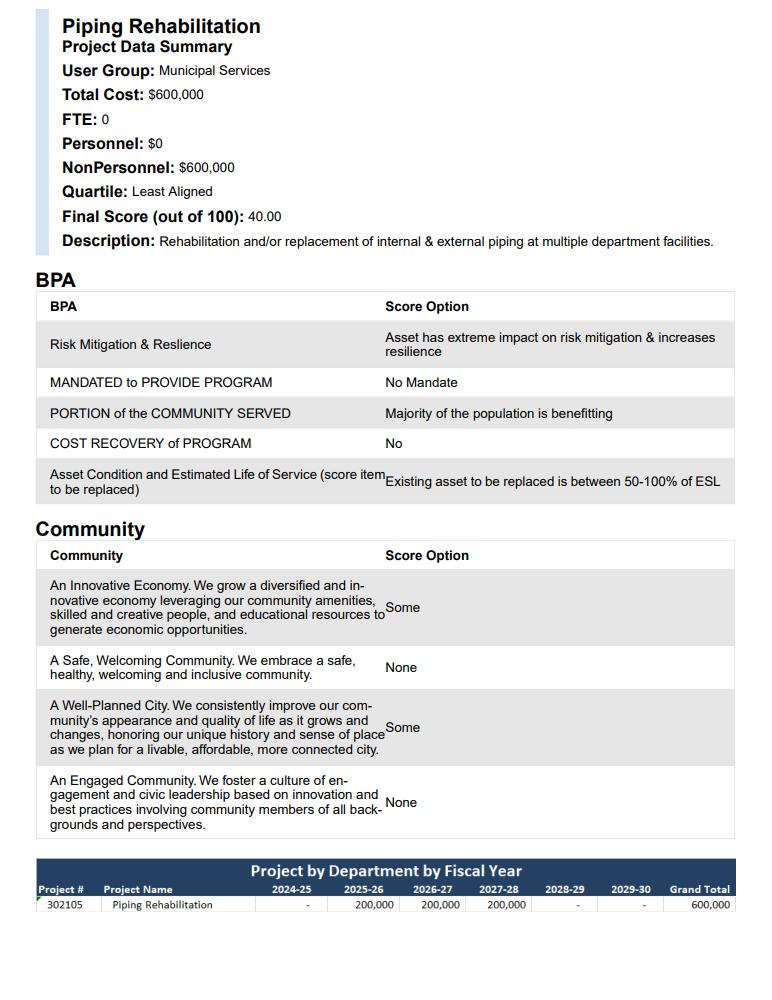

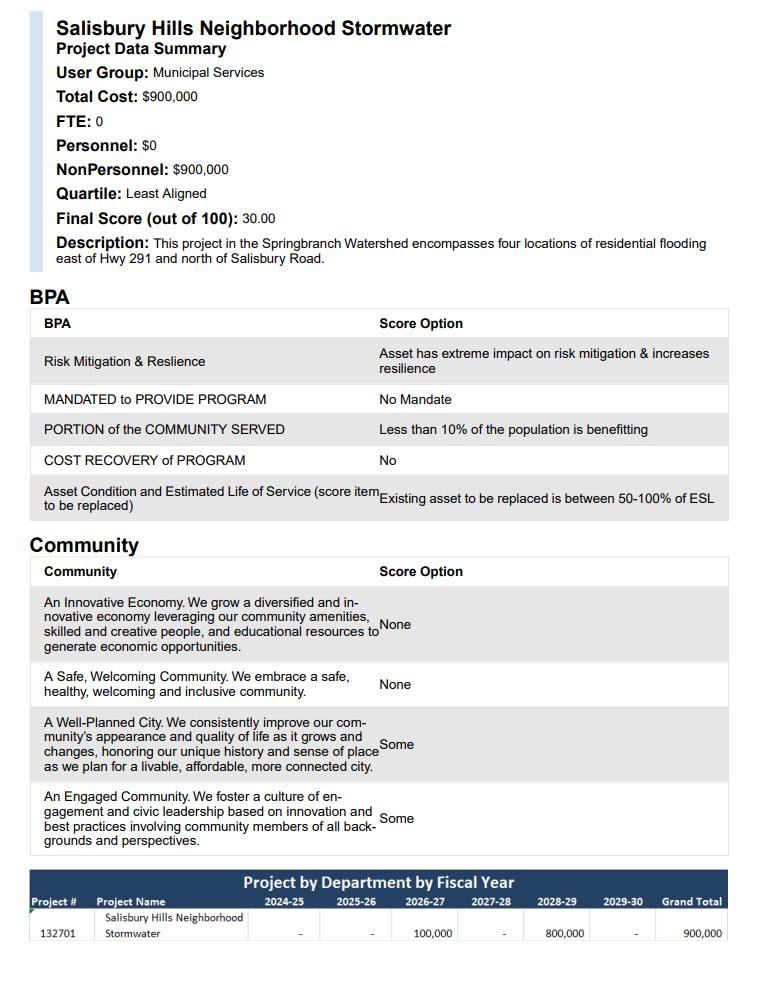



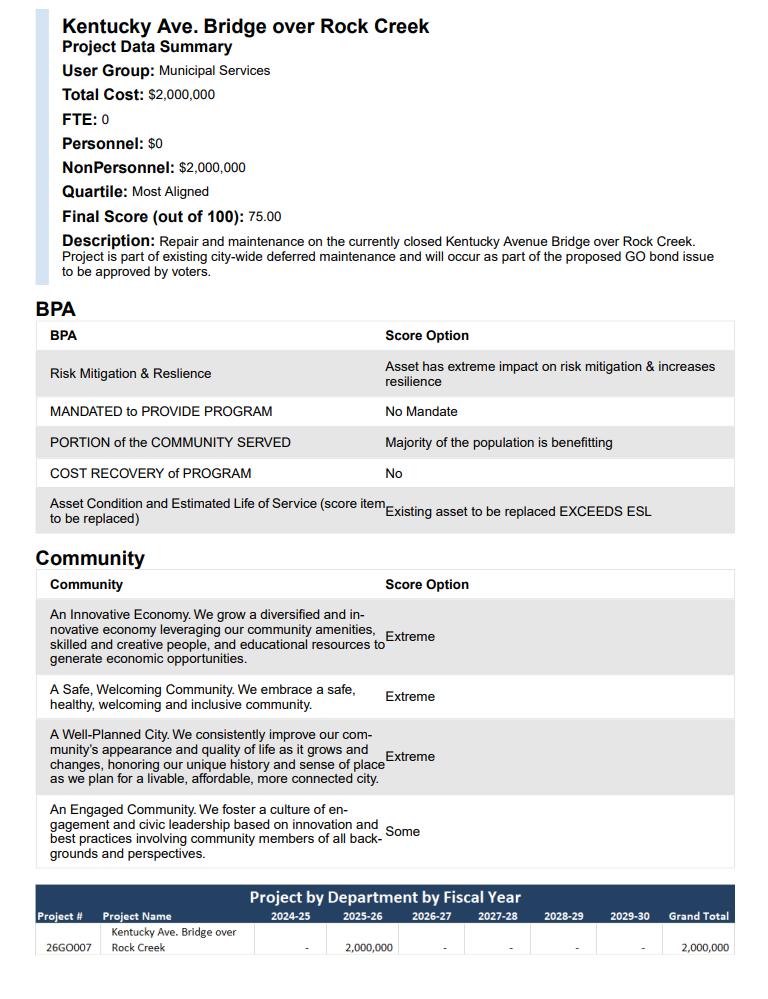

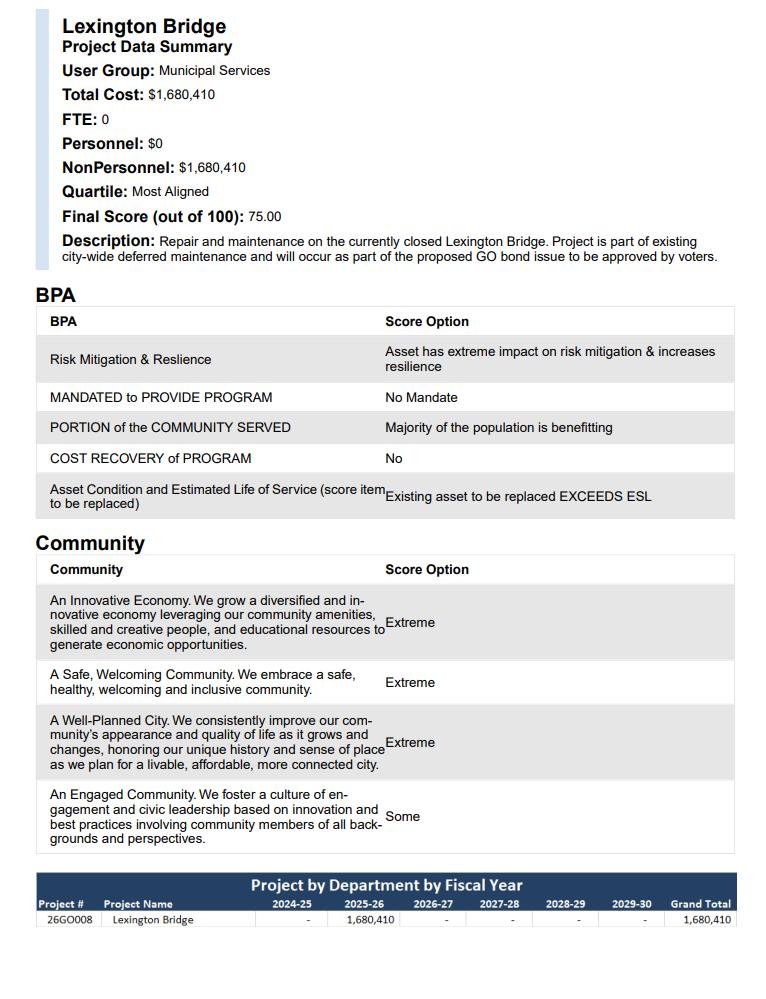

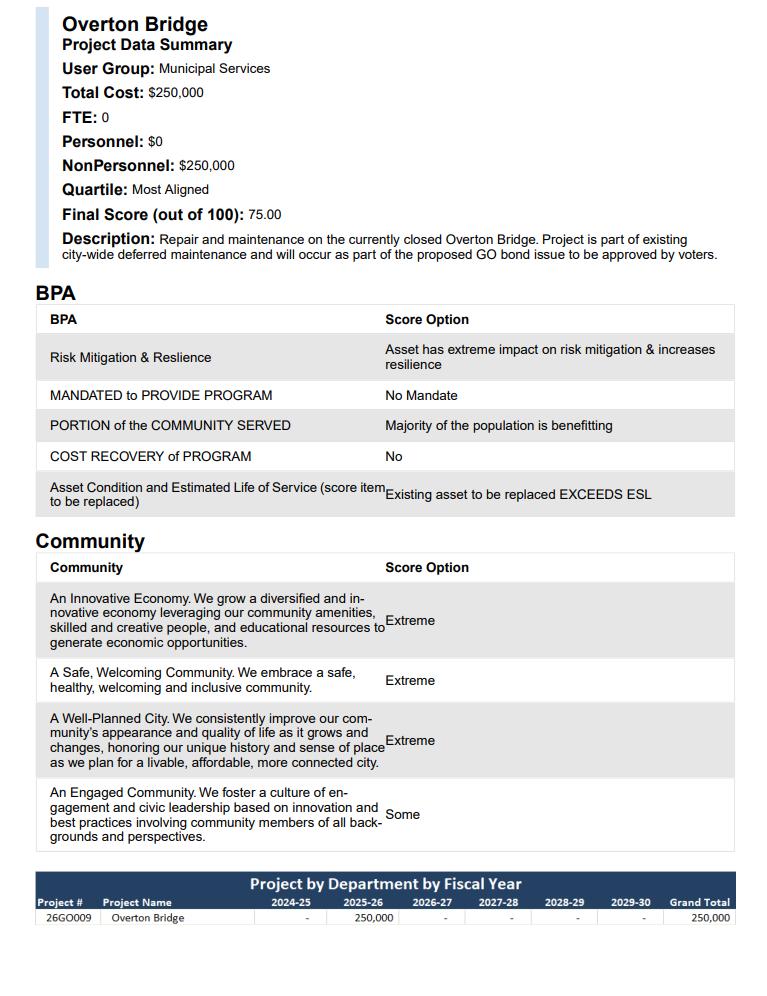





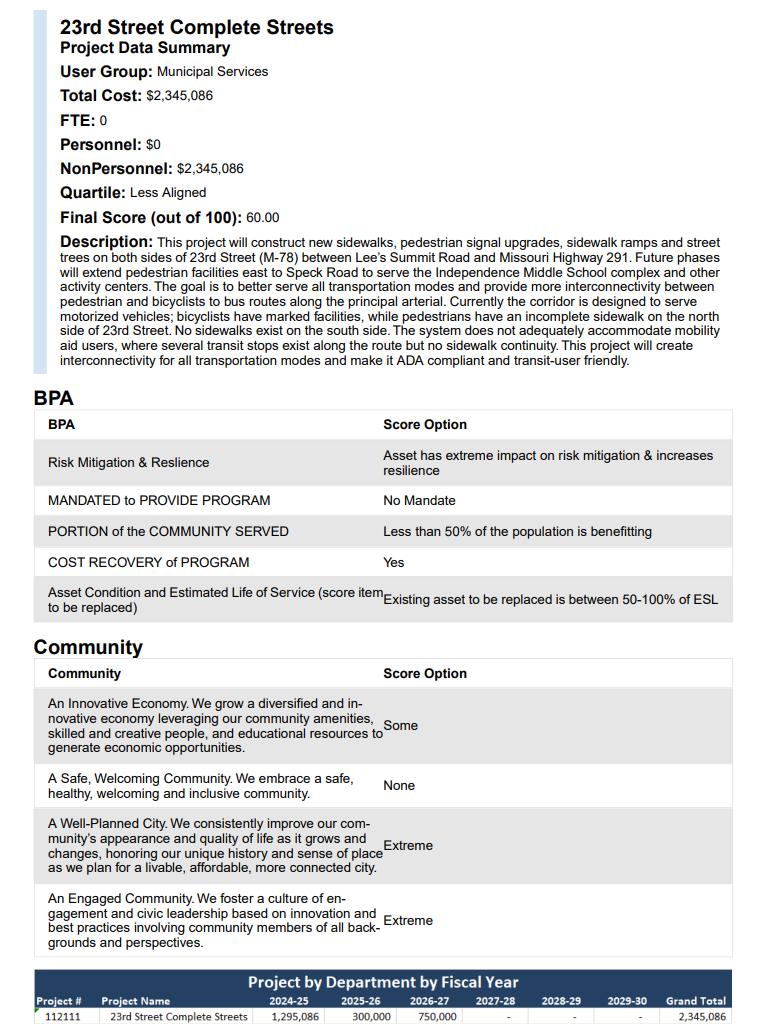





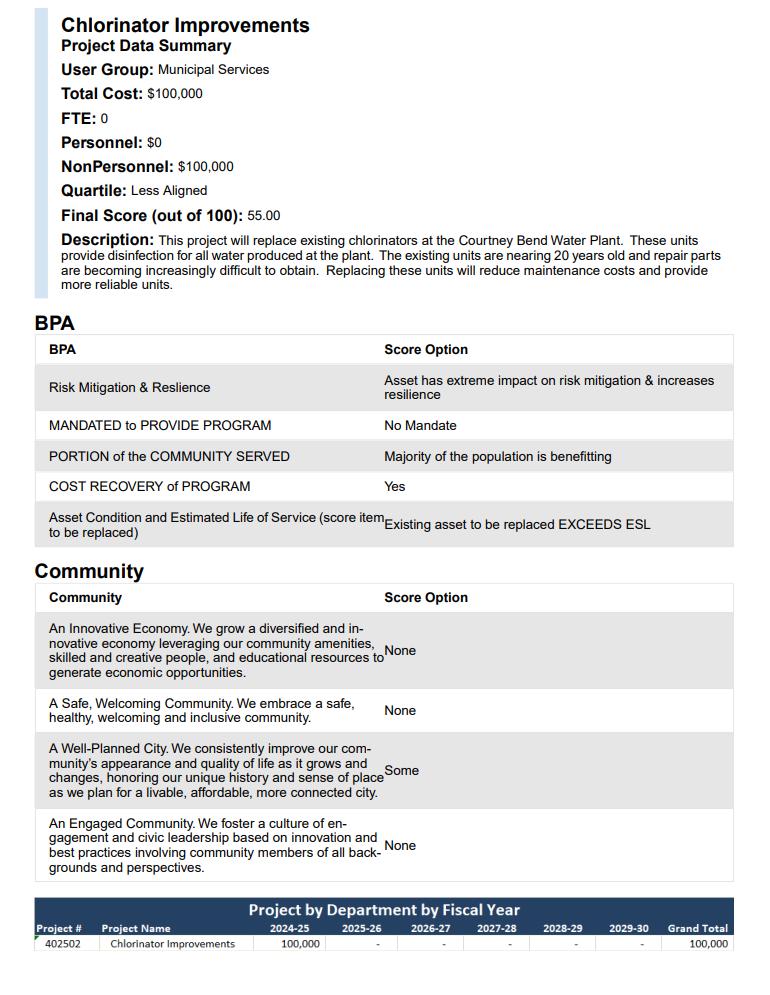

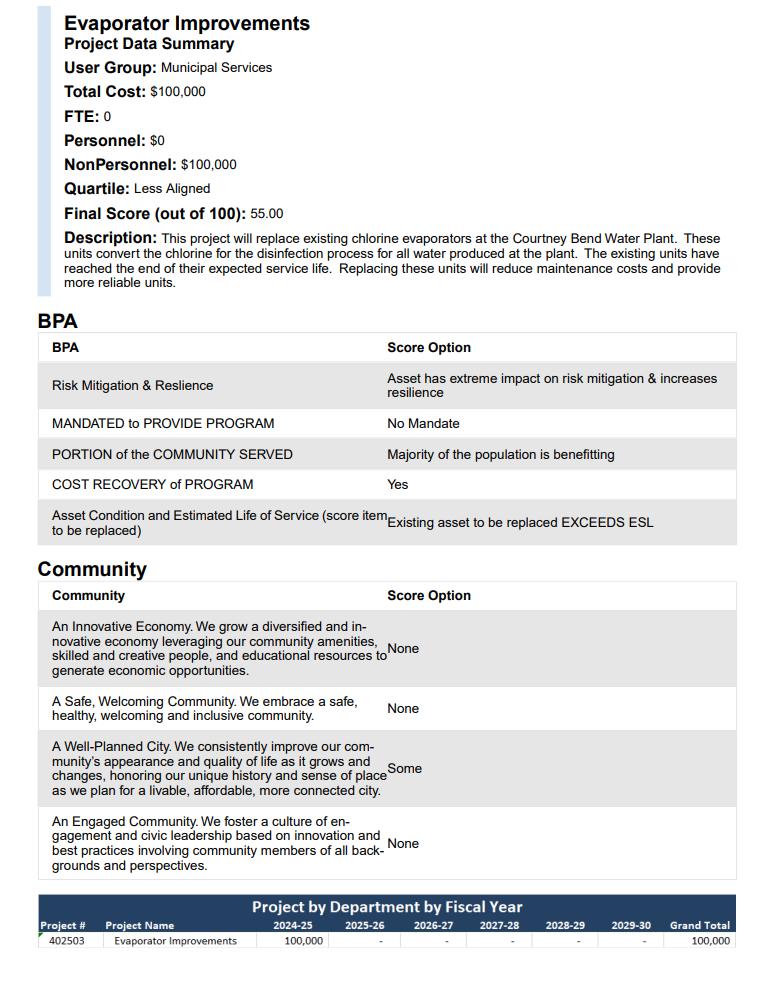

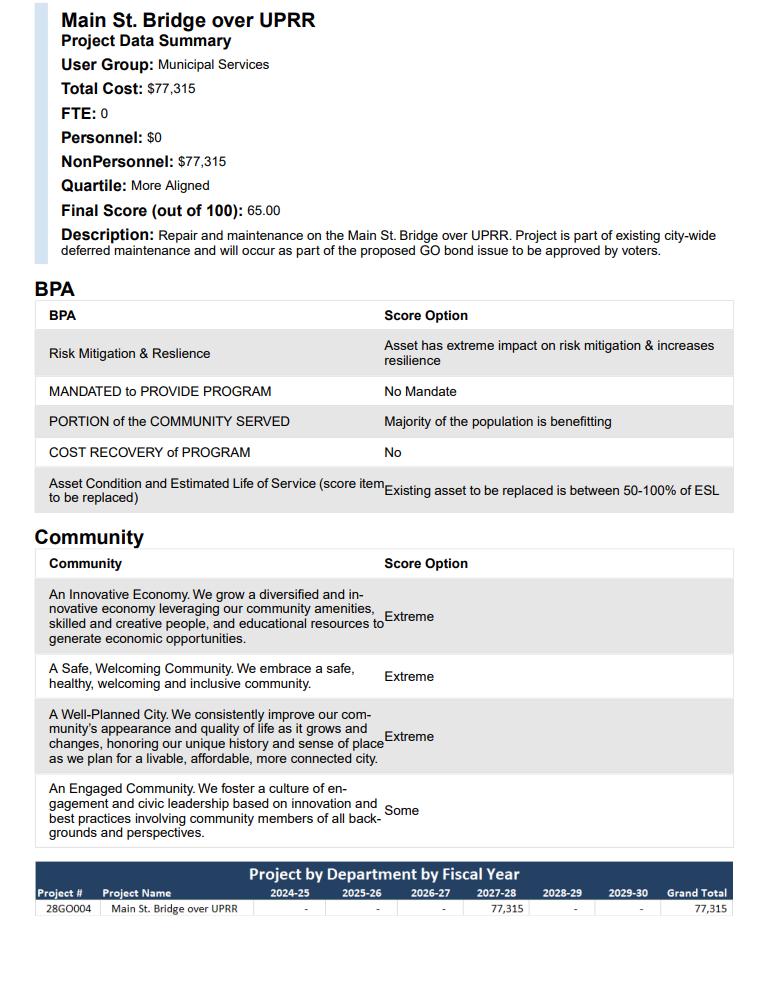





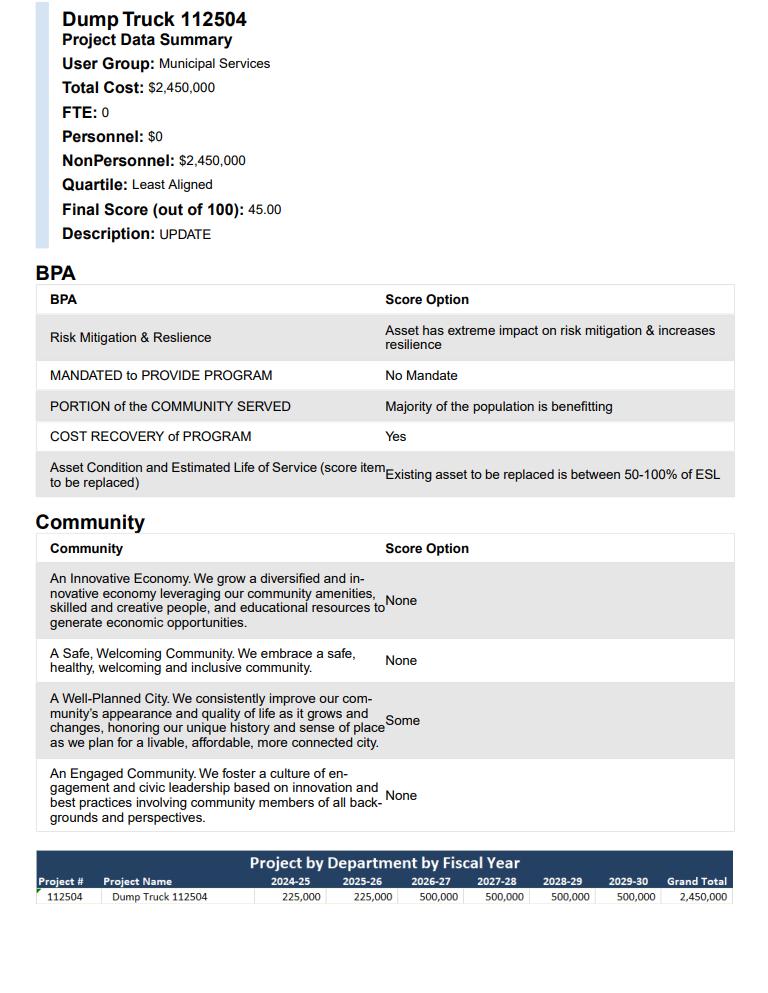





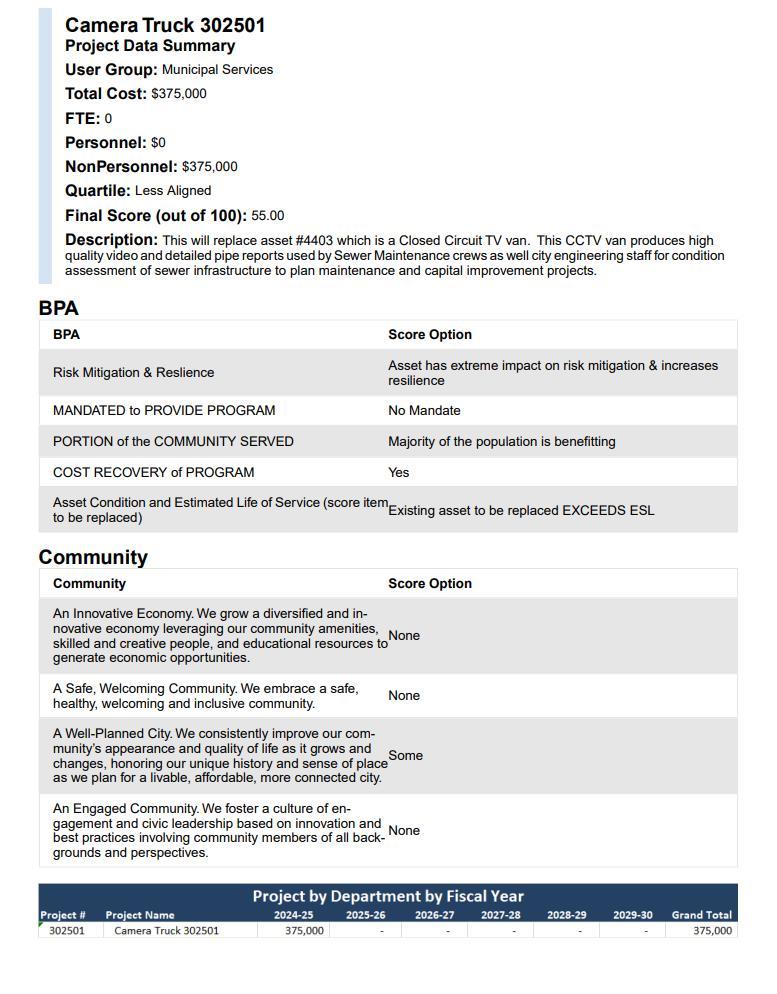



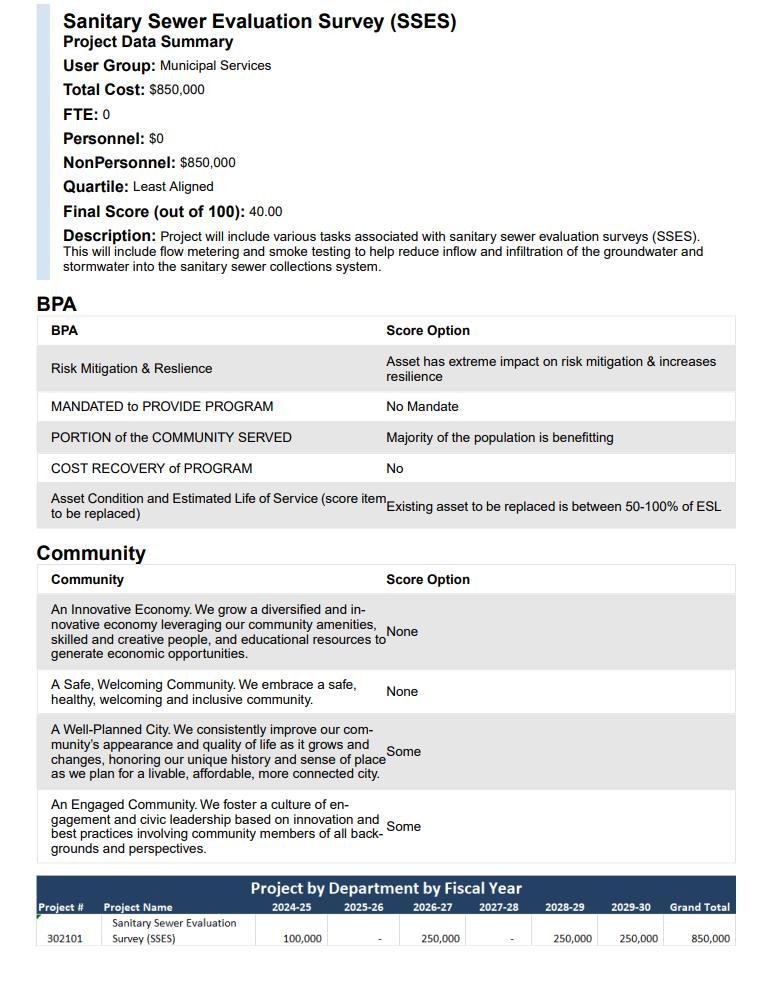







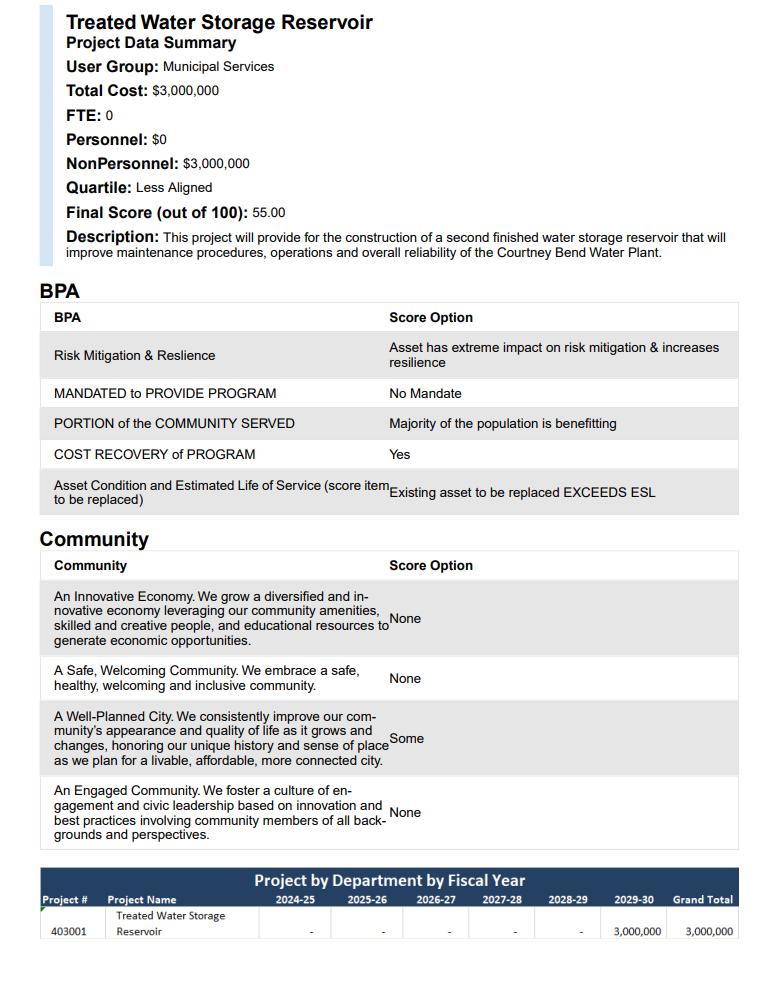

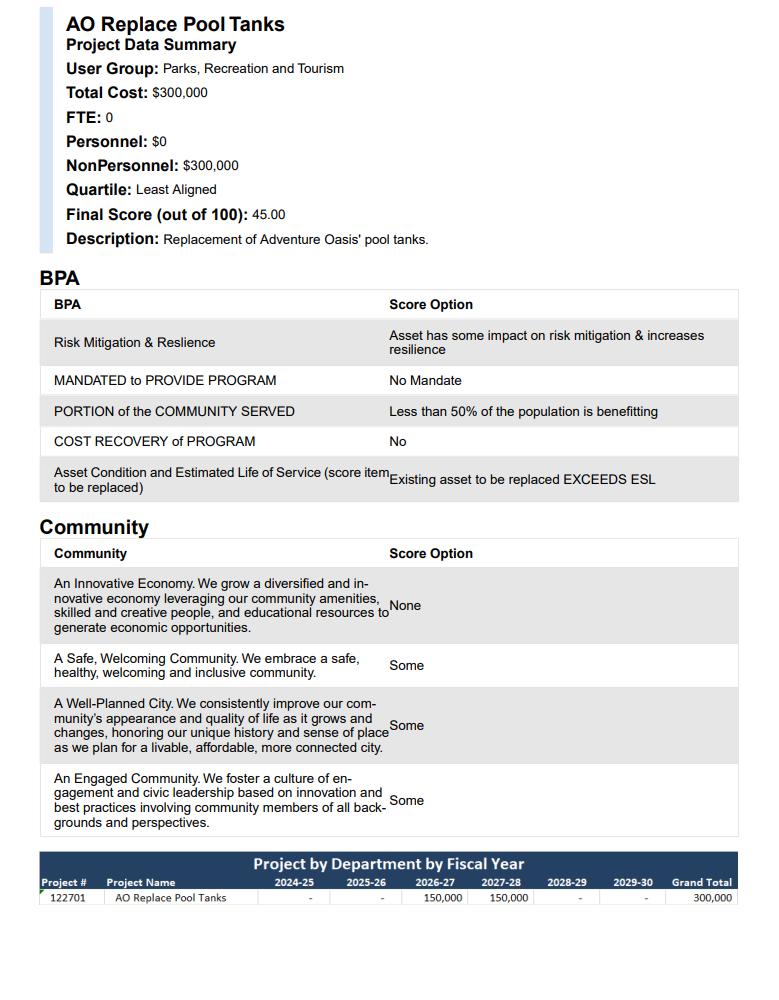



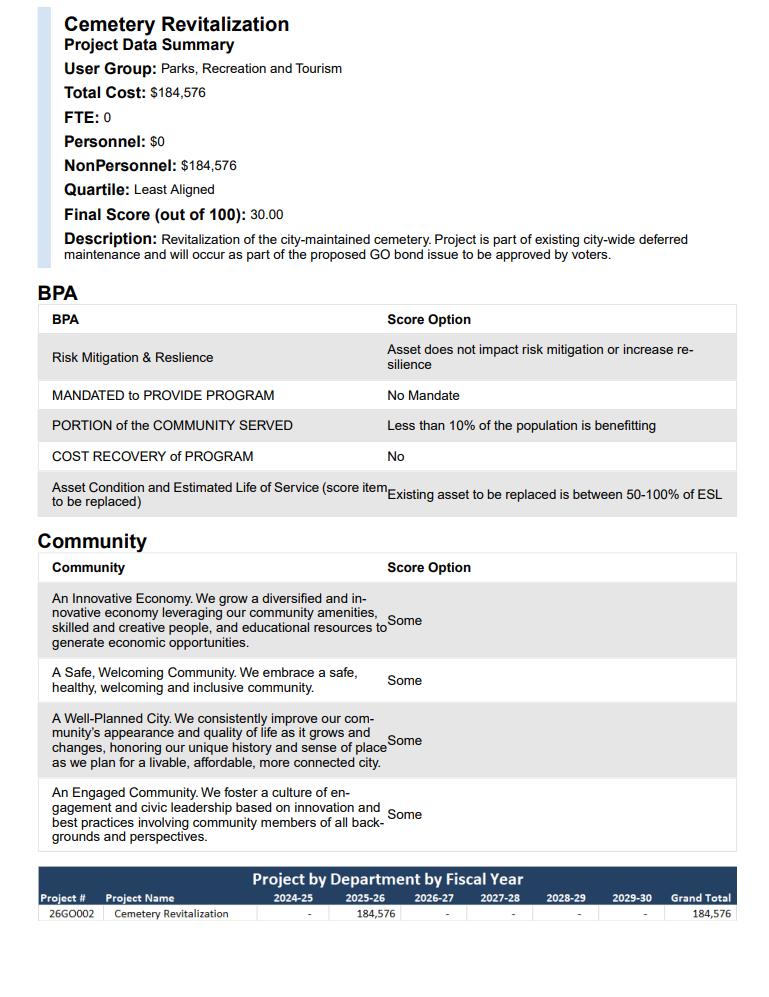

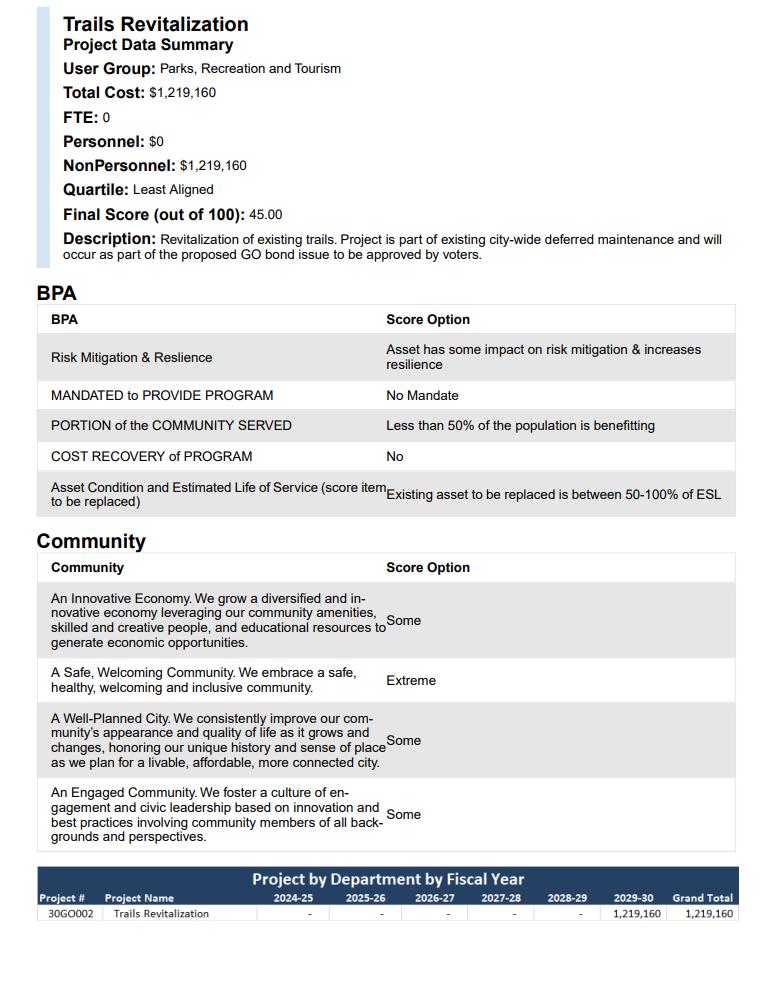

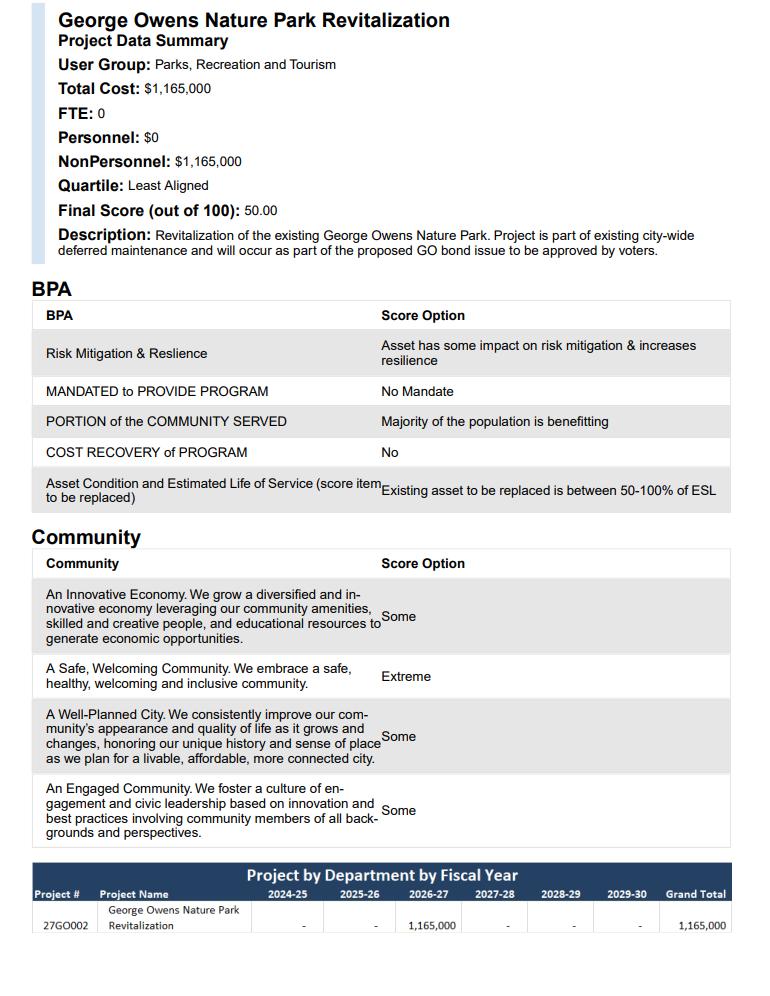











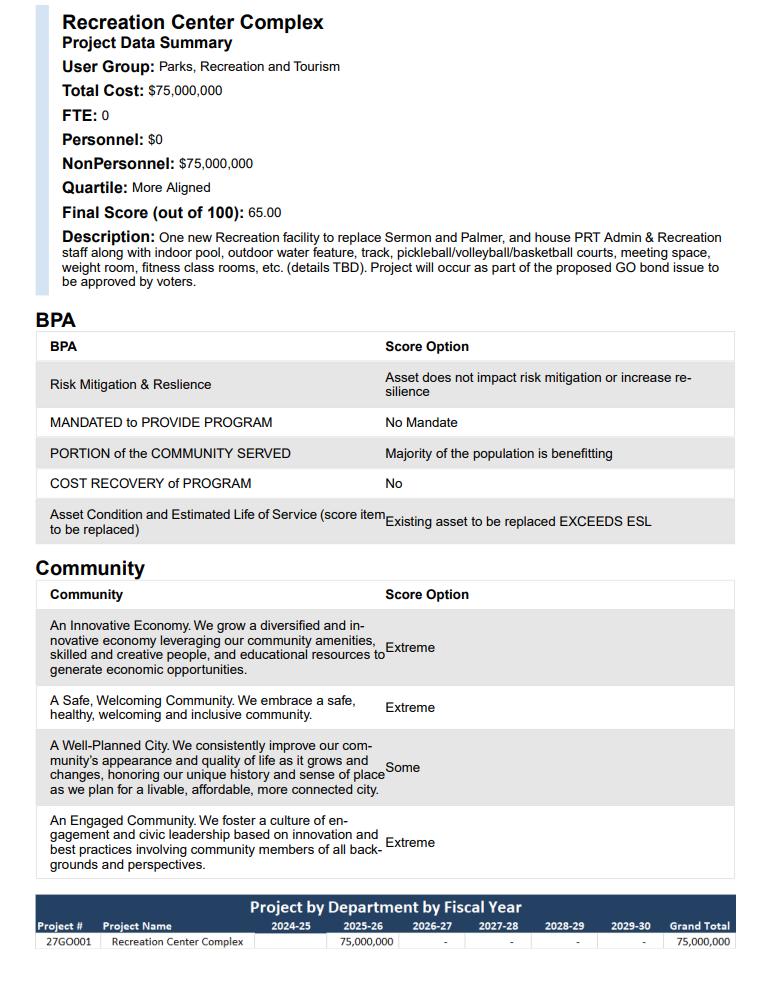



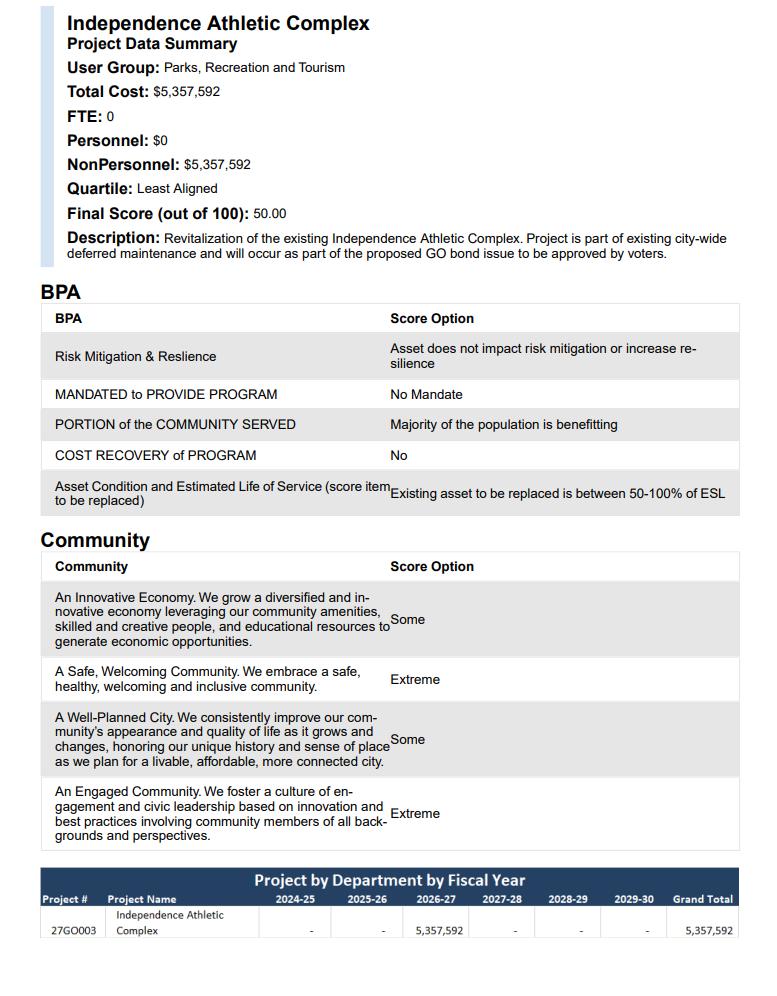



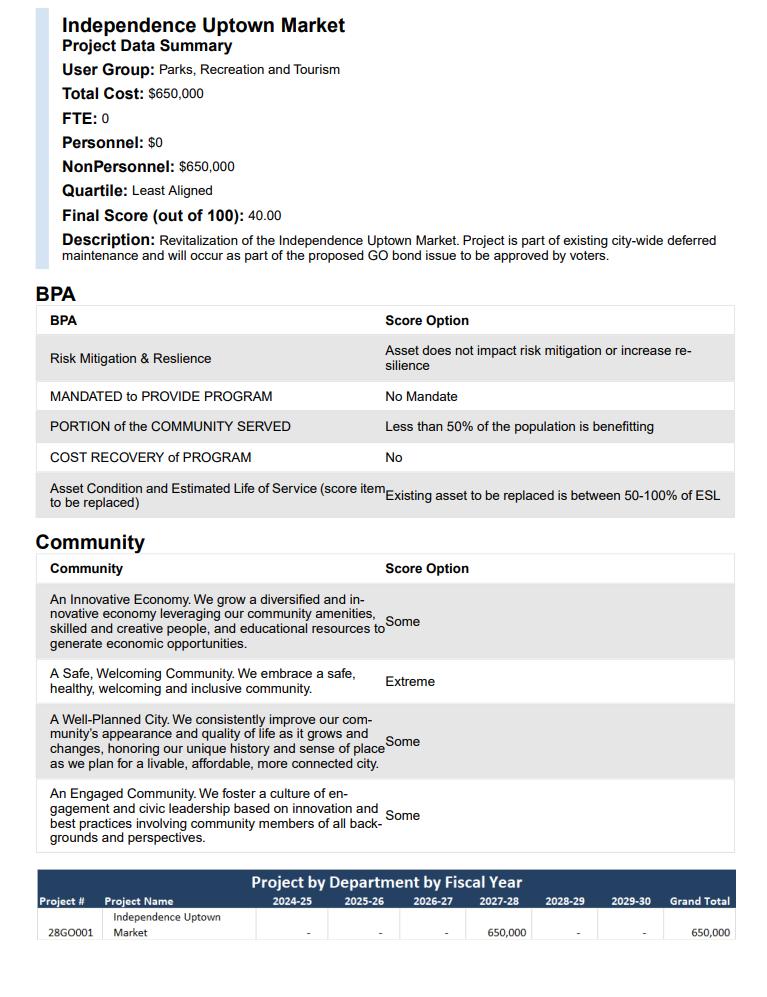

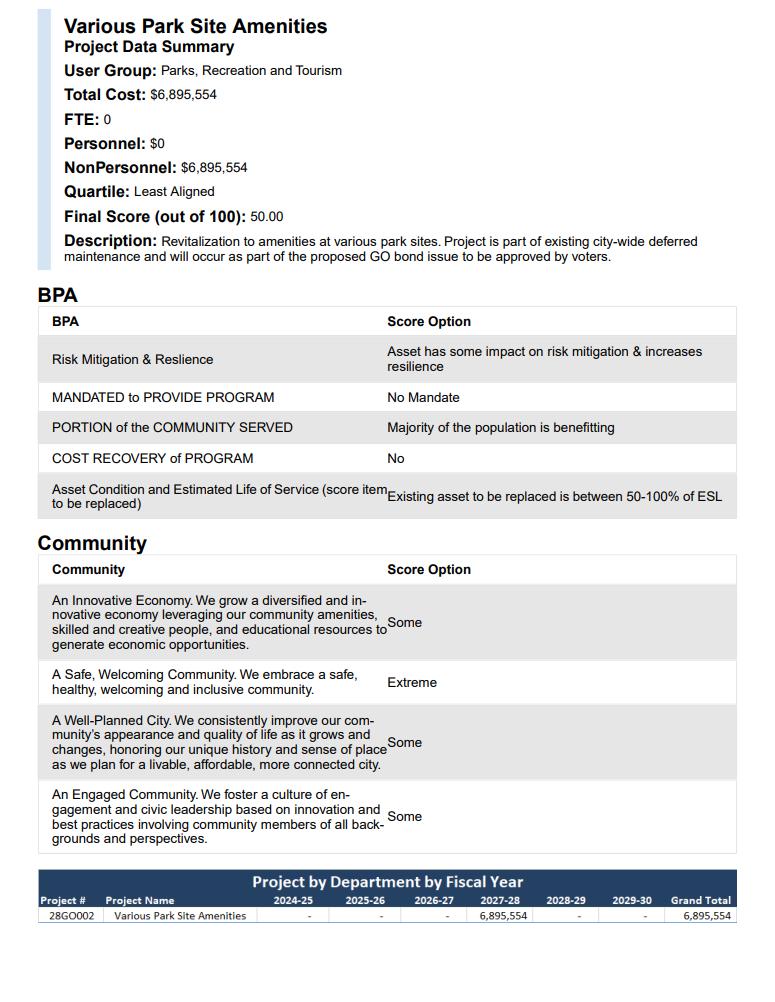







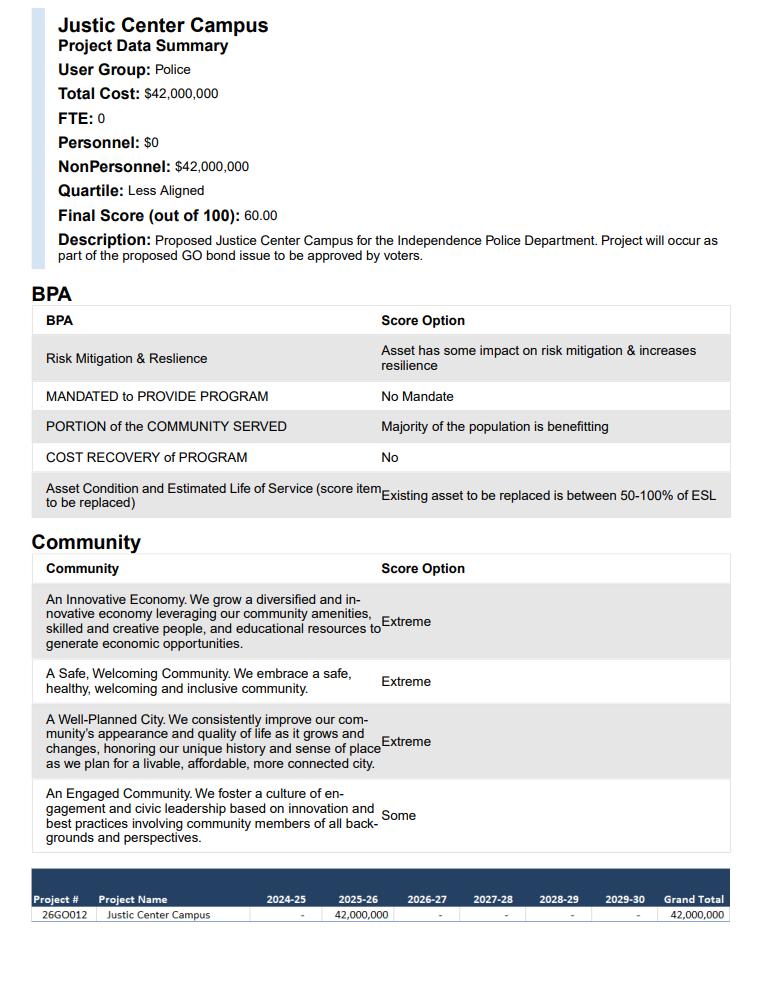





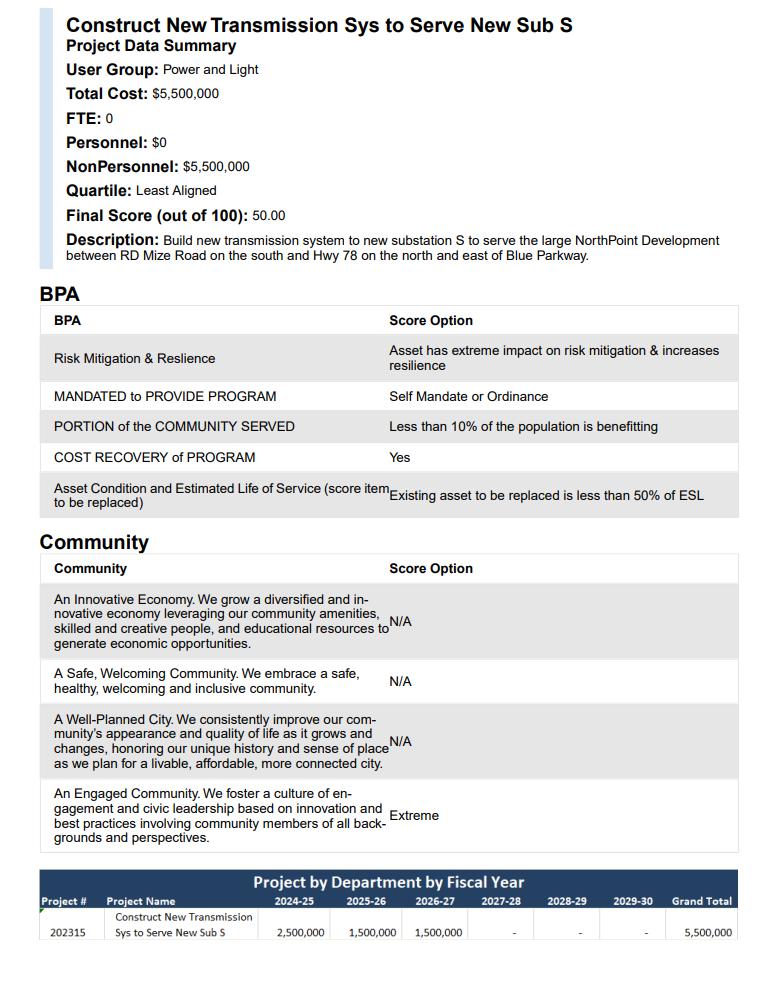



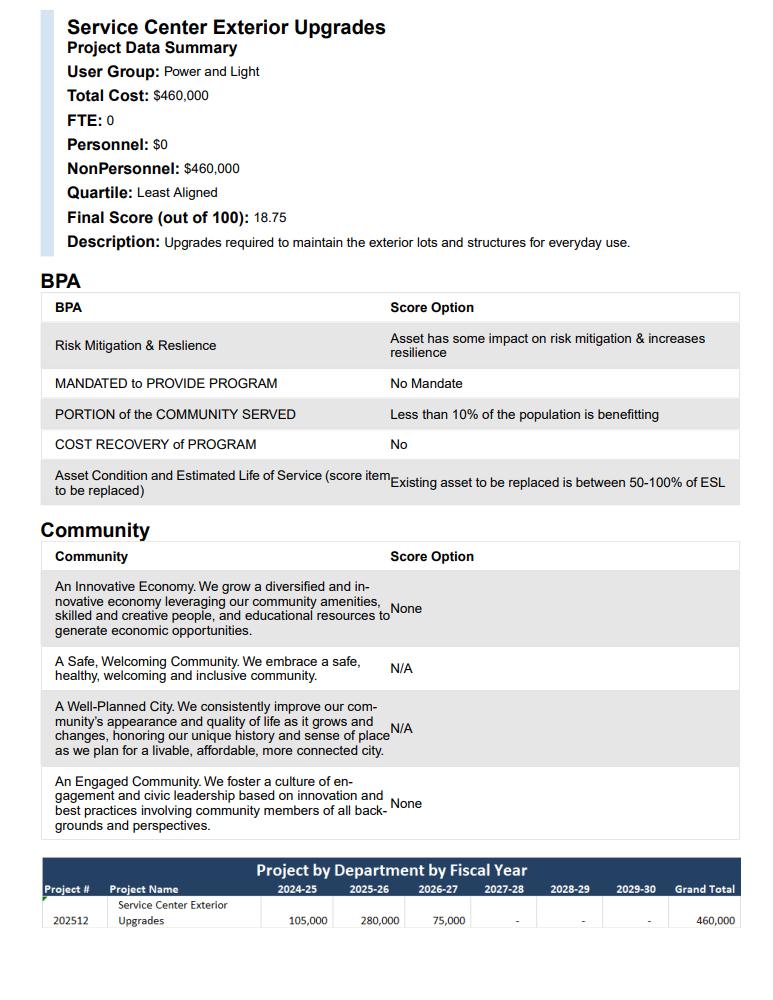







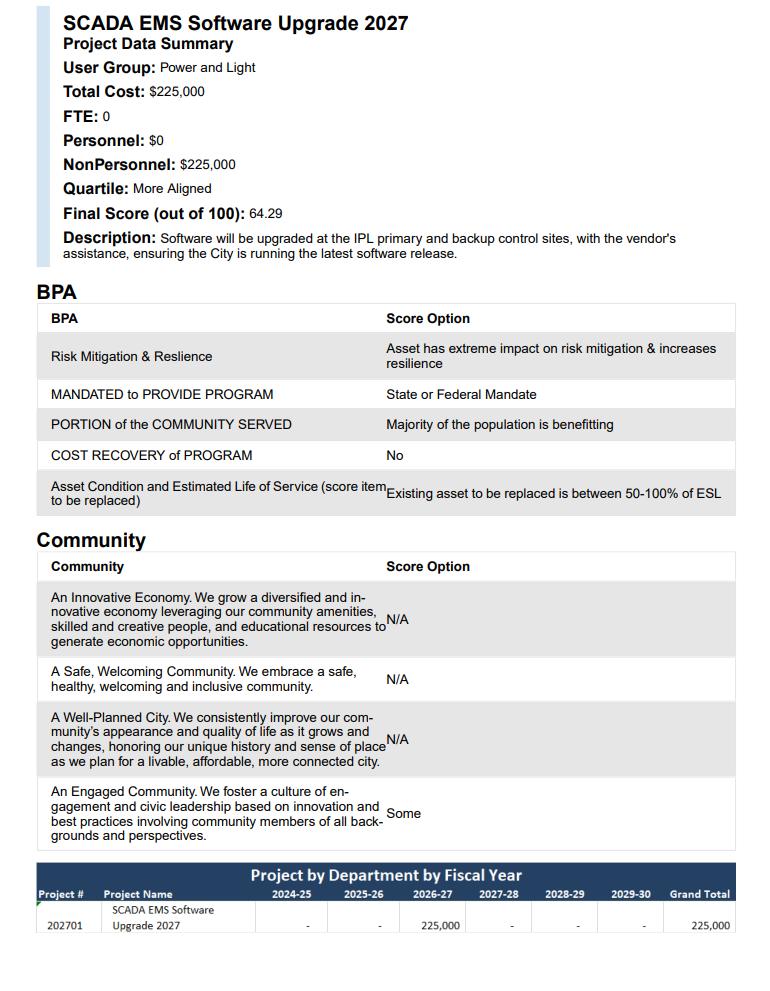

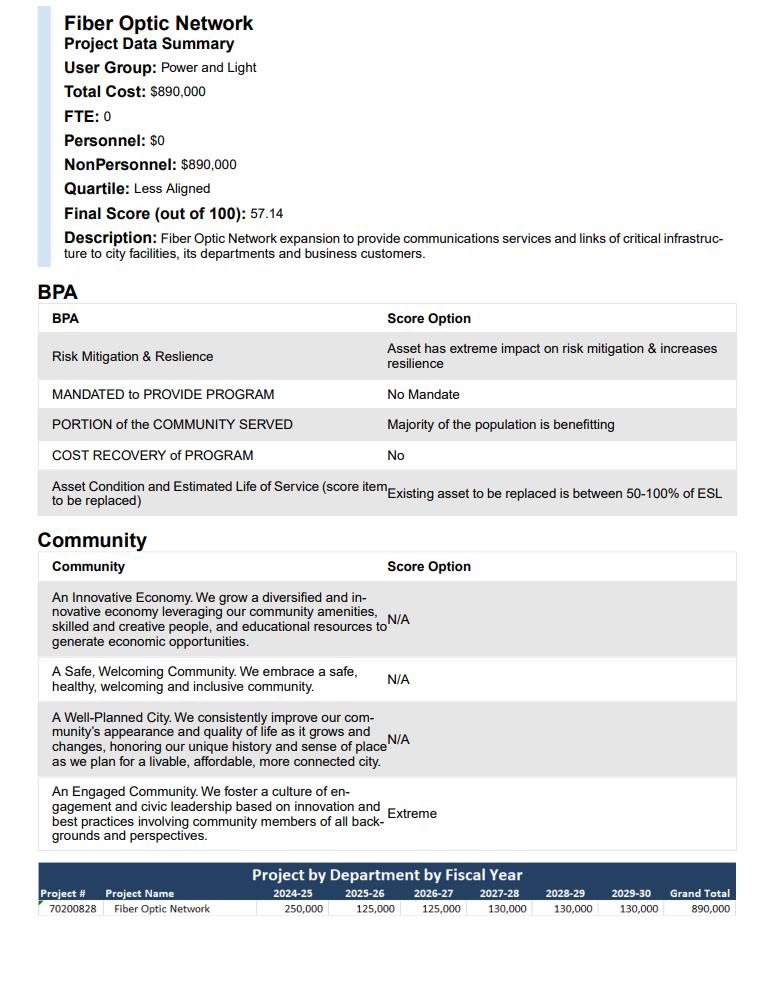



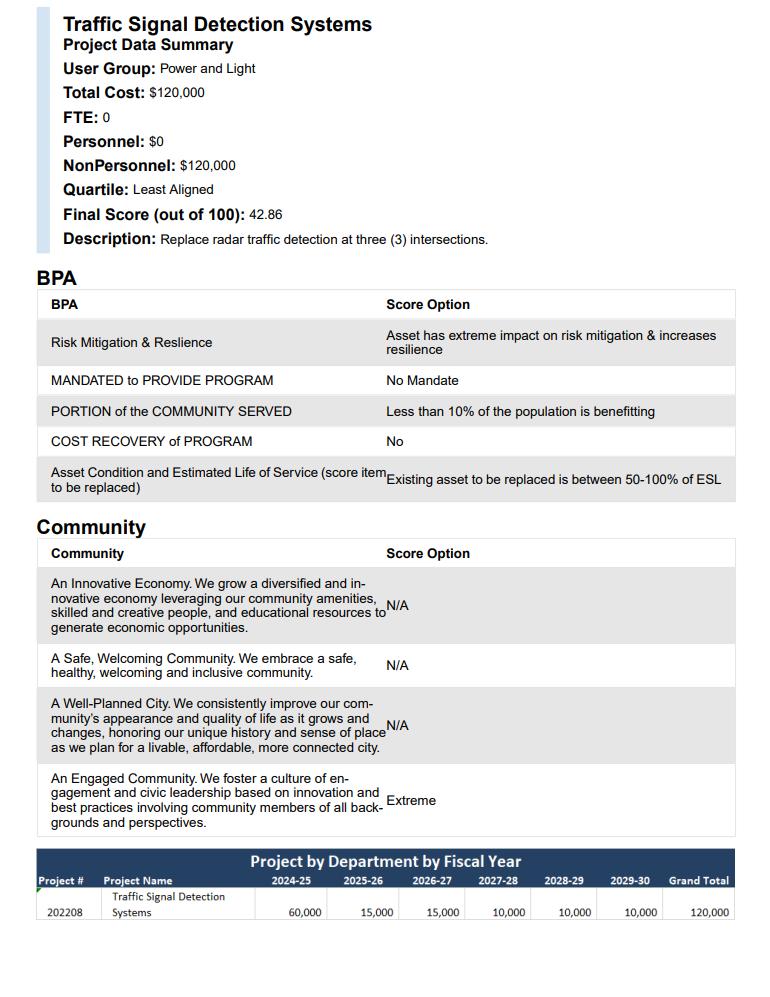





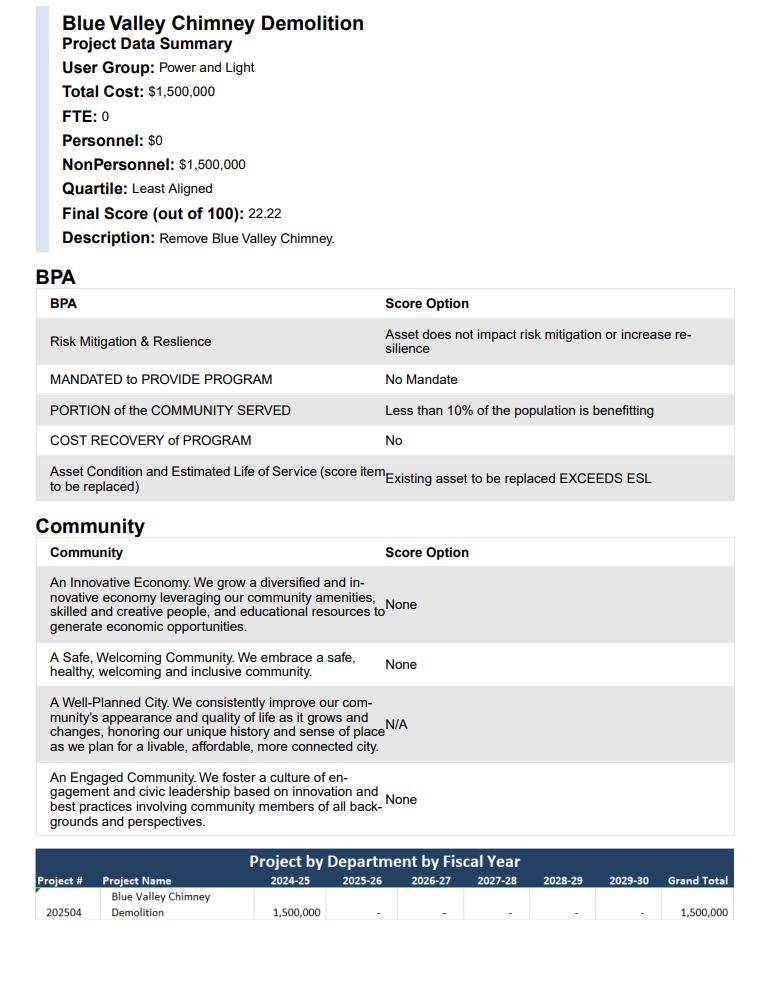

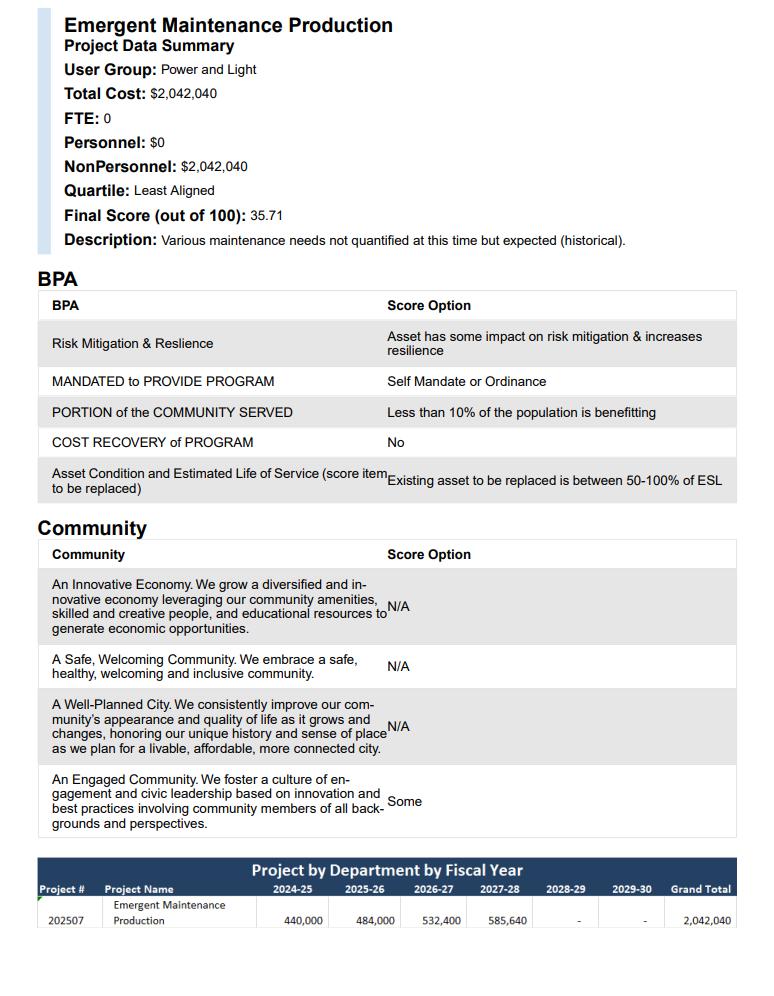





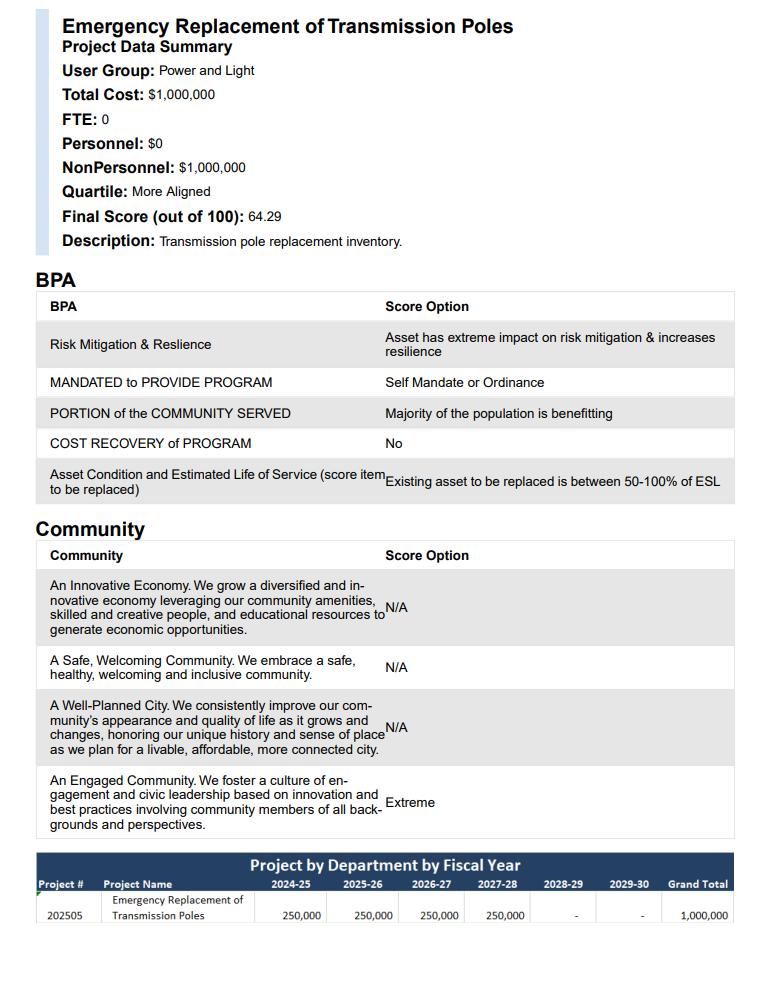

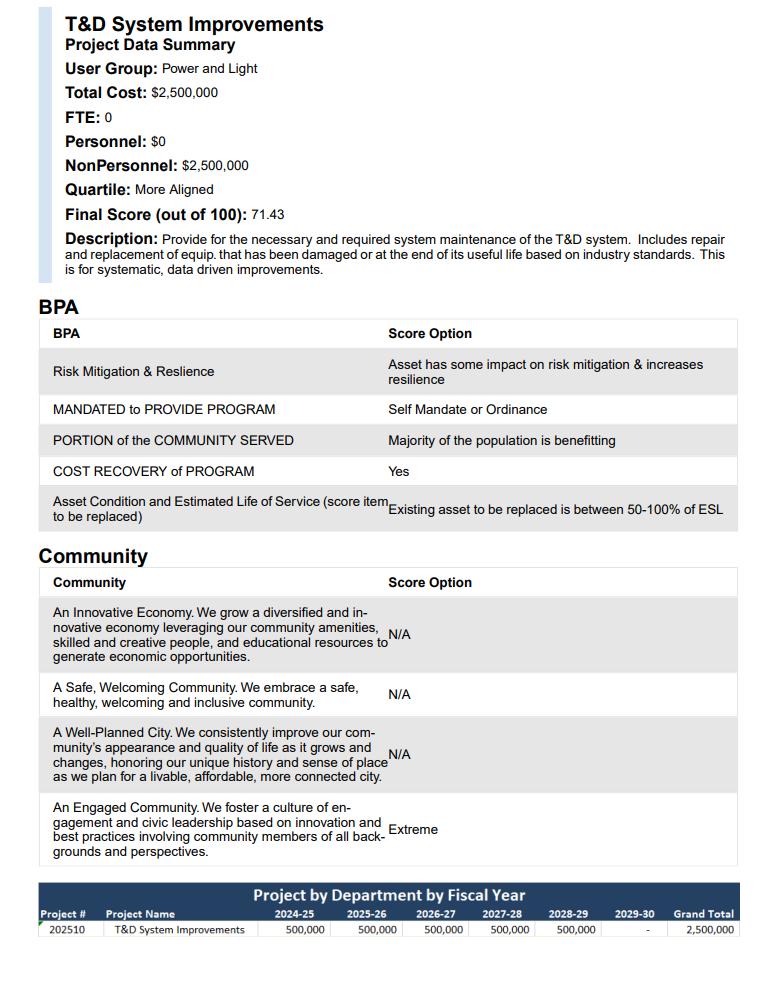



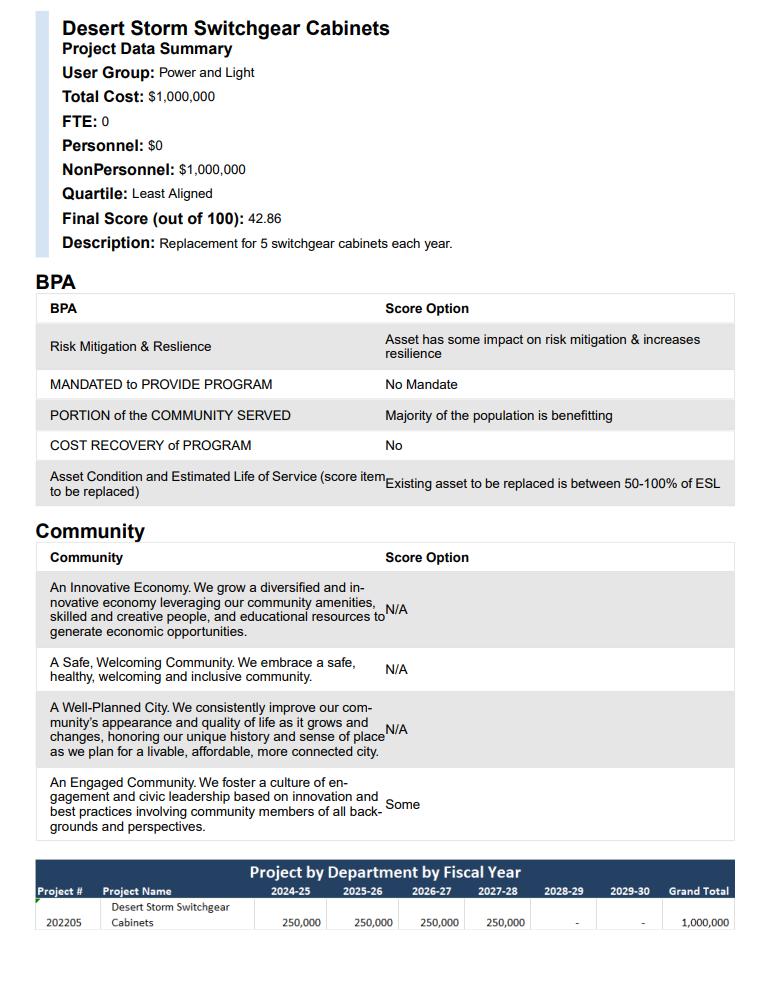







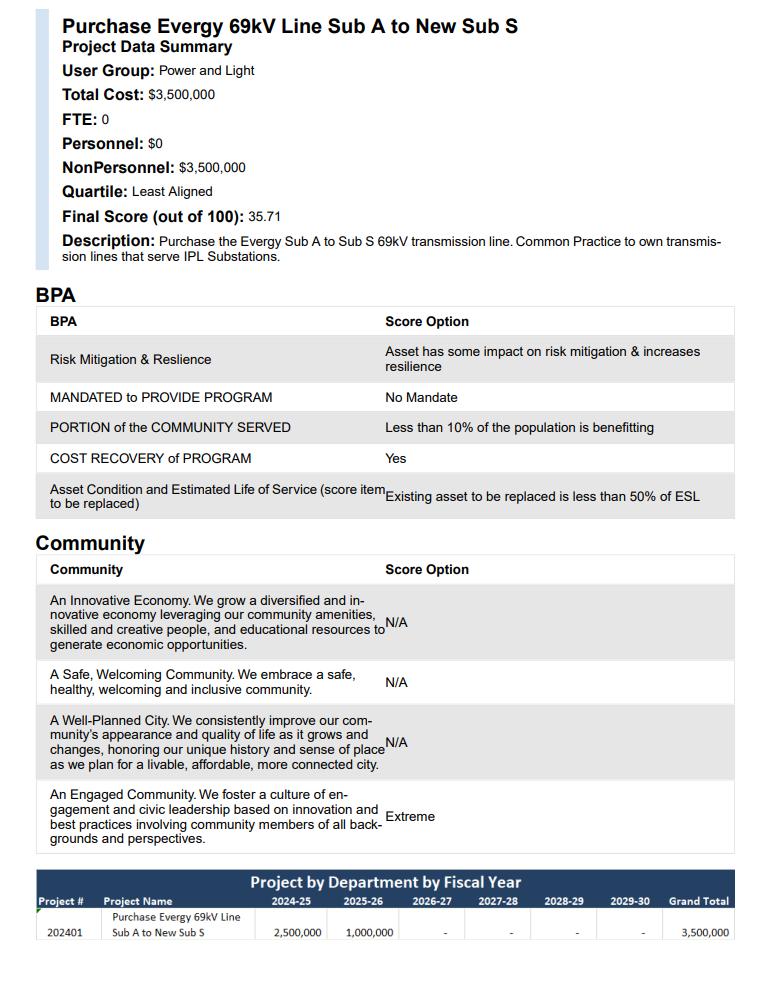

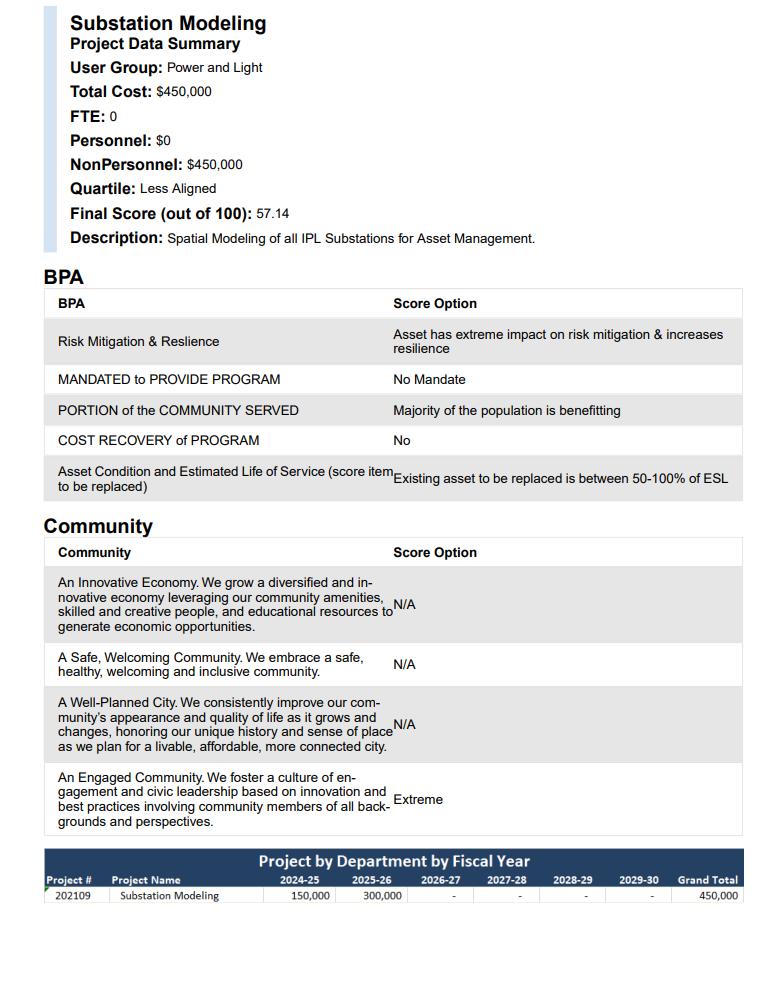

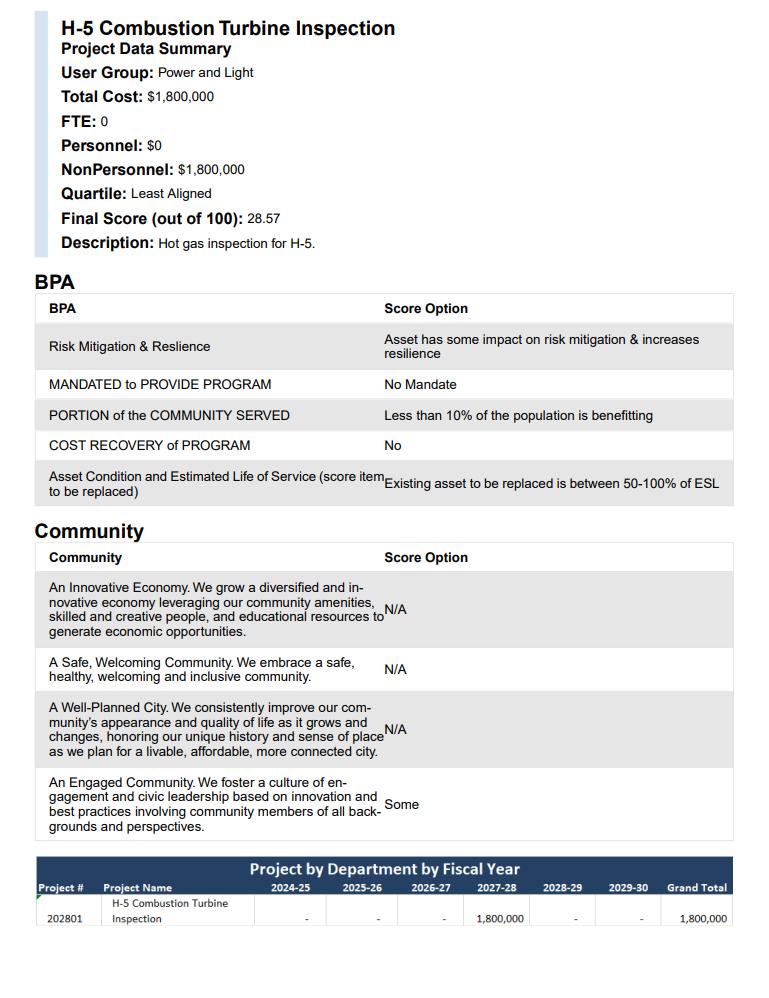



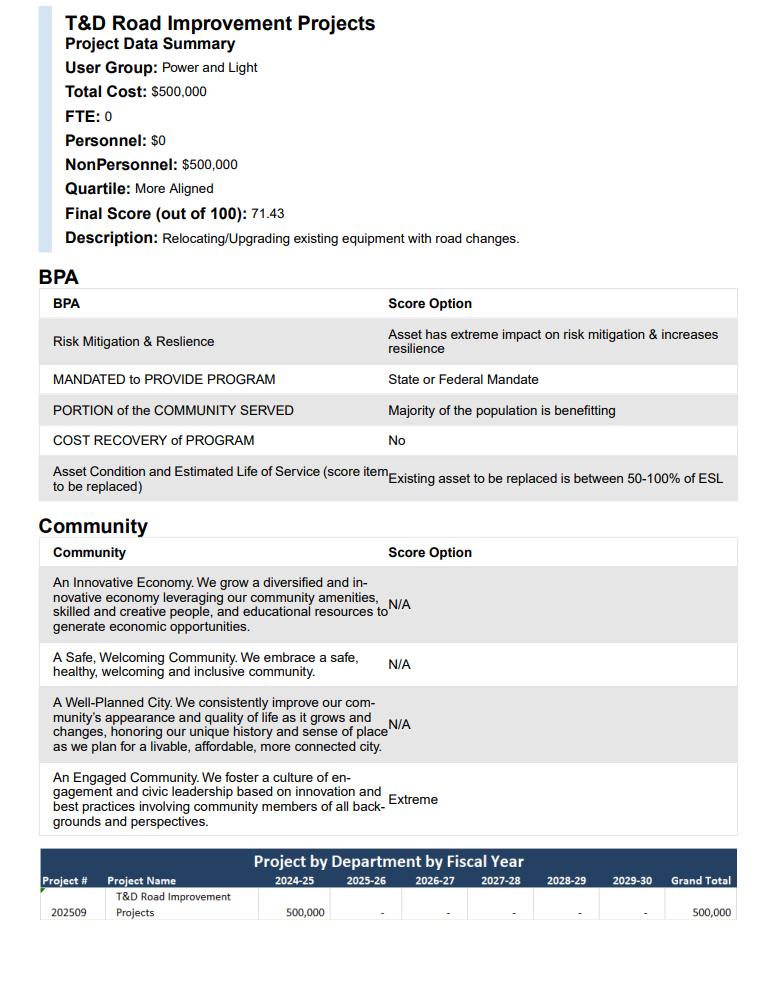

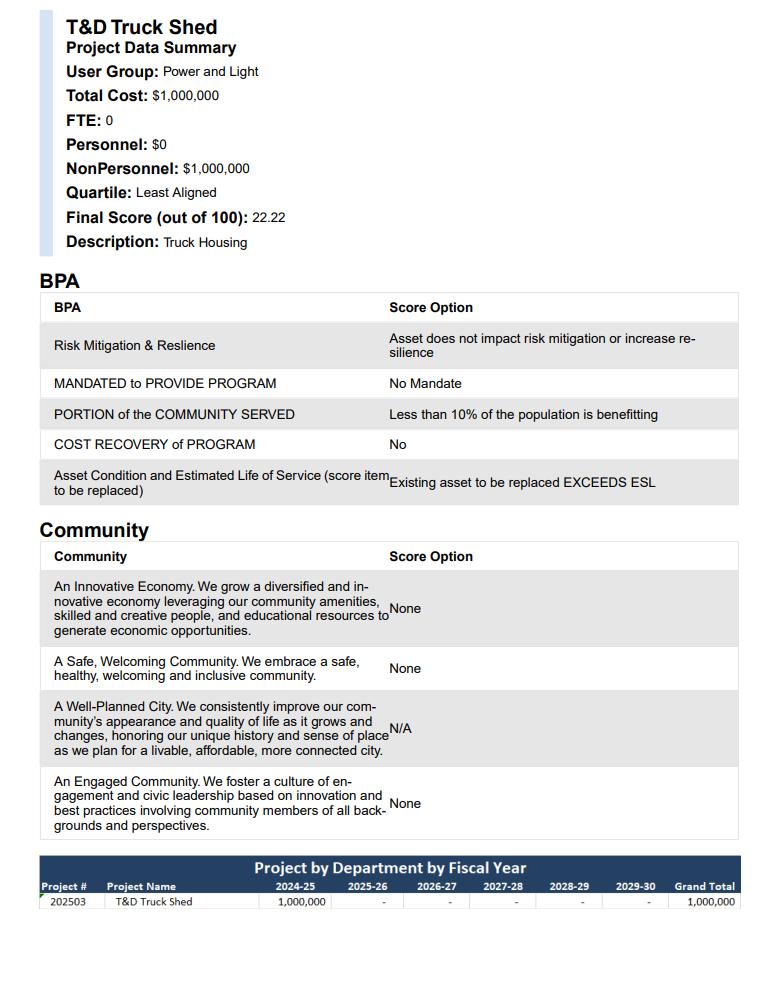

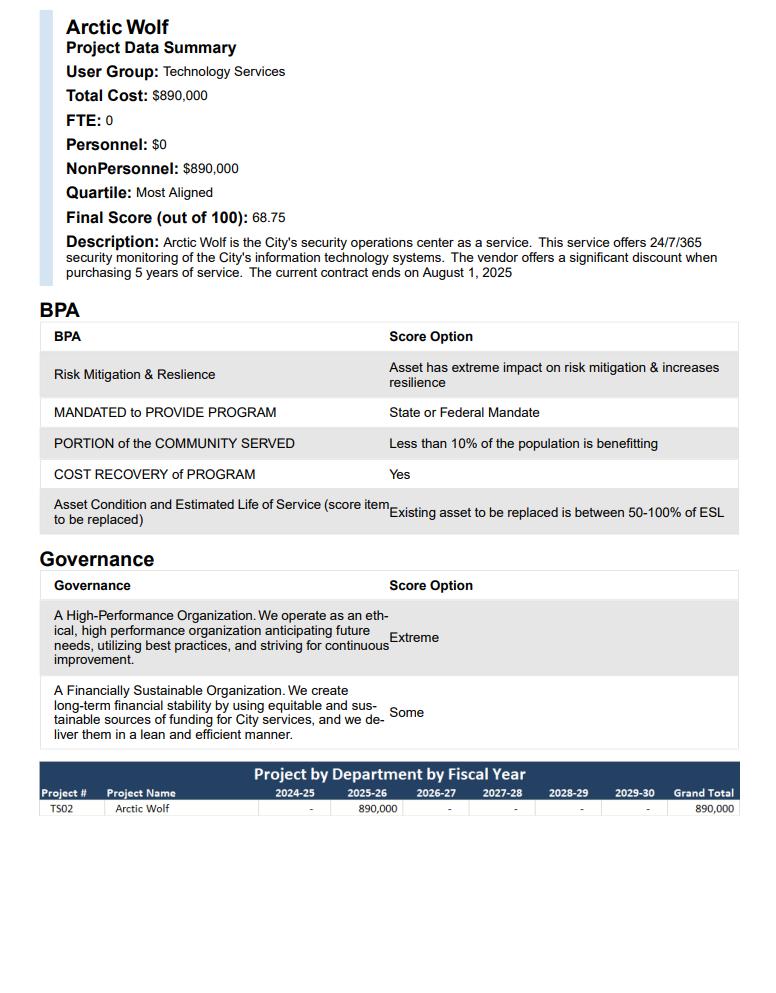



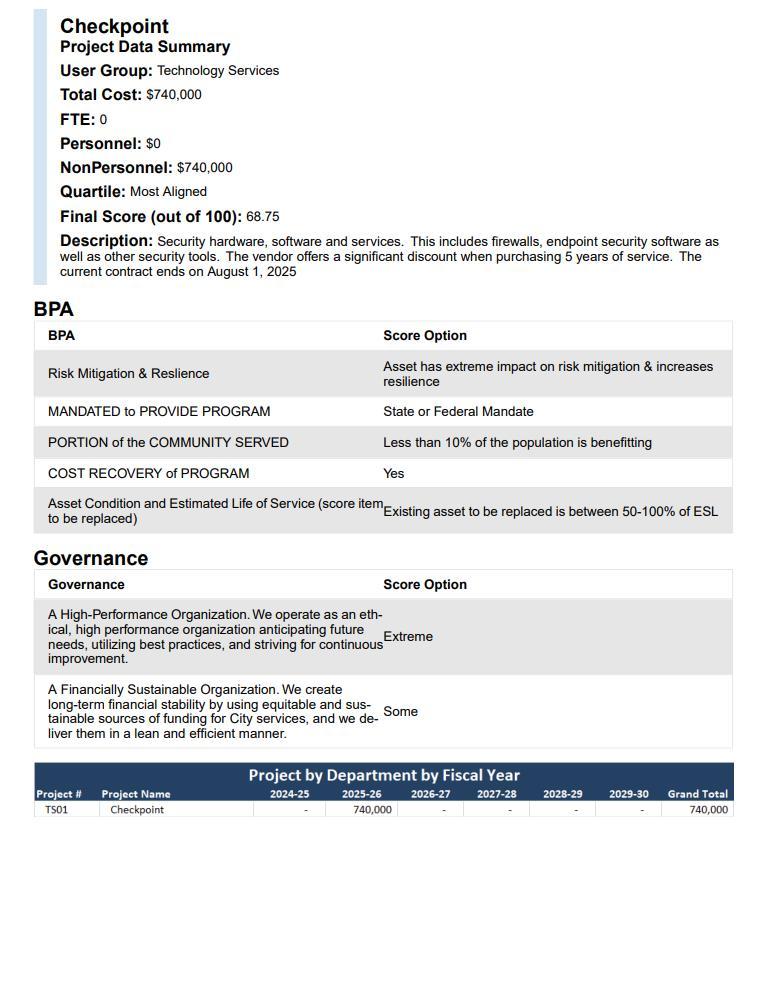

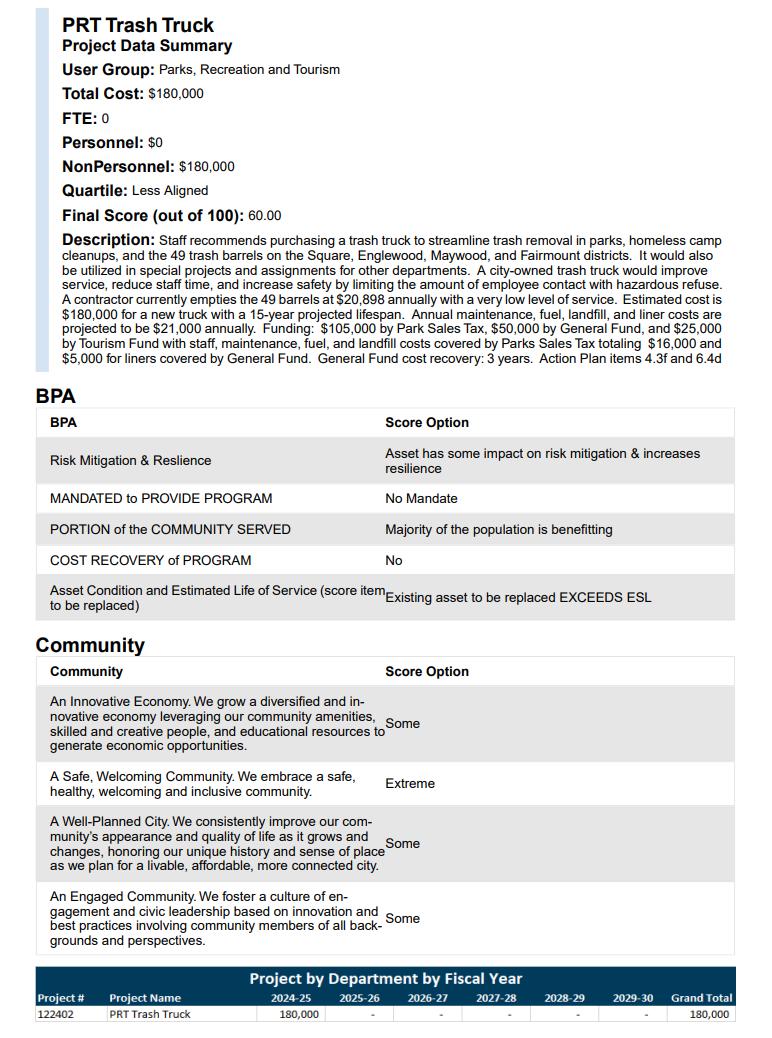







Included in FY 2024-25 Adopted Budget
Any new items or programs that do not fit into a department’s base budget must be requested as a budget packages. Budget package requests are required for any:
• Personnel changes
o Including salary increases (outside of union agreements), conversions and additional FTE.
o If requesting new headcount, benefits should be included
• Operating expenditure changes (not personnel) over $5,000.
• Overtime increases of more than 10% at the department or fund level, against the prior year adopted budget.


At the end of fiscal year 2023, the City had a total of $435.7 million of outstanding obligations. This was a decrease of $19.3 million from the previous fiscal year. None of the debt is a general obligation of the City, and is limited to either an annual appropriation or specific revenue for repayment. Of the total debt, $309.8 million, or 71.1%, are obligations of the business-type activities.
Audited amounts as of June 30, 2023
The State Constitution permits a city, by vote of two-thirds of the voting electorate, to incur general obligation indebtedness for “city purposes,” not to exceed 10% of the assessed value of taxable tangible property. The State Constitution also permits a city, by vote of two-thirds of the voting electorate under a special election or four-sevenths under a general election, to incur additional general obligation indebtedness not exceeding, in the aggregate, an additional 10% of the assessed value of taxable tangible property for the purpose of acquiring rights-of-way, constructing, extending, and improving streets and avenues and/or sanitary or storm sewer systems, and purchasing or constructing waterworks, electric or other plants, provided that the total general obligation indebtedness of the city does not exceed 20% of the assessed valuation of taxable property. As of June 30, 2023, the City has no general obligation debt outstanding.
The city currently has approximately $1 billion of deferred capital maintenance and capital projects. The city anticipates requesting voter approval in April 2025 to address $200 million of these deferred capital needs through general obligation debt.
Below is a table showing the City’s current credit ratings from Standard & Poor’s (S&P):
at Crackerneck Creek – Bass Pro TIF
other economic development projects
Details of debt found within each Series’ Final Official Statement can be located at the City’s Investors’ Relations site

Noncurrent Liabilities:
City of Independence, Missouri
Statement of Net Position 30-Jun-23

*snip of Statement of Net Position on page 24 of the June 30, 2023, Audited Financial Statements in the city's Annual Comprehensive Financial Report
The table on the following page is a summary of changes in long-term liabilities of the City for the year ended June 30, 2023:
Long-Term Debt – Governmental Activities 30-Jun-23

Long-Term Debt – Proprietary 30-Jun-23
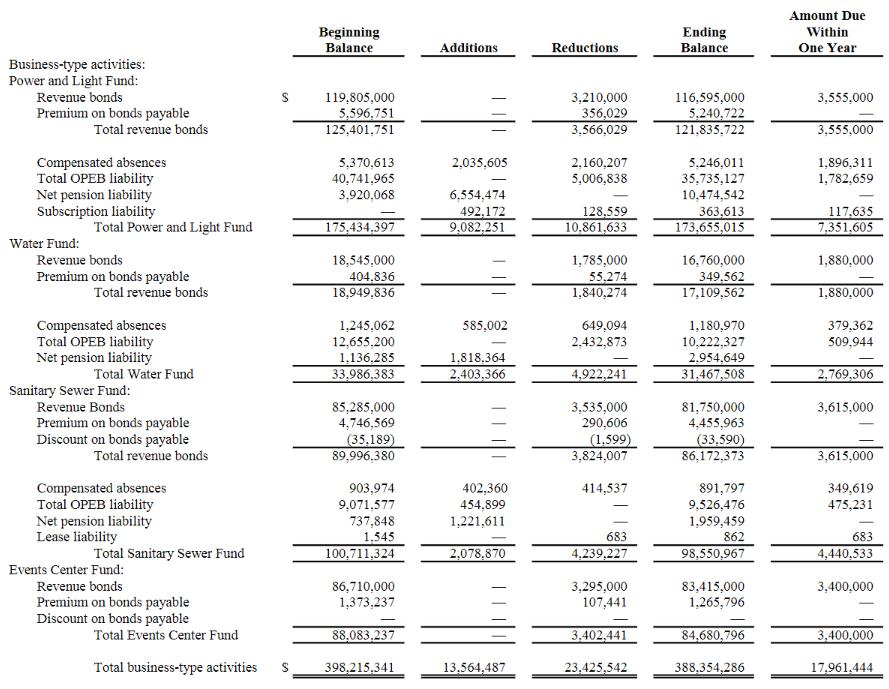


Summary of Governmental Loans 30-Jun-23
Governmental activities loans payable at June 30, 2023 is comprised of the following:
$17,940,000 Lease Purchase for Deferred Maintenance, annual installments of $1,220,000 to $1,575,000; interest at 2.420% - paid from Street Improvement Sales Tax Fund. $ 16,630,000
Total Governmental Activities Loans Payable $ 16,630,000
The total loan is privately placed.
Neighborhood Improvement District bonds payable at June 30, 2023 are comprised of the following:
$111,000 Series 2004 (Fall Drive Sanitary Sewer Project) annual installments of $5,000 to $6,000 through 2024; interest at 5.375% to 5.50% - paid from the Debt Service Fund. $ 12,000
Total Neighborhood Improvement District $ 12,000
Summary of Tax Increment Financing Fund Debt June 30, 2023
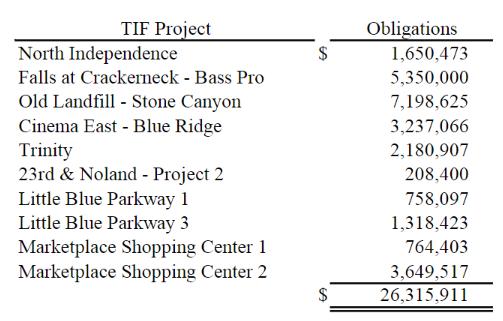
Summary of MDFB Debt
June 30, 2023
Missouri Development Finance Board Loans Payable
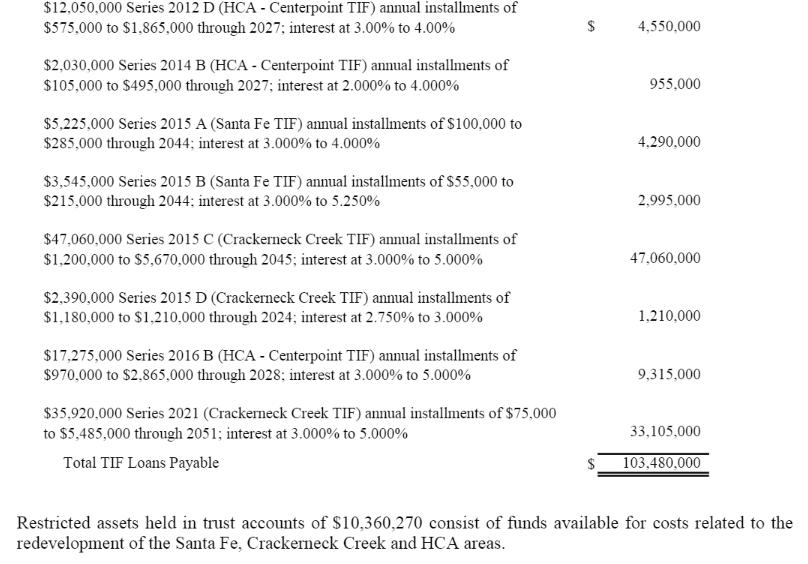
Summary of Capital Leases
June 30, 2023
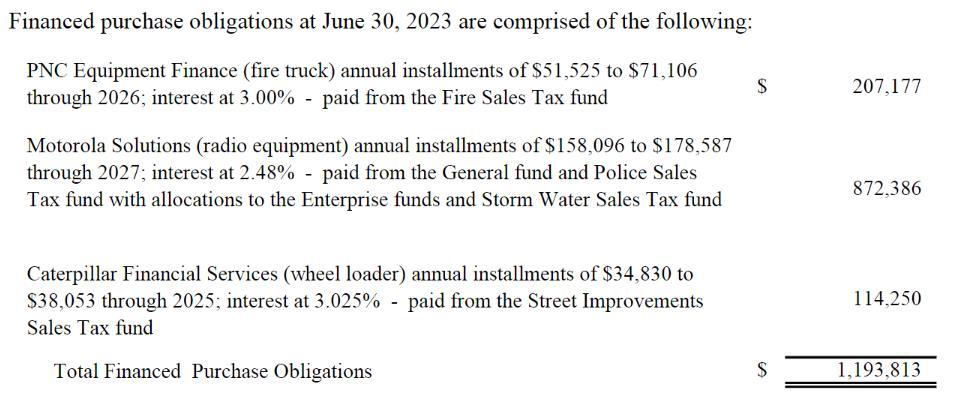

Business-Type Activities
Revenue Bonds
Summary of Electric Fund Debt
June 30, 2023

Summary of Water Fund Debt
June 30, 2023

Summary of Sanitary Sewer Fund Debt
June 30, 2023


Summary of Events Center Fund Debt June 30, 2023

The fiscal year of the city shall start on July 1st and end on June 30th .
a. City Charter, Section 8.2 Budget: Preparation and submission. At least forty-five (45) days before the beginning of the fiscal year, the City Manager shall prepare and submit to the Council a proposed budget for the next fiscal year, which shall contain detailed estimates of anticipated revenues including any resources available from the current fiscal year and proposed expenditures for the year and any explanatory message. The budget shall include the general fund and at least all other regular operating funds which are deemed to require formal annual budgeting and shall be in such form as the City Manager deems desirable or as the Council may require. The total of the proposed expenditures from any fund shall not exceed the total of the anticipated resources thereof. The budget and budget message shall be public records in the office of the City Clerk and shall be open to public inspection. Copies of the budget and budget message shall be made for distribution to persons on request.
b. City Charter, Section 8.3 Comparison of anticipated revenues and proposed expenditures with prior years.
c. In parallel columns opposite the several items of anticipated revenues in the budget, there shall be placed the amount of revenue during the last preceding fiscal year and the amount of revenue up to the time of preparing the budget plus anticipated revenue for the remainder of the current fiscal year estimated as accurately as may be.
d. In parallel columns opposite the several items of proposed expenditures in the budget, there shall be placed the amount of each such item actually expended during the last preceding fiscal year and the amount of each such item actually expended up


to the time of preparing the budget plus the expenditures for the remainder of the current fiscal year estimated as accurately as may be.
a. City Charter, Section 8.4 Budget: Public hearing. The Council shall hold a public hearing on the proposed budget at least one (1) week after a notice of the time of the hearing has been published in a newspaper of general circulation within the city; and any interested person shall have the opportunity to be heard. The Council may continue the hearing at later meetings without further notice.
a. City Charter, Section 8.5 Budget: Amendment, adoption, appropriations. The Council may insert, strike out, increase, or decrease items in the budget, and otherwise amend it, but may not increase any estimate of anticipated revenues therein unless the City Manager certifies that, in the City Manager's judgment, the amount estimated will be revenue of the fiscal year. The Council, not later than the twenty seventh (27th) day of the last month of the fiscal year, shall adopt the budget and make the appropriations for the next fiscal year. If the Council fails to adopt the budget and make the appropriations on or before that day, the budget as submitted or as amended, shall go into effect and be deemed to have been finally adopted by the Council; and the proposed expenditures therein shall become the appropriations for the next fiscal year. The appropriations, when made by the Council by a general appropriation ordinance separate from the budget document, need not be in as great detail as the proposed expenditures in the budget. Appropriations from a fund shall never exceed the anticipated resources thereof in the budget as adopted.
a. City Charter, Section 8.6 Budget: Transfer of appropriation balances, amendment. After the appropriations are made and except as the Council by ordinance may provide otherwise, the City Manager may transfer unencumbered appropriation balances or parts thereof from any item of appropriation within a department, office or agency to any other items of appropriation, including new items within the same department, office or agency; and upon recommendation by the City Manager, the Council may transfer unencumbered appropriation balances or parts thereof from any item of appropriation, including an item for contingencies, in a fund to any other item of appropriation, including new items in the fund.
Upon recommendation by the City Manager, the Council by ordinance may also amend the budget as adopted by changing the estimates of anticipated revenues for proposed expenditures of a fund and otherwise; and may increase or decrease the total appropriations from a fund when a change in revenues or conditions justify such action; but total appropriations from any fund shall never exceed the anticipated revenues thereof in the budget as adopted or as amended, as the case may be. The Council shall not increase any estimate of anticipated revenues in the budget unless
the City Manager certifies that, in the City Manager’s judgement, the amount estimated will be revenue of the fiscal year.
a. Governmental Funds – are those through which most governmental functions of the city are financed. The acquisition, use and balances of the city’s expendable financial resources and the related liabilities (other than those in proprietary funds) are accounted for through governmental funds. The measurement focus is upon determination of changes in financial position. The following are the city’s governmental fund types for which annual operating budgets are prepared:
i. The General Fund is the principal operating fund of the city and accounts for all financial transactions not accounted for in other funds. The general operating expenditures, fixed charges and capital improvement costs that are not paid through other funds are financed through revenues received by the General Fund.
ii. Special Revenue Funds are used to account for revenues derived from specific taxes, governmental grants or other revenue sources which are designated to finance particular functions or activities of the city.
b. Proprietary Funds – are used to account for the city’s on-going organizations and activities which are similar to those often found in the private sector. The measurement focus is upon determination of net income. The following are the city’s proprietary fund types:
i. Enterprise Funds are sued to account for operations that are financed and operated in a manner similar to private business enterprises where the intent of the governing body is that the costs (expenses, including depreciation) of providing goods or services to the general public on a continuing basis be financed or recovered primarily through user charges or where the periodic determination of net income or loss is deemed appropriate.
c. Internal Service Funds – are used to account for the financing of goods or services provided by one department or agency to other departments or agencies of the city on a cost-reimbursement basis.
Basis of accounting refers to when revenues and expenditures or expenses are recognized in the accounts and recorded in the financial statements. Basis of accounting relates to the timing of the measurements made, regardless of the measurement focus applied. Measurement focus determines upon expenditures – decreases in net financial resources. The measurement focus for proprietary funds Is based on expenses – decreases in net total assets. The principal difference between expenditures and expenses is that with expenditures, the primary concern is the flow of resources, however with expenses; the primary concern is the substance of transactions and events which may not specifically related to the actual flow of resources.


As already indicated, the basis of accounting relates to when transactions are recorded, not what is actually recorded. The three different types of accounting basis are 1) cash, 2) Modified Accrual, and 3) Accrual. The latter two are recognized as Generally Accepted Accounting Principles (GAAP); the Cash basis is not.
The modified accrual basis of accounting is utilized by all governmental fund types and expendable trust funds. Under the modified accrual basis of accounting, revenues are recorded as collected unless susceptible to accrual, i.e., amounts measurable and available to finance the city’s operations or of a material amount and not received at the normal time of receipt. Available means collectible within the current period or soon enough thereafter to be used to pay liabilities of the current period. Significant revenues which are considered susceptible to accrual include real estate taxes, sales taxes, utility franchise taxes, interest, and certain State and Federal grants and entitlements. Expenditures, other than interest on longterm debt, are recorded when the liability is incurred.
In applying the susceptible to accrual concept to intergovernmental revenues (i.e. grants), the legal and contractual requirements of the individual program is used as guidance. There are, however, essentially two types of these revenues. In one, monies must be expended on the specific purpose or project before any amounts will be paid to the city; therefore, revenues are recognized based upon the expenditures recorded. In the other, monies are virtually unrestricted as to purposes or expenditures and nearly irrevocable. i.e., revocable only for failure to comply with prescribed compliance requirements. These resources are reflected as revenues at the time of receipt or earlier if they meet the available and measurable criteria. Real estate taxes levied and expected to be collected within sixty days are after the fiscal year end are considered available and, therefore, are recognized as revenues.
Licenses and permits, fines and forfeitures, charges for services and miscellaneous revenues are recorded as revenues when received in cash because they are generally not measurable until actually received.
The accrual basis of accounting is utilized by the proprietary and nonexpendable trust fund types. Under this basis of accounting, revenues are recognized when earned (including unbilled revenue) and expenses are recorded when liabilities are incurred.
The city’s policy is to prepare the annual operating budget on a basis which includes encumbrances as the equivalent of expenditures in order to assure effective budgetary control and accountability and to facilitate effective cash planning and control. Encumbrance accounting is where purchase orders, contracts, and other commitments for the expenditures of funds are recorded in order to reserve that portion of the applicable appropriation.
Encumbrances outstanding at year-end represent the estimated amount of the expenditures ultimately to result if unperformed contracts in proves at year-end are completed. Encumbrances outstanding at year-end are reported in the Annual Comprehensive Financial Report (ACFR) as reservations of fund balances because they do not constitute expenditures
or liabilities. Outstanding encumbrances at year-end are re-appropriated in the following fiscal year in order to provide authority to complete these transactions.
The city’s Annual Comprehensive Financial Report (ACFR) reports on the status of the city’s finance in accordance with the GAAP basis of accounting. In most cases this is also the same basis of accounting as used in preparing the budget. Exceptions to the basis of accounting used for financial reports and in preparing the budget are listed below:
1. Governmental Fund Types – All governmental fund types use the same basis of accounting for reporting and budgeting with the exception that the budget also recognizes encumbrance accounting. In the ACFR, the “Combined Statement of Revenues, Expenditures and Changes in Fund Balance – All Governmental Fund Types and Expendable Trust Funds” presents revenues and expenditures in accordance with the GAAP basis of accounting. The “Combined Statement of Revenues, Expenditures and Changes in Fund Balance – Budget and Actual (Budget Basis)” in the CAFR presents the same information, however it also includes the recognition of encumbrances. This later statement provides a reconciliation of the presented data to the GAAP basis statement.
2. Proprietary Fund Types – All proprietary fund types use the same basis of accounting for reporting and budgeting with the exception of “non-cash” expenses and disbursements that affect balance sheet accounts. “Non-cash” expenses are included in the financial reports but not in the budget. An example of this type of expense would be depreciation where an expense is recorded but a cash disbursement does not take place. Balance sheet account disbursements are items that are included in the budget as expenditures, however they do not affect the ”Combined Statement of Revenues, Expenses and Changes in Retained Earnings/Fund Balances – All Proprietary Fund types and Nonexpendable Trust Funds” (i.e. the operating statement) in the ACFR.
3. An example of these types of items would be inventory purchases, debt principal payments and capitalized labor and material costs.

Adopted by Council Resolution 17-729
The City of Independence has an important responsibility to our residents to carefully account for public funds, manage municipal finances wisely, and to develop a plan to adequately fund services and facilities desired and needed by the public. The financial integrity of our city government is of utmost importance and the codification of a set of financial policies is a key element in maintaining this integrity. The formalization of a set of financial policies for the city is consistent with the Council’s adopted goal of ensuring city finances are stable and sustainable through control of long-term costs, optimization of resources, long-range financial planning and sound decision-making.
Written and adopted financial policies have many benefits such as assisting the City Council and City Manager in providing the financial management of the city, saving time and energy when discussing financial matters, engendering public confidence and providing continuity over time as City Council and staff members change. While these policies will periodically be reviewed and amended, they will provide the foundation and framework for many of the issues and decisions facing the City today and in the future. They will promote sound financial management and assist in the city’s stability, efficiency and effectiveness.
In the past, the City of Independence has developed a variety of different types of financial policies, many of which have been maintained on a somewhat informal basis. These policies can be found in a variety of different locations, including Council Resolutions, Ordinances, Budget Documents, Capital Improvements Programs, etc. The financial policies listed below will establish consistent standards for the review of existing practices as well as the development of future financial plans.
The following policies are divided into seven major categories: General, Fund Balances, Debt, Financial Sustainability, Long Range Financial Planning, Monitoring – Accountability – control, and Investment of Funds.
A. General
a. Compliance with Applicable Laws: The city shall comply with all applicable federal and state laws, the City Charter, and the Code of Ordinances with respect to the interpretation and application of these policies.
b. Compliance with Governmental Standards: Policies and practices in financial reporting shall be consistent with Governmental Accounting Standards Board (GASB) standards.
B. Fund Balances
a. Minimum Unrestricted and Unassigned Fund Balance & Working Capital: The City of Independence has determined it a sound financial practice to maintain adequate fund balances and working capital. Accordingly, the city will endeavor to maintain a minimum Unrestricted and Unassigned Fund Balance in the General Fund equal to 16% of annual operating revenues less one-time funds like grants or transfers.
The city has adopted separate risk-based methodology for Fund Balances in Enterprise Funds.

For Special Revenue Funds that are primarily designated for capital purposes and support limited personnel and ongoing operations, the city will endeavor to maintain an Unassigned Fund Balance of 5% of annual revenues.
For Special Revenue Funds that support personnel and ongoing operations as well as capital expenditures, the city will endeavor to maintain an Unassigned Fund Balance between 5% and 16% of annual revenues.
b. Use of Fund Balance: Circumstances may arise which warrant the use of Unassigned or Unrestricted Fund Balances and working capital balances. These include revenue shortfalls, unanticipated cost increases, emergencies, grant matching, early debt retirement, major projects and expenditures beyond those created by only natural disasters. In such cases, any expenditures from the Unassigned or Unrestricted Fund Balance must be approved by the Council. The rationale for the expenditure must be documented as part of council action. Any unrestricted and unassigned funds in excess of target minimums may be expended to fund non-recurring expenditures.
c. Recovery Plan: if, based on staff’s analysis and forecasting, the target level of Unassigned Fund Balance reserve is not being met or is unlikely to be met at some point within a five-year time horizon, then during the annual budget process, a plan to replenish the Unassigned Fund Balance reserve should be established.
a. Evaluation Criteria: The following will be used to evaluate pay-as-you-go versus debt financing in funding capital improvements and equipment:
i. Factors which favor pay-as-you-go financing including the following:
1. Current revenues and fund balances are available.
2. Phasing-in of projects is feasible.
3. Additional debt levels would adversely affect the City’s credit rating.
4. Market conditions are unfavorable or suggest difficulties in marketing new debt.
ii. Factors which favor debt financing include the following:
1. Revenues available for debt issues are considered sufficient and reliable so that long-term financing can be marketed with an appropriate credit rating, which can be maintained.
2. Market conditions present favorable interest rates and demand for city debt financing.
3. A project is mandated by state or federal government and current revenues, or fund balances are insufficient to pay project costs.
4. A project is immediately required to meet or relieve capacity needs.
5. The life of the project or asset financed is five years or longer.
6. The life of the project or asset is less than five years, but short-term financing that does not exceed the useful life of the project or asset is feasible.


7. Cost savings can be achieved by completing improvements as a single large project rather than as a multi-year series of pay-as-you-go smaller projects.
b. Neighborhood Improvement District (NID) Debt: NID debt may be issued provided assessment payments are adequate to cover 100% of debt service and financing costs. The city will simultaneously apply any related economic development policies to evaluate the feasibility of the development project before issuing debt.
c. Early Debt Retirement: The city will endeavor, when possible, to retire bonds and other similar instruments early when sufficient revenues are accumulated and to refinance debt when a Net Present Value Savings of at least 3% exists.
d. Debt Term to Match Useful Life: Debt shall only be issued when the term of financing does not exceed the useful life of the asset for which the debt was issued.
e. City Debt Schedule: To ensure that long term debt obligations are sufficiently funded and accounted for, it is the city’s policy to develop a comprehensive debt schedule which matches specific revenues to specific debt obligations for each year of the entire term of each source of debt.
f. Debt Coverage & Solvency: To demonstrate solvency, ensure sufficient revenues exist to retire debt issued and maintain favorable bond ratings, the city will endeavor to maintain a Debt Service Coverage Ratio (net operating income [revenue minus operating expenses excluding transfers] divided by total debt service payment) of at least 1.2.
g. Lease Purchase Financing: The city will lease-purchase items only if lease rates are less than the rate attained from investment return. In no event shall the city leasepurchase items with a useful life of less than the term of the lease.
h. Financial Advisor: To provide advice on the issuance of debt and related matters, the city will employ the services of an outside financial advisor. The financial advisor will assist the city in evaluating when debt should be sold through a competitive versus negotiated sale. Such factors in determining the form of sale include, but are not limited to, the complexity of the issue; the need for specialized expertise; maximizing savings in time or money; or circumstances in which market conditions or city credit are unusually volatile or uncertain. It is the city’s policy that said financial advisor cannot also serve as the underwriter of municipal securities.
i. Statutory Limitations: The Missouri Constitution permits a city, by vote of two-thirds of the voting electorate, to incur general obligation indebtedness for city purposes not to exceed 10% of the assessed value of taxable tangible property. The city may issue additional debt not to exceed 10% of assessed valuation (20% total) for street and sewer improvements or purchasing or constructing water or electric utility plants.
a. Financial Sustainability: To ensure financial sustainability in city programs and operations, it shall be the city’s policy to apply one-time revenues to fund nonrecurring expenditures. Similarly, personnel costs and on-going programs and operations will be funded with on-going, sustainable sources of revenue.
b. Priority Funding to Maintain Assets: In preparing the annual budget, priority shall be given to providing adequate funding for maintenance, upkeep, and scheduled replacement of physical assets. The city will endeavor to establish funding levels to replace assets on a life-cycle basis. Enterprise Fund operations will endeavor to reflect, in budget appropriations, reinvest for the depreciation of assets.
a. 5-Year Capital Improvement Plan: The city will annually prepare a capital improvement plan that identifies its priorities and timeframe for undertaking capital projects and provides a financing plan for those projects. In order to ensure that proposed capital projects, their timing and their financing best meet the city’s policies and plans, the capital improvement plan will:
i. Project at least five years into the future.
ii. Consider overall affordability in terms of both capital and operating costs; and
iii. Include a process that allows stakeholder involvement in prioritizing projects and review.
b. Long Range Planning of Financial Obligations: The city will annually prepare a financial plan to assess the long-term financial implications of current and proposed policies, programs and assumptions in order to develop appropriate strategies to achieve its goals. The financial plan will consist of:
i. An analysis of financial trends.
ii. An assessment of problems or opportunities facing the city.
iii. A five-year forecast of revenues and expenditures
iv. A review of cash flow requirements and appropriate fund balances to determine whether modifications are appropriate for the Fund Balance Reserve Policy; and
v. Any further analyses as may be appropriate.
F. Monitoring – Accountability – Control
a. Transfer of funds: Department Directors, with the consent of the City Manager or his/her designee, may transfer funds between line items within the total budget appropriation of a particular budget in a fund. The City Manager may transfer unencumbered appropriation balances or parts thereof from any item of appropriation within a fund, department, office or agency to any other items of appropriation, including new items, within the same fund or department.
b. Reports: It is the city’s policy to produce monthly reports to verify that city departments are operating within the amount of appropriation, to compare actual income and expenses to budget estimates, to update year-end revenues and expense projections, and to develop, as soon as possible, strategies to meet financial challenges. Monthly reports to the City Manager from the Finance Department will also be provided to illustrate overall financial position of the city. A comprehensive annual financial report, as well as an annual audit, will also be produced.


c. Spending: No expenditures may be made, or funds encumbered, unless consistent with adopted purchasing policies and expenditure procedures.
d. Service Delivery Analysis: The city will seek to optimize the efficiency and effectiveness of its services to reduce costs and improve service quality. Alternative means of service delivery will be evaluated to ensure that quality services are provided to our residents at the most competitive and economical cost. Department directors, in cooperation with the City Manager’s office, will identify all activities that could be provided by another source and review options/alternatives to current service delivery methods. The review of service delivery alternatives and the need for the service will be performed annually or on an “opportunity” basis.
e. Grant Acceptance: The city shall actively pursue federal, state and other grant opportunities when deemed appropriate. Before accepting any grant, the city shall thoroughly consider all implications related to costs associated with complying with the terms of the grant agreement and the ongoing obligations that will be required in connection with the acceptance of the grant. In the event of reduced grant funding, city resources may be substituted only after all program priorities and alternatives are considered during the budget process. The City Manager will establish supplemental administrative policies to ensure appropriate coordination of grant applications and ensure grant compliance.
f. Employee Staffing Levels: The addition of new positions will only be requested after service needs have been thoroughly examined and it is substantiated that the additional staffing will result in increased revenue, enhanced operating efficiencies, or the achievement of specific objectives approved by the Council. To the extent feasible, personnel cost reductions will be achieved through attrition and reassignment.
g. Technology & Expertise: to ensure, to the greatest extent possible, accuracy in financial reporting, it is the city’s policy to invest in necessary technology. It is also the city’s policy to invest in training to develop staff expertise in financial reporting systems.
a. The investment of city funds will be handled in accordance with the city’s Statement of Investment Policy and Section 3.34(6) of the Charter of the City of Independence. Investments shall be undertaken in a manner that does not conflict with the Missouri Constitution Article IV, Section 5 on permitted investments or Section 30.270 of the Missouri Revised Statutes on permitted collateral.
b. Safety of Principal: It is the city’s policy that the foremost consideration in the city’s investment strategy should be safety of the principal invested.
c. Liquidity: It is the City’s policy that the investment portfolio always remains sufficiently liquid to meet all operating requirements.
d. Return: It is the city’s policy that the investment portfolio shall be designed with the objective of attaining a market rate of return throughout budgetary and economic cycles, considering the investment risk constraints and liquidity needs. Return on investment is of secondary importance compared to the safety of principal and liquidity objectives described above.
To help ensure financial stability, timely completion of capital improvements and enable the utility to meet requirements for large, unexpected expenditures, a targeted cash reserve policy should be established. The cash reserve policy establishes a target as well as a bandwidth amount of cash the utility should keep in reserve to address the operational and financial risks of the utility. Actual cash reserves may vary substantially above the minimum and is dependent on the life cycle of assets, future capital plan, rate setting polices, and debt policies.
Funds available for the Cash reserve target shall not include funds that are legally required for debt service or funds available but designated for other purposes. Those designations include but are not limited to purposes such as collateral posting requirements, customer deposits and advance payments as well as reserves established through power purchase contracts.
Methodology
The methodology outlined in this policy is based on certain assumptions related to:
• Revenue Risk
• Expense Risk
• Working Capital
• Capital Reserve
After the reserve minimum is determined, management should consider the target “in total” and not each individual category. Percentage risk factors for Revenue, Expense, Working Capital, and Capital Reserve will be subject to City Council review and approval as part of the annual budget process
[Initial recommended risk factor percentages are included below for illustrative purposes for the current fiscal year]
Calculation and Risk Factors Used
General Sales Decrease Economic Recession
Purpose: Cover fixed costs due to large scale economic shock similar to the Great Recession of 20082012. The fixed costs represent the total amount of operating expenses historically assumed or experienced to be fixed and add debt service, the necessary 10% coverage of debt service as well as the PILOT to the City.
[The cash reserve will include 6.0% of fixed costs over a 12-month period]
Loss of Large (Top12) Customer
Purpose: Cover fixed costs due to loss of one of the Top 12 Customers. Can also represent loss of load due to distributed generation or renewable mandate.
[The cash reserve will include 2.0% of fixed costs over a 12-month period]
Off System Sales
Purpose: Address risk of loss in the “profit” of off-system sales
[The cash reserve will include up to 10% of adjusted margin for power marketing revenues.]
Interest Income
Purpose: Address risk of loss of interest income on invested cash.


[The cash reserve will include up to 100 basis points (1%) of interest income from short- term investments over a 12-month period]
Expense Risk
Unplanned Outage – Market Exposure
Purpose: Address market risk in Nebraska City Unit 2 has an unplanned outage.
[The cash reserve will include an assumed outage of 90 days at a capacity factor of 90% and an energy shortfall that IPL can hedge by 50%. The market price of power is assumed to be weekday peak]
Planned Outage – Market Exposure
Purpose: Address market risk in Nebraska City Unit 2 has planned outage.
[The cash reserve will include an assumed outage of 30 days at a capacity factor of 90% and an energy shortfall that IPL can hedge by 50%. The market price of power is assumed to be weekday peak]
Fuel (Natural Gas) Exposure
Purpose: Address risk for natural gas purchases.
[The cash reserve will include assumption that IPL annually needs 1.5 million MMBTu of natural gas and the market price is higher than the budgeted amount by $1.74 per MMBtu (representing the historical standard deviation in the natural gas market)]
Power Purchases and Capacity Expense
Purpose: Address market risk for power and capacity purchases.
[The cash reserve will include an assumption that IPL needs 1.7 million MWhs annually, that 50% of this need is hedged with long term agreements and the price for the remaining needs is at the “Weekday Off Peak” rate]
Renewable Energy Expense
Purpose: Address risk that wind and solar resources have higher capacity factors.
[The cash reserve will include an assumption of an assumed wind energy capacity factor of 40% at $20 per MWh cost differential for 12-months]
Working Capital
Purpose: Represents a level of cash on hand to address the billing cycle (up to 60 days to convert MWhs delivered to an account receivable to cash) and uncertainty.
[The cash reserve will include up to an assumption of 90 days of working capital]
Capital Reserve
Purpose: Represents a level of cash on hand to allow for the flexible execution of both routine an unexpected capital projects.
[The cash reserve will include up to the average annual deprecation levels for previous six years]
The targeted cash reserve calculation considers the risk “in total” and not each individual category.
If certain events occur that results in cash reserves falling below the targeted cash reserve levels, the Manager should make recommendations to the City Council to restore cash reserves to the targeted levels over the subsequent three years. These actions may include several options:
• Rate adjustments
• Cost reductions
• Issuance of bonds to fund capital improvement programs rather than the use of “PayGo”.
• Modification of the assumptions used to determine the cash reserve levels. It is important to emphasize this is a recommended targeted cash reserve. Actual cash reserves may vary substantially above the target and is dependent of the life cycle of assets, future capital plan, rate setting policies, and debt policies. The cash reserve calculation should be updated annually as part of the budget process.

To help ensure financial stability, timely completion of capital improvements and enable the utility to meet requirements for large, unexpected expenditures, a targeted cash reserve policy should be established. The cash reserve policy establishes a target as well as a bandwidth amount of cash the utility should keep in reserve to address the operational and financial risks of the utility. Actual cash reserves may vary substantially above the minimum and is dependent on the life cycle of assets, future capital plan, rate setting polices, and debt policies.
Funds available for the Cash reserve target shall not include funds that are legally required for debt service or funds available but designated for other purposes.
The methodology outlined in this policy is based on certain assumptions related to:
1. Revenue Risk
2. Expense Risk
3. Working Capital
4. Capital Reserve
After the reserve minimum is determined, management should consider the target “in total” and not each individual category. Percentage risk factors for Revenue, Expense, Working Capital, and Capital Reserve will be subject to City Council review and approval as part of the annual budget process. [Initial recommended risk factor percentages are included below for illustrative purposes for the current fiscal year]
Calculation and Risk Factors Used
Revenue Risk
General Sales Decrease Economic Recession
Purpose: Cover fixed costs due to large scale economic shock like the Great Recession of 2008- 2012. The fixed costs represent the total amount of operating expenses historically assumed or experienced to be fixed and add debt service, the necessary 10% coverage of debt service as well as the PILOT to the City.
[The cash reserve will include 8.0% of fixed costs over a 12-month period]
Loss of Large Wholesale Customer
Purpose: Cover fixed costs due to the loss of one of the wholesale customers and represents loss of sales due to conservation efforts.
[The cash reserve will include 5.0% of fixed costs over a 12-month period]
Loss of Large Commercial Customer
Purpose: Cover fixed costs due to the loss of one of the larger customers of the department.
[The cash reserve will include 0.1% of fixed costs over a 12-month period]
Loss of Sales for Resale and Other Revenue
Purpose: There is a profit margin associated with resale sales and this profit can subsidize the operations of the utility.
[The cash reserve will include an assumed 10% reduction in profit margin over a 12-month period]

Purpose: Address risk of loss of interest income on invested cash.
[The cash reserve will include up to 100 basis points (1%) of interest income from short-term investments over a 12-month period]
Power
Purpose: Address market risk of electric power needed by the Department. Electric power is a commodity and subject to market and seasonal risks.
[The cash reserve will include a $10 per MWh standard deviation on Annual MWh over a 12- month period]
Purpose: Address inflationary risk of operating expenses incurred by the department.
[The cash reserve will include a 1% inflation rate of operating expenses over a 6-month period]
Purpose: Represents a level of cash on hand to address the billing cycle (up to 60 days to convert water treatment and delivery costs to an account receivable to cash).
[The cash reserve will include up to an assumption of 90 days of working capital]
Purpose: Represents a level of cash on hand to allow for the flexible execution of both routine and unexpected capital projects.
[The cash reserve will include up to the average annual deprecation levels]
The targeted cash reserve calculation considers the risk “in total” and not each individual category. The recommended level is $15.3 million.
If certain events occur that results in cash reserves falling below the targeted cash reserve levels, the Manager should make recommendations to the City Council to restore cash reserves to the targeted levels over the subsequent three years. These actions may include several options:
• rate adjustments
• cost reductions
• issuance of bonds to fund capital improvement programs rather than the use of “PayGo”.
• funds on hand
• modification of the assumptions used to determine the cash reserve levels It is important to emphasize this is a recommended targeted cash reserve. Actual cash reserves may vary substantially above the target and is dependent of the life cycle of assets, future capital plan, rate setting policies, and debt policies. The cash reserve calculation should be updated annually as part of the budget process.


To help ensure financial stability, timely completion of capital improvements and enable the utility to meet requirements for large, unexpected expenditures, a targeted cash reserve policy should be established. The cash reserve policy establishes a target as well as a bandwidth amount of cash the utility should keep in reserve to address the operational and financial risks of the utility. Actual cash reserves may vary substantially above the minimum and is dependent on the life cycle of assets, future capital plan, rate setting polices, and debt policies.
Funds available for the Cash reserve target shall not include funds that are legally required for debt service or funds available but designated for other purposes.
Methodology
The methodology outlined in this policy is based on certain assumptions related to:
1. Revenue Risk
2. Expense Risk
3. Working Capital
4. Capital Reserve
After the reserve minimum is determined, management should consider the target “in total” and not each individual category. Percentage risk factors for Revenue, Expense, Working Capital, and Capital Reserve will be subject to City Council review and approval as part of the annual budget process. [Initial recommended risk factor percentages are included below for illustrative purposes for the current fiscal year]
Calculation and Risk Factors Used
Revenue Risk
General Sales Decrease Economic Recession
Purpose: Cover fixed costs due to large scale economic shock like the Great Recession of 2008- 2012. The fixed costs represent the total amount of operating expenses historically assumed or experienced to be fixed and add debt service, the necessary 10% coverage of debt service as well as the PILOT to the City.
[The cash reserve will include 7.00% of fixed costs over a 12-month period]
Loss of Top Customer
Purpose: Cover fixed costs due to the loss of one of the top customers and also represents loss of sales due to conservation efforts.
[The cash reserve will include 3.1% of fixed costs over a 12-month period]
Interest Income
Purpose: Address risk of loss of interest income on invested cash.
[The cash reserve will include up to 100 basis points (1%) of interest income from short-term investments over a 12-month period]
Treatment and Disposal
Purpose: Address risk of an increase in the cost of treatment and disposal.
[The cash reserve will include a 3.0% assumed variance on an increase in treatment and disposal over a 12-month period]
Other expenses – Collection, Lab Services and Administration & General
Purpose: Address risk of operating expenses incurred by the department.
[The cash reserve will include a 1% assumed variance for a small increase in operating expenses over a 12-month period]
Working Capital
Purpose: Represents a level of cash on hand to address the billing cycle (up to 60 days to convert WPC treatment and delivery costs to an account receivable to cash).
[The cash reserve will include up to an assumption of 90 days of working capital]
Capital Reserve
Purpose: Represents a level of cash on hand to allow for the flexible execution of both routine and unexpected capital projects.
[The cash reserve will include up to the average annual deprecation levels]
The targeted cash reserve calculation considers the risk “in total” and not each individual category. The recommended level is $16.5 million.
If certain events occur that results in cash reserves falling below the targeted cash reserve levels, the Manager should make recommendations to the City Council to restore cash reserves to the targeted levels over the subsequent three years. These actions may include several options:
• rate adjustments
• cost reductions
• issuance of bonds to fund capital improvement programs rather than the use of “PayGo”
• funds on hand
• modification of the assumptions used to determine the cash reserve levels
It is important to emphasize this is a recommended targeted cash reserve. Actual cash reserves may vary substantially above the target and is dependent of the life cycle of assets, future capital plan, rate setting policies, and debt policies. The cash reserve calculation should be updated annually as part of the budget process.

Accrual Basis of Accounting – A method of accounting by which transactions are recognized when they occur, regardless of the timing of cash receipts and disbursements.
Accounting System – The collective set of records and procedures used to record, classify, and report information on the financial status and operations of the city. The city currently uses Munis.
Accounts Payable – Amounts owed by the city to external entities for goods and services received.
Accounts Receivable – Amounts due to the city from external entities for goods and services.
Adopted Budget – The title of the budget following its formal adoption by resolution of the City Council.
Ad Valorem – In proportion to value, a basis for levy of taxes on property.
Appropriation – The legal authorization by the City Council to make expenditures and incur obligations for specific purposes, usually limited in the amount and the time in which it may be expended.
Assessed Valuation – A dollar value placed on real estate or other property by the Jackson County as a basis for levying property taxes.
Asset Management – Lifecycle management of an infrastructure asset to provide the required level of service in the most cost-effective manner. Activities include project planning, design and construction, commissioning, operations and maintenance, repair, replacement, upgrade, restoration, modernization, or refurbishment and decommissioning or disposal.
Audit, external – An examination of city records and accounts by an external source to check
their validity and accuracy. A systematic collection of the sufficient, competent evidential matter needed to attest to the fairness of management’s assertions in the financial statements or to evaluate whether management has efficiently and effectively carried out its responsibilities.
Audit, internal – An examination of city records and/or processes by an internal source to provide an assessment to improve the economy, efficiency, and effectiveness of city government.
Balanced Budget – A budget in which planned expenditures do not exceed planned funds available. For budgeting purposes, the use of contingency reserves or use of fund balance will be considered revenue in defining a balanced budget.
Beginning/Ending Fund Balance –Unencumbered resources available in a fund from the prior/current year after payment of the prior/current year expenses.
Bond – A certificate of debt issued by an entity, guaranteeing payment of the original investment, City of Independence Proposed Budget FY 2022-23 Page 227 plus interest, by a specified future date.
Budget – An annual financial plan that identifies revenues, types and levels of services to be provided, and the amount of funds that can be spent. Independence's Operating Budget encompasses one fiscal year, as does the Capital Improvement Program appropriation.
Budget Adjustment – This is a supplemental increase or decrease to the approved budget approved by the City Council via a resolution or meeting minute motion. Budget Calendar –The schedule of key dates or milestones which a government follows in the preparation and adoption of the budget.

Budget Document – The official written statement prepared by the Finance Department and supporting staff, which represents the proposed budget to the legislative body.
Capital Assets – Purchases or acquisitions of assets with an initial individual cost of more than$10,000 and an estimated useful life more than one year. Categories include land, buildings, equipment, infrastructure assets (roads, bridges, traffic signals, water and sewer systems, drainage systems) and other similar categories.
Capital Improvement Program (CIP) – A multiyear financial plan containing proposed construction of physical assets such as park, street, water, sewer, and recreation facilities.
Capital Project Funds – Funds that are utilized to account for resources used for the acquisition and construction of capital facilities by the city, except for those assets financed by proprietary funds.
Capital Outlay – Equipment (fixed assets) with a value $1,000 or more and an estimated useful life of more than one year, such as automobiles and office furniture, which appear in the operating budget.
Community Development Block Grant (CDBG) – Funds allocated to local government from the federal government, usually through a local clearinghouse based on a formula, but required to be applied for and used within a broad functional area such as community development.
Community Facilities District (CFD) – A designated area for specific capital improvements installed by the city or a developer, or the maintenance of the same. The property owners receiving the benefit of the improvements pay an assessment on their property tax bills.
CID – Community Improvement District.
Comprehensive Annual Financial Report (CAFR) – Audited financial statements submitted to the Mayor, City Council, and City Manager by the Finance Director on an annual basis. Consumer Price Index (CPI) – A statistical description of price levels provided by the U.S. Department of Labor. The change in this index from year to year is used to measure the cost of living and economic inflation.
Cost Allocation – A method used to charge General Fund overhead costs to other funds, such as Enterprise funds and Internal Service funds.
Debt Service – The payment of principal and interest on borrowed funds such as bonds.
Deficit – When the expenditures of a government are greater than its taxes and other revenues.
Deferred Maintenance – A backlog of needed repairs to city facilities including facility maintenance, painting and structural repairs.
Depreciation – The expense incurred with the expiration of a capital asset.
Direct Costs – Operational expenditures exclusive to a specific service or program.
Discretionary Revenue – Revenue received or collected which is not restricted in use and can be used for any city expenditure.
DNR – Department of Natural Resources.
Encumbrance – A legal obligation to pay funds, an expenditure of which has not yet occurred. The designation or reserving of funds to buy an item or service.
Enterprise Fund – A fund type established to account for the total costs of selected governmental facilities and services that are operated like private enterprises and supported directly by fees and charges to

users such as sewer services and are intended to be entirely self-supported.
Estimated Revenue – The revenue projected or estimated to be received during a fiscal period.
Expenditure – The spending of funds set aside by appropriation for identified goods and services.
Fee – A general term used for any charge levied by government for providing a service or permitting an activity.
Fines & Forfeitures – Revenues received and/or bail monies forfeited upon conviction of a misdemeanor or municipal infraction.
Fiscal Year – 12-month period designated as the budget year. The City of Independence's fiscal year is July 1 to June 30.
Fringe Benefits – This consists of the costs to provide employee benefits that include insurance and retirement and other miscellaneous benefits.
Full-time Equivalent (FTE) – The hours worked by one employee on a full-time basis, used to convert the hours worked by several part-time employees into the hours worked by full-time employees. One full-time position equates to 2,080 annual hours, and two employees each working 1,000 annual hours equals 1.0 fulltime equivalent employee.
Full Time Position – A position where the employee works a full schedule as defined by the city, receives the benefits for full-time employees, and is covered by employment laws. One full-time position equates to 2,080 annual hours.
Fund – A set of interrelated accounts to record revenues and expenditures associated with a specific purpose.
Fund Balance – The number of financial resources available for use, or the excess of an
entity’s assets over its liabilities. A negative fund balance is sometimes referred to as a deficit
Generally Accepted Accounting Principles (GAAP) – A combination of authoritative standards (set by policy boards) and the commonly accepted ways of recording and reporting accounting information. GAAP aims to improve the clarity, consistency, and comparability of the communication of financial information.
General Fund – The primary fund used by the city for which revenues and expenditures are not legally restricted for use. Examples of departments operating within the General Fund include Fire, Library, Parks & Recreation and Police.
GFOA – Government Finance Officers Association.
Governmental Accounting Standards Board (GASB) – Establishes and improves standards of states and local governmental accounting and financial reporting that will result in useful information for users of financial reports and guide and educate the public, including issuers, auditors, and users of those financial reports.
Grant – Contributions of cash or other assets from another agency to be used or expended for a specified purpose, activity, or facility.
Indirect Cost – Costs that are essential to the operation of the city but not exclusive to any specific service or program. Indirect costs are primarily associated with support departments such as City Clerk, City Attorney, City Administration, Human Resources, and Finance.
Infrastructure – Public domain fixed assets including roads, curbs, gutters, sidewalks, drainage systems, lighting systems and other items that have value only to the city.

Interest Expense – Interest costs paid on loans and bonds.
Interfund Transfers – Payments from one fund to another fund, primarily for work or services provided.
Internal Service Fund – A fund that provides services to all city departments and bills the various other funds for services rendered.
Investment – Securities and real estate purchased and held to produce income in the form of interest, dividends, rentals, and base payments.
IFD – Independence Fire Department
IPD – Independence Police Department
IPL – Independence Power and Light
LAGERS – Local Government Employees Retirement System.
Long-Term Debt – Debt with a maturity of more than one year after the date of issue.
Mandated Program – A requirement by the State or Federal government that the city perform a task, perform a task a particular way or perform a task to meet a particular standard, often without compensation from the higher level of government.
Maintenance and Operations – A general category used for classifying expenditures for materials, supplies, and services that are normally used within the fiscal year.
Modified Accrual Basis of Accounting – A method of accounting in which revenues are recognized in the period they become available and measurable, and expenditures are recognized in the period the associated liability is incurred.
MODOT – Missouri Department of Transportation.
Municipal – In its broadest sense, an adjective which denotes the state and all subordinate units of government. In a more restricted sense, an adjective which denotes a city or village as opposed to other local governments.
Municipal Code – A collection of ordinances approved by City Council.
One-time Expenditures and/or Revenues –Used for one-time projects or services. After the project or service is completed, expenditures and/or revenues are terminated and are not considered part of the budget for the following year.
Operating Budget – The annual appropriation of funds for ongoing program costs, which include salaries, benefits, maintenance, operation, and capital outlay items.
Operating Costs – Estimated on-going expenses that can be expected to occur following the construction of a Capital Improvement Project.
Ordinance – A formal legislative enactment by the City Council.
Object Code – Refers to the specific expense or revenue category within the accounting structure.
Organization Key (Org key) – Refers to the specific assigned org key in the accounting structure. Each division has multiple organization (org) keys to refer to each program.
Performance Measures – Process of collecting, analyzing and/or reporting regarding the accomplishments toward a goal by department.
Personnel – Costs associated with providing the staff necessary to provide the desired levels of City of Independence Adopted Budget FY 2024-25. Included are both salary and benefit costs.


Proposed Budget – The title of the budget prior to its formal adoption by resolution of the City Council.
Proprietary Funds – Accounts for services for which the city charges a fee, internally and externally. There are two types of proprietary funds, enterprise and internal service.
Program Revenue – Revenues generated by a given activity.
Reserves – A separate fund balance classification maintained for restricted use, i.e., fiscal sustainability or economic stabilization; or for unrestricted use to protect the city from emergencies or unanticipated expenditures.
Resolution – A special order of the City Council that requires less legal formality than an Ordinance.
Revenues – Amount of funds received from the collection of taxes, fees, permits, licenses, interest, and grants during the fiscal year.
Special Assessment – A compulsory levy made against certain properties to defray all, or part of the cost of a specific capital improvement or service deemed to benefit primarily those properties.
Special Revenue Funds – A fund that collects revenues that are restricted by the city, state, or federal government, used to account for the revenue derived from specific taxes or other earmarked revenue sources (other than for major capital projects) that are restricted by law or administrative action to expenditures for specified purposes.
Surplus – When revenues exceed expenditures in a given fiscal year.
Tax Levy – The resultant product when the tax rate per one hundred dollars is multiplied by the tax base.
Taxes – Mandatory charges levied by a governmental unit for the purpose of financing services performed for the common benefit.
Tax Increment Financing Districts (TIF) – A geographical area or district created under Missouri law to encourage development of the area within its boundaries by the reinvestment of half of the incremental tax growth generated by property value increases and new development within the district.
Transfers – Legally authorized financial transaction occurring between a fund receiving revenue to the fund through which the resources are to be expended.
Transportation Development District (TDD) – A geographical area or district created under Missouri law to encourage development of the area within its boundaries by imposing sales tax.
Undesignated Fund Balance – That portion of the fund balance that has neither been restricted nor designated for a specific purpose. The account is available for general appropriation.
User Fees – Fees charged to users of a particular service provided by the City.
Working Capital (Designated) – An account within the fund balance of the General Fund in which resources were set aside for purposes of maintaining positive cash flow, shortfalls in the revenue projections, and emergencies during the fiscal year.